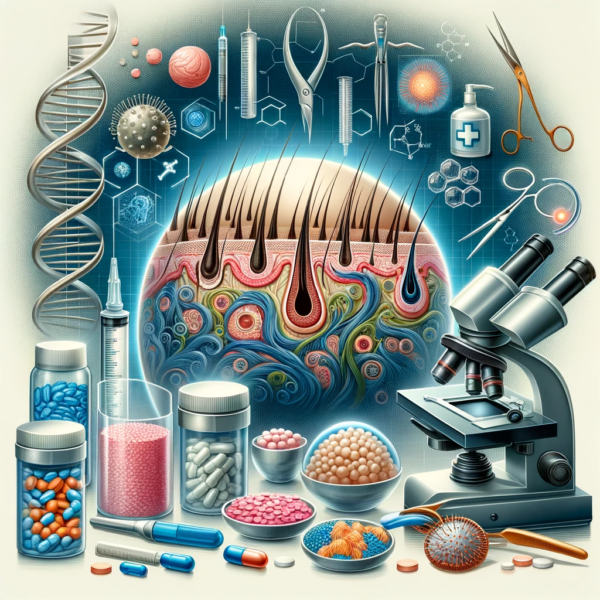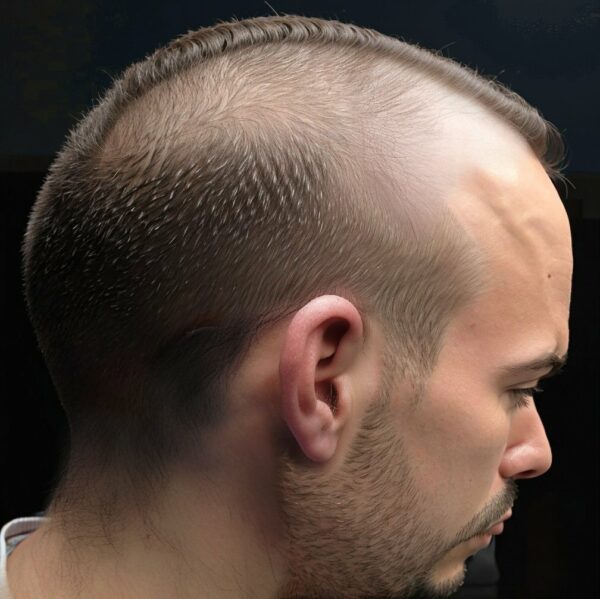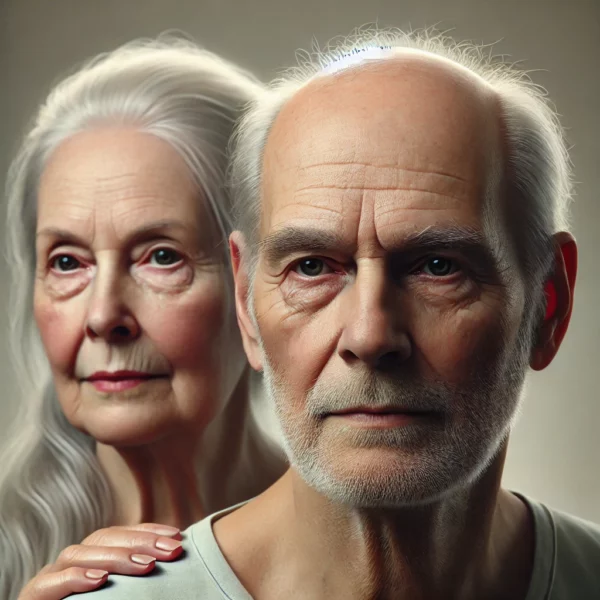Introduction: Pattern hair loss, a common condition impacting millions globally, can profoundly affect an individual’s self-esteem and quality of life (QoL). While the causes of hair loss range from genetic predisposition to environmental factors and health conditions, the advancements in treatment options have been significant in recent years. This article provides an overview of the various hair loss treatment categories, incorporating both traditional and emerging therapies.
1. Pharmacological Treatments: Pharmacological treatments are often the first line of defense against hair loss. Two widely recognized drugs in this category are Minoxidil and Finasteride.
Minoxidil : Applied topically, Minoxidil is effective for both men and women, though only around 50% of users achieve a significant hair growth response. It’s thought to work by widening blood vessels and opening potassium channels, thus allowing more oxygen, blood, and nutrients to the follicle.Finasteride : Used primarily for male pattern hair loss, Finasteride is an oral medication that decreases the production of dihydrotestosterone (DHT), a hormone contributing to hair loss.In addition to the traditional forms of application for Minoxidil and Finasteride, recent developments have seen the emergence of oral Minoxidil and topical applications of Finasteride and Dutasteride . Oral Minoxidil, initially used for treating high blood pressure, has shown some promising results in stimulating hair growth when used in low doses.
On the other hand, topical formulations of Finasteride and Dutasteride, traditionally used orally for hair loss, provide a localized approach to reducing DHT levels in the scalp. These topical solutions are gaining popularity as they potentially minimize systemic side effects while maintaining effectiveness in treating hair loss.
Other drug type treatments are under development for pattern hair loss including; JAK inhibitors, small molecules that target the Wnt signalling pathway, prostaglandin D2 receptor antagonists, anti-androgens, and Fibroblast Growth Factor 5 (FGF5) inhibitors, among other drug treatments.
2. Growth-Factor and Peptide-Based Therapies: Sometimes called “biologic drugs”, Peptide-based therapies are emerging treatments that utilize short chains of amino acids to stimulate hair growth. These peptides can act as growth factors, promoting hair follicle cell proliferation and preventing hair loss. In other instances the peptides are designed to interfere with cell/protein signalling systems in the hair follicle.
Osteopontin and peptides derived from the protein molecule are a focus of research and development at more than one company right now. Potentially these proteins and peptides may be direct stimulators of hair growth.
Peptide based Androgen Receptor (AR) inhibitors are being researched for their potential in directly targeting the androgen receptors in the scalp, which play a crucial role in androgenetic alopecia. They work by interfering with the ability of dihydrotestosterone (DHT) binding to androgen receptors on hair follicle cells.
Researchers are investigating the role of KROX20, a protein associated with nerve development, and SCF (stem cell factor), in hair pigmentation and growth. This could open new avenues for treatments targeting hair follicle stem cells.
Various other peptides derived from fibroblast growth factors and other hair growth promoting proteins have been investigated over the years. Some of these laboratory studies may be brought forward for further development into a clinical treatment in the future.
3. Cell Therapy and Regenerative Medicine: Cell therapy and regenerative medicine represent a cutting-edge approach in treating hair loss.
Stem Cell Therapy : This involves the use of stem cells and similar cells to rejuvenate and regenerate hair follicles.Platelet-Rich Plasma (PRP) Therapy : PRP involves injecting a patient’s own platelets to promote hair growth. The growth factors in platelets can stimulate the hair follicles’ cells into an increased rate of growth and signalling activity.Exosomes : As a part of regenerative medicine, exosomes, which are extracellular vesicles released by cells, are being studied for their potential in promoting hair growth. They may work by delivering growth factors and proteins to hair follicles.In the realm of cell therapy and regenerative medicine, significant advancements have been made in utilizing specific cell types for hair regrowth. Dermal Papilla Cells , located at the base of the hair follicle, play a crucial role in the regulation of hair growth and cycling. Researchers are exploring ways to cultivate these cells and reintroduce them into the scalp to rejuvenate miniaturized hair follicles in androgenetic alopecia. Similarly, Dermal Sheath Cup Cells , which provide support and nourishment to the hair follicle, are being studied for their regenerative capabilities in hair growth. Though it is somewhat speculative right now, some scientists have suggested that dermal papilla cells and/or dermal sheath cup cells have stem cell like properties.
Additionally, Induced Pluripotent Stem Cells (iPSCs) , which are adult cells reprogrammed into an embryonic stem cell-like state, represent a potentially groundbreaking approach to hair loss treatment. These iPSCs have the potential to differentiate into various cell types, including those relevant to hair growth. By harnessing these cells’ ability to transform and proliferate, researchers are aiming to create new hair follicles or repair damaged ones, offering a novel solution to hair loss. The utilization of these cells highlights the move towards more targeted and personalized treatment strategies in combating hair loss, though clinical application is still under rigorous investigation for safety and efficacy.
As well as injecting cells, some companies are looking at how to make exosomes from cells in culture. These cells can be dermal papilla cells, keratinocytes, stem cells, iPSCs, and potentially other cell types may be looked at in the future. The idea is to use the exosomes to promote hair growth by signalling increased activity in the resident hair follicle cells.
Platelet-Rich Plasma (PRP) therapy for hair loss has been around for a long time now. However, improvements are being made in terms of better ways to isolate and activate the platelets, and also ways to improve the consistency of the product.
4. Medical Devices: Low-Level Laser Therapy (LLLT) uses specific wavelengths of light to treat hair loss. It’s believed to enhance cell metabolism and improve blood flow, leading to stimulated hair growth. A wide variety of products are available from different companies and clinics. Some are for home use, while some are designed only for use in a hair clinic.
Microneedling is a procedure where tiny needles are used to create micro-injuries on the scalp. This process is believed to stimulate the body’s wound healing response, potentially leading to increased hair growth when combined with other treatments like minoxidil.
Though this might also go under the cell therapy category, in recent years there has also been the possibility to isolate adipose cells from fat and inject into scalp skin to promote hair growth. The machines to take and process the cells from fat are available from several different companies. The machines are used in hair clinics and take fat from a patient and the cells are injected into the same patient in the clinic within a few hours of processing.
Occasionally there are other medical devices that are the subject of small scale clinical investigations such as ultrasound machines for example. Due to the limited published research on these machines it is hard to know whether such machines will be brought into widespread clinical use for hair loss.
5. Surgical Treatments: For those seeking permanent solutions, surgical treatments like hair transplants are an option.
Follicular Unit Transplantation (FUT) and Follicular Unit Extraction (FUE) are two main types of hair transplant surgeries. FUT involves transplanting a strip of hair-bearing scalp, while FUE involves individual follicle transplantation.6. Herbal and Natural Remedies: Many individuals turn to herbal and natural remedies for hair loss. These include supplements like biotin, as well as herbal extracts like saw palmetto, which may block DHT.
7. Cosmetic Options: Cosmetic solutions like wigs and hairpieces offer non-medical alternatives for managing hair loss.
8. Hormonal Treatments: This category is largely limited to use by women as the side effects of using hormones and their antagonists in men are quite significant. In cases where hair loss in women is due to hormonal disturbances, treatments like spironolactone or cyproterone acetate, which act as androgen blockers, can be effective.
9. Anti-inflammatory treatments: Anti-inflammatory shampoos like those containing ketoconazole can help in managing scalp conditions like dandruff, which can contribute to hair loss. Ketoconazole’s anti-inflammatory and antifungal properties make it useful in treating scalp conditions that can lead to hair thinning.
Right now there is research underway to investigate the potential for using JAK inhibitors to treat hair loss. While JAK inhibitors are anti-inflammatory drugs, they have also been shown to have a direct hair growth promoting effect. Whether the hair growth promoting action can be separated from the anti-inflammatory action, and whether one or both properties are useful for treating pattern hair loss, is under investigation.
Note : It’s important to note that many of these treatments are still in clinical trials or early stages of development, and their efficacy and safety profiles are yet to be fully established. The field of hair loss treatment is rapidly evolving, with ongoing research and clinical trials continually providing new insights and potential therapies. For the latest information on these treatments and their development status, consulting recent scientific publications or clinical trial registries is recommended. Always consult a healthcare professional before starting any treatment for hair loss to understand the potential risks and benefits.
Conclusion: The landscape of hair loss treatments is diverse and continuously evolving. While some treatments focus on stimulating hair growth or transplanting hair, others aim to address the underlying causes of hair loss, such as hormonal imbalances or scalp conditions. The choice of treatment depends on various factors, including the type and extent of hair loss, patient preferences, and tolerance for potential side effects. It’s crucial for individuals facing hair loss to consult with healthcare professionals to choose the most suitable treatment plan, ensuring a tailored approach that maximizes the chances of successful hair regrowth and restoration.
Bibliography
11711645 {11711645:KMKSXAZ3},{11711645:ZPRXZBFI},{11711645:HJRPAP5I},{11711645:Z2J9CCC2},{11711645:7V99BPNG},{11711645:56IJ2Z2A},{11711645:KFAGPPF8},{11711645:XVMNHSS9},{11711645:RBATDQG3},{11711645:EJM7ZESK},{11711645:IGVKJVUE},{11711645:F72BQ5P2},{11711645:BFWZ7TEV},{11711645:2UXM2GTP},{11711645:ZSK778G8},{11711645:JGQWB9JZ},{11711645:FFADQ92N} 1 vancouver 50 date asc 678 https://www.keratin.com/wp-content/plugins/zotpress/ %7B%22status%22%3A%22success%22%2C%22updateneeded%22%3Afalse%2C%22instance%22%3Afalse%2C%22meta%22%3A%7B%22request_last%22%3A0%2C%22request_next%22%3A0%2C%22used_cache%22%3Atrue%7D%2C%22data%22%3A%5B%7B%22key%22%3A%22BFWZ7TEV%22%2C%22library%22%3A%7B%22id%22%3A11711645%7D%2C%22meta%22%3A%7B%22creatorSummary%22%3A%22McElwee%20and%20Shapiro%22%2C%22parsedDate%22%3A%222012-06%22%2C%22numChildren%22%3A0%7D%2C%22bib%22%3A%22%26lt%3Bdiv%20class%3D%26quot%3Bcsl-bib-body%26quot%3B%20style%3D%26quot%3Bline-height%3A%201.35%3B%20%26quot%3B%26gt%3B%5Cn%20%20%26lt%3Bdiv%20class%3D%26quot%3Bcsl-entry%26quot%3B%20style%3D%26quot%3Bclear%3A%20left%3B%20%26quot%3B%26gt%3B%5Cn%20%20%20%20%26lt%3Bdiv%20class%3D%26quot%3Bcsl-left-margin%26quot%3B%20style%3D%26quot%3Bfloat%3A%20left%3B%20padding-right%3A%200.5em%3B%20text-align%3A%20right%3B%20width%3A%201em%3B%26quot%3B%26gt%3B1.%26lt%3B%5C%2Fdiv%26gt%3B%26lt%3Bdiv%20class%3D%26quot%3Bcsl-right-inline%26quot%3B%20style%3D%26quot%3Bmargin%3A%200%20.4em%200%201.5em%3B%26quot%3B%26gt%3BMcElwee%20KJ%2C%20Shapiro%20JS.%20Promising%20therapies%20for%20treating%20and%5C%2For%20preventing%20androgenic%20alopecia.%20Skin%20Therapy%20Lett.%202012%20Jun%3B17%286%29%3A1%26%23x2013%3B4.%26lt%3B%5C%2Fdiv%26gt%3B%5Cn%20%20%20%26lt%3B%5C%2Fdiv%26gt%3B%5Cn%26lt%3B%5C%2Fdiv%26gt%3B%22%2C%22data%22%3A%7B%22itemType%22%3A%22journalArticle%22%2C%22title%22%3A%22Promising%20therapies%20for%20treating%20and%5C%2For%20preventing%20androgenic%20alopecia%22%2C%22creators%22%3A%5B%7B%22creatorType%22%3A%22author%22%2C%22firstName%22%3A%22K.%20J.%22%2C%22lastName%22%3A%22McElwee%22%7D%2C%7B%22creatorType%22%3A%22author%22%2C%22firstName%22%3A%22J.%20S.%22%2C%22lastName%22%3A%22Shapiro%22%7D%5D%2C%22abstractNote%22%3A%22%5Cu416e%5Cu6472%5Cu6f67%5Cu656e%5Cu6574%5Cu6963%5Cu2061%5Cu6c6f%5Cu7065%5Cu6369%5Cu6120%5Cu2841%5Cu4741%5Cu2920%5Cu6d61%5Cu7920%5Cu6166%5Cu6665%5Cu6374%5Cu2075%5Cu7020%5Cu746f%5Cu2037%5Cu3025%5Cu206f%5Cu6620%5Cu6d65%5Cu6e20%5Cu616e%5Cu6420%5Cu3430%5Cu2520%5Cu6f66%5Cu2077%5Cu6f6d%5Cu656e%5Cu2061%5Cu7420%5Cu736f%5Cu6d65%5Cu2070%5Cu6f69%5Cu6e74%5Cu2069%5Cu6e20%5Cu7468%5Cu6569%5Cu7220%5Cu6c69%5Cu6665%5Cu7469%5Cu6d65%5Cu2e20%5Cu5768%5Cu696c%5Cu6520%5Cu6d65%5Cu6e20%5Cu7479%5Cu7069%5Cu6361%5Cu6c6c%5Cu7920%5Cu7072%5Cu6573%5Cu656e%5Cu7420%5Cu7769%5Cu7468%5Cu2061%5Cu2064%5Cu6973%5Cu7469%5Cu6e63%5Cu7469%5Cu7665%5Cu2061%5Cu6c6f%5Cu7065%5Cu6369%5Cu6120%5Cu7061%5Cu7474%5Cu6572%5Cu6e20%5Cu696e%5Cu766f%5Cu6c76%5Cu696e%5Cu6720%5Cu6861%5Cu6972%5Cu6c69%5Cu6e65%5Cu2072%5Cu6563%5Cu6573%5Cu7369%5Cu6f6e%5Cu2061%5Cu6e64%5Cu2076%5Cu6572%5Cu7465%5Cu7820%5Cu6261%5Cu6c64%5Cu696e%5Cu672c%5Cu2077%5Cu6f6d%5Cu656e%5Cu206e%5Cu6f72%5Cu6d61%5Cu6c6c%5Cu7920%5Cu6578%5Cu6869%5Cu6269%5Cu7420%5Cu6120%5Cu6469%5Cu6666%5Cu7573%5Cu6520%5Cu6861%5Cu6972%5Cu2074%5Cu6869%5Cu6e6e%5Cu696e%5Cu6720%5Cu6f76%5Cu6572%5Cu2074%5Cu6865%5Cu2074%5Cu6f70%5Cu206f%5Cu6620%5Cu7468%5Cu6569%5Cu7220%5Cu7363%5Cu616c%5Cu7073%5Cu2e20%5Cu5468%5Cu6520%5Cu7472%5Cu6561%5Cu746d%5Cu656e%5Cu7420%5Cu7374%5Cu616e%5Cu6461%5Cu7264%5Cu2069%5Cu6e20%5Cu6465%5Cu726d%5Cu6174%5Cu6f6c%5Cu6f67%5Cu7920%5Cu636c%5Cu696e%5Cu6963%5Cu7320%5Cu636f%5Cu6e74%5Cu696e%5Cu7565%5Cu7320%5Cu746f%5Cu2062%5Cu6520%5Cu6d69%5Cu6e6f%5Cu7869%5Cu6469%5Cu6c20%5Cu616e%5Cu6420%5Cu6669%5Cu6e61%5Cu7374%5Cu6572%5Cu6964%5Cu6520%5Cu7769%5Cu7468%5Cu2068%5Cu6169%5Cu7220%5Cu7472%5Cu616e%5Cu7370%5Cu6c61%5Cu6e74%5Cu6174%5Cu696f%5Cu6e20%5Cu6173%5Cu2061%5Cu2073%5Cu7572%5Cu6769%5Cu6361%5Cu6c20%5Cu6f70%5Cu7469%5Cu6f6e%5Cu2e20%5Cu4865%5Cu7265%5Cu2077%5Cu6520%5Cu6272%5Cu6965%5Cu666c%5Cu7920%5Cu7265%5Cu7669%5Cu6577%5Cu2063%5Cu7572%5Cu7265%5Cu6e74%5Cu2074%5Cu6865%5Cu7261%5Cu7065%5Cu7574%5Cu6963%5Cu206f%5Cu7074%5Cu696f%5Cu6e73%5Cu2061%5Cu6e64%5Cu2074%5Cu7265%5Cu6174%5Cu6d65%5Cu6e74%5Cu7320%5Cu756e%5Cu6465%5Cu7220%5Cu6163%5Cu7469%5Cu7665%5Cu2069%5Cu6e76%5Cu6573%5Cu7469%5Cu6761%5Cu7469%5Cu6f6e%5Cu2e20%5Cu4475%5Cu7461%5Cu7374%5Cu6572%5Cu6964%5Cu6520%5Cu616e%5Cu6420%5Cu6b65%5Cu746f%5Cu636f%5Cu6e61%5Cu7a6f%5Cu6c65%5Cu2061%5Cu7265%5Cu2061%5Cu6c73%5Cu6f20%5Cu656d%5Cu706c%5Cu6f79%5Cu6564%5Cu2066%5Cu6f72%5Cu2041%5Cu4741%5Cu2c20%5Cu7768%5Cu696c%5Cu6520%5Cu7072%5Cu6f73%5Cu7461%5Cu676c%5Cu616e%5Cu6469%5Cu6e20%5Cu616e%5Cu616c%5Cu6f67%5Cu7565%5Cu7320%5Cu6c61%5Cu7461%5Cu6e6f%5Cu7072%5Cu6f73%5Cu7420%5Cu616e%5Cu6420%5Cu6269%5Cu6d61%5Cu746f%5Cu7072%5Cu6f73%5Cu7420%5Cu6172%5Cu6520%5Cu6265%5Cu696e%5Cu6720%5Cu696e%5Cu7665%5Cu7374%5Cu6967%5Cu6174%5Cu6564%5Cu2066%5Cu6f72%5Cu2074%5Cu6865%5Cu6972%5Cu2068%5Cu6169%5Cu7220%5Cu6772%5Cu6f77%5Cu7468%5Cu2070%5Cu726f%5Cu6d6f%5Cu7469%5Cu6e67%5Cu2070%5Cu6f74%5Cu656e%5Cu7469%5Cu616c%5Cu2e20%5Cu4c61%5Cu7365%5Cu7220%5Cu7472%5Cu6561%5Cu746d%5Cu656e%5Cu7420%5Cu7072%5Cu6f64%5Cu7563%5Cu7473%5Cu2061%5Cu7661%5Cu696c%5Cu6162%5Cu6c65%5Cu2066%5Cu6f72%5Cu2068%5Cu6f6d%5Cu6520%5Cu7573%5Cu6520%5Cu616e%5Cu6420%5Cu6672%5Cu6f6d%5Cu2063%5Cu6f73%5Cu6d65%5Cu7469%5Cu6320%5Cu636c%5Cu696e%5Cu6963%5Cu7320%5Cu6172%5Cu6520%5Cu6265%5Cu636f%5Cu6d69%5Cu6e67%5Cu2070%5Cu6f70%5Cu756c%5Cu6172%5Cu2e20%5Cu496e%5Cu2074%5Cu6865%5Cu2066%5Cu7574%5Cu7572%5Cu652c%5Cu206e%5Cu6577%5Cu2063%5Cu656c%5Cu6c20%5Cu6d65%5Cu6469%5Cu6174%5Cu6564%5Cu2074%5Cu7265%5Cu6174%5Cu6d65%5Cu6e74%5Cu2061%5Cu7070%5Cu726f%5Cu6163%5Cu6865%5Cu7320%5Cu6d61%5Cu7920%5Cu6265%5Cu2061%5Cu7661%5Cu696c%5Cu6162%5Cu6c65%5Cu2066%5Cu6f72%5Cu2041%5Cu4741%5Cu2e20%5Cu5768%5Cu696c%5Cu6520%5Cu7468%5Cu6572%5Cu6520%5Cu6172%5Cu6520%5Cu6120%5Cu6e75%5Cu6d62%5Cu6572%5Cu206f%5Cu6620%5Cu706f%5Cu7465%5Cu6e74%5Cu6961%5Cu6c20%5Cu7472%5Cu6561%5Cu746d%5Cu656e%5Cu7420%5Cu6f70%5Cu7469%5Cu6f6e%5Cu732c%5Cu2067%5Cu6f6f%5Cu6420%5Cu636c%5Cu696e%5Cu6963%5Cu616c%5Cu2074%5Cu7269%5Cu616c%5Cu2064%5Cu6174%5Cu6120%5Cu7072%5Cu6f76%5Cu696e%5Cu6720%5Cu6861%5Cu6972%5Cu2067%5Cu726f%5Cu7774%5Cu6820%5Cu6566%5Cu6669%5Cu6361%5Cu6379%5Cu2069%5Cu7320%5Cu6c69%5Cu6d69%5Cu7465%5Cu642e%22%2C%22date%22%3A%222012-06%22%2C%22language%22%3A%22eng%22%2C%22DOI%22%3A%22%22%2C%22ISSN%22%3A%221201-5989%22%2C%22url%22%3A%22%22%2C%22collections%22%3A%5B%2236SETC4Q%22%5D%2C%22dateModified%22%3A%222023-12-14T17%3A34%3A01Z%22%7D%7D%2C%7B%22key%22%3A%22KFAGPPF8%22%2C%22library%22%3A%7B%22id%22%3A11711645%7D%2C%22meta%22%3A%7B%22creatorSummary%22%3A%22Guo%20et%20al.%22%2C%22parsedDate%22%3A%222017-08%22%2C%22numChildren%22%3A0%7D%2C%22bib%22%3A%22%26lt%3Bdiv%20class%3D%26quot%3Bcsl-bib-body%26quot%3B%20style%3D%26quot%3Bline-height%3A%201.35%3B%20%26quot%3B%26gt%3B%5Cn%20%20%26lt%3Bdiv%20class%3D%26quot%3Bcsl-entry%26quot%3B%20style%3D%26quot%3Bclear%3A%20left%3B%20%26quot%3B%26gt%3B%5Cn%20%20%20%20%26lt%3Bdiv%20class%3D%26quot%3Bcsl-left-margin%26quot%3B%20style%3D%26quot%3Bfloat%3A%20left%3B%20padding-right%3A%200.5em%3B%20text-align%3A%20right%3B%20width%3A%201em%3B%26quot%3B%26gt%3B1.%26lt%3B%5C%2Fdiv%26gt%3B%26lt%3Bdiv%20class%3D%26quot%3Bcsl-right-inline%26quot%3B%20style%3D%26quot%3Bmargin%3A%200%20.4em%200%201.5em%3B%26quot%3B%26gt%3BGuo%20H%2C%20Gao%20WV%2C%20Endo%20H%2C%20McElwee%20KJ.%20Experimental%20and%20early%20investigational%20drugs%20for%20androgenetic%20alopecia.%20Expert%20Opin%20Investig%20Drugs.%202017%20Aug%3B26%288%29%3A917%26%23x2013%3B32.%26lt%3B%5C%2Fdiv%26gt%3B%5Cn%20%20%20%26lt%3B%5C%2Fdiv%26gt%3B%5Cn%26lt%3B%5C%2Fdiv%26gt%3B%22%2C%22data%22%3A%7B%22itemType%22%3A%22journalArticle%22%2C%22title%22%3A%22Experimental%20and%20early%20investigational%20drugs%20for%20androgenetic%20alopecia%22%2C%22creators%22%3A%5B%7B%22creatorType%22%3A%22author%22%2C%22firstName%22%3A%22Hongwei%22%2C%22lastName%22%3A%22Guo%22%7D%2C%7B%22creatorType%22%3A%22author%22%2C%22firstName%22%3A%22Wendi%20Victor%22%2C%22lastName%22%3A%22Gao%22%7D%2C%7B%22creatorType%22%3A%22author%22%2C%22firstName%22%3A%22Hiromi%22%2C%22lastName%22%3A%22Endo%22%7D%2C%7B%22creatorType%22%3A%22author%22%2C%22firstName%22%3A%22Kevin%20John%22%2C%22lastName%22%3A%22McElwee%22%7D%5D%2C%22abstractNote%22%3A%22%5Cu5472%5Cu6561%5Cu746d%5Cu656e%5Cu7473%5Cu2066%5Cu6f72%5Cu2061%5Cu6e64%5Cu726f%5Cu6765%5Cu6e65%5Cu7469%5Cu6320%5Cu616c%5Cu6f70%5Cu6563%5Cu6961%5Cu2063%5Cu6f6e%5Cu7374%5Cu6974%5Cu7574%5Cu6520%5Cu6120%5Cu6d75%5Cu6c74%5Cu692d%5Cu6269%5Cu6c6c%5Cu696f%5Cu6e2d%5Cu646f%5Cu6c6c%5Cu6172%5Cu2069%5Cu6e64%5Cu7573%5Cu7472%5Cu792c%5Cu2068%5Cu6f77%5Cu6576%5Cu6572%5Cu2c20%5Cu6375%5Cu7272%5Cu656e%5Cu746c%5Cu7920%5Cu6176%5Cu6169%5Cu6c61%5Cu626c%5Cu6520%5Cu7468%5Cu6572%5Cu6170%5Cu6575%5Cu7469%5Cu6320%5Cu6f70%5Cu7469%5Cu6f6e%5Cu7320%5Cu6861%5Cu7665%5Cu2076%5Cu6172%5Cu6961%5Cu626c%5Cu6520%5Cu6566%5Cu6669%5Cu6361%5Cu6379%5Cu2e20%5Cu436f%5Cu6e73%5Cu6571%5Cu7565%5Cu6e74%5Cu6c79%5Cu2c20%5Cu696e%5Cu2072%5Cu6563%5Cu656e%5Cu7420%5Cu7965%5Cu6172%5Cu7320%5Cu736d%5Cu616c%5Cu6c20%5Cu6269%5Cu6f74%5Cu6563%5Cu686e%5Cu6f6c%5Cu6f67%5Cu7920%5Cu636f%5Cu6d70%5Cu616e%5Cu6965%5Cu7320%5Cu616e%5Cu6420%5Cu6163%5Cu6164%5Cu656d%5Cu6963%5Cu2072%5Cu6573%5Cu6561%5Cu7263%5Cu6820%5Cu6c61%5Cu626f%5Cu7261%5Cu746f%5Cu7269%5Cu6573%5Cu2068%5Cu6176%5Cu6520%5Cu6265%5Cu6775%5Cu6e20%5Cu746f%5Cu2069%5Cu6e76%5Cu6573%5Cu7469%5Cu6761%5Cu7465%5Cu206e%5Cu6577%5Cu206f%5Cu7220%5Cu696d%5Cu7072%5Cu6f76%5Cu6564%5Cu2074%5Cu7265%5Cu6174%5Cu6d65%5Cu6e74%5Cu206d%5Cu6574%5Cu686f%5Cu6473%5Cu2e20%5Cu5265%5Cu7365%5Cu6172%5Cu6368%5Cu2061%5Cu6e64%5Cu2064%5Cu6576%5Cu656c%5Cu6f70%5Cu6d65%5Cu6e74%5Cu2061%5Cu7070%5Cu726f%5Cu6163%5Cu6865%5Cu7320%5Cu696e%5Cu636c%5Cu7564%5Cu6520%5Cu696d%5Cu7072%5Cu6f76%5Cu6564%5Cu2066%5Cu6f72%5Cu6d75%5Cu6c61%5Cu7469%5Cu6f6e%5Cu7320%5Cu616e%5Cu6420%5Cu6d6f%5Cu6465%5Cu7320%5Cu6f66%5Cu2061%5Cu7070%5Cu6c69%5Cu6361%5Cu7469%5Cu6f6e%5Cu2066%5Cu6f72%5Cu2063%5Cu7572%5Cu7265%5Cu6e74%5Cu2064%5Cu7275%5Cu6773%5Cu2c20%5Cu6e65%5Cu7720%5Cu6472%5Cu7567%5Cu2064%5Cu6576%5Cu656c%5Cu6f70%5Cu6d65%5Cu6e74%5Cu2c20%5Cu6465%5Cu7665%5Cu6c6f%5Cu706d%5Cu656e%5Cu7420%5Cu6f66%5Cu2063%5Cu656c%5Cu6c2d%5Cu6261%5Cu7365%5Cu6420%5Cu7472%5Cu6561%5Cu746d%5Cu656e%5Cu7473%5Cu2c20%5Cu616e%5Cu6420%5Cu6d65%5Cu6469%5Cu6361%5Cu6c20%5Cu6465%5Cu7669%5Cu6365%5Cu7320%5Cu666f%5Cu7220%5Cu6d6f%5Cu6475%5Cu6c61%5Cu7469%5Cu6f6e%5Cu206f%5Cu6620%5Cu6861%5Cu6972%5Cu2067%5Cu726f%5Cu7774%5Cu682e%5Cu2041%5Cu7265%5Cu6173%5Cu2063%5Cu6f76%5Cu6572%5Cu6564%5Cu3a20%5Cu4865%5Cu7265%5Cu2077%5Cu6520%5Cu7265%5Cu7669%5Cu6577%5Cu2074%5Cu6865%5Cu2065%5Cu7373%5Cu656e%5Cu7469%5Cu616c%5Cu2070%5Cu6174%5Cu6877%5Cu6179%5Cu7320%5Cu6f66%5Cu2061%5Cu6e64%5Cu726f%5Cu6765%5Cu6e65%5Cu7469%5Cu6320%5Cu616c%5Cu6f70%5Cu6563%5Cu6961%5Cu2070%5Cu6174%5Cu686f%5Cu6765%5Cu6e65%5Cu7369%5Cu7320%5Cu616e%5Cu6420%5Cu636f%5Cu6c6c%5Cu6174%5Cu6520%5Cu7468%5Cu6520%5Cu6375%5Cu7272%5Cu656e%5Cu7420%5Cu616e%5Cu6420%5Cu656d%5Cu6572%5Cu6769%5Cu6e67%5Cu2074%5Cu6865%5Cu7261%5Cu7065%5Cu7574%5Cu6963%5Cu2073%5Cu7472%5Cu6174%5Cu6567%5Cu6965%5Cu7320%5Cu7573%5Cu696e%5Cu6720%5Cu6a6f%5Cu7572%5Cu6e61%5Cu6c20%5Cu7075%5Cu626c%5Cu6963%5Cu6174%5Cu696f%5Cu6e73%5Cu2064%5Cu6174%5Cu6162%5Cu6173%5Cu6573%5Cu2061%5Cu6e64%5Cu2063%5Cu6c69%5Cu6e69%5Cu6361%5Cu6c20%5Cu7472%5Cu6961%5Cu6c73%5Cu2064%5Cu6174%5Cu6162%5Cu6173%5Cu6573%5Cu2074%5Cu6f20%5Cu6761%5Cu7468%5Cu6572%5Cu2069%5Cu6e66%5Cu6f72%5Cu6d61%5Cu7469%5Cu6f6e%5Cu2061%5Cu626f%5Cu7574%5Cu2061%5Cu6374%5Cu6976%5Cu6520%5Cu7265%5Cu7365%5Cu6172%5Cu6368%5Cu206f%5Cu6e20%5Cu6e65%5Cu7720%5Cu7472%5Cu6561%5Cu746d%5Cu656e%5Cu7473%5Cu2e20%5Cu4578%5Cu7065%5Cu7274%5Cu206f%5Cu7069%5Cu6e69%5Cu6f6e%5Cu3a20%5Cu5765%5Cu2070%5Cu726f%5Cu706f%5Cu7365%5Cu2074%5Cu6861%5Cu7420%5Cu746f%5Cu7069%5Cu6361%5Cu6c6c%5Cu7920%5Cu6170%5Cu706c%5Cu6965%5Cu6420%5Cu6d65%5Cu6469%5Cu6361%5Cu7469%5Cu6f6e%5Cu732c%5Cu206f%5Cu7220%5Cu696e%5Cu7472%5Cu612d%5Cu6465%5Cu726d%5Cu616c%5Cu2069%5Cu6e6a%5Cu6563%5Cu7465%5Cu6420%5Cu6f72%5Cu2069%5Cu6d70%5Cu6c61%5Cu6e74%5Cu6564%5Cu206d%5Cu6174%5Cu6572%5Cu6961%5Cu6c73%5Cu2c20%5Cu6172%5Cu6520%5Cu7072%5Cu6566%5Cu6572%5Cu6162%5Cu6c65%5Cu2074%5Cu7265%5Cu6174%5Cu6d65%5Cu6e74%5Cu206d%5Cu6f64%5Cu616c%5Cu6974%5Cu6965%5Cu732c%5Cu206d%5Cu696e%5Cu696d%5Cu697a%5Cu696e%5Cu6720%5Cu7369%5Cu6465%5Cu2065%5Cu6666%5Cu6563%5Cu7420%5Cu7269%5Cu736b%5Cu7320%5Cu6173%5Cu2063%5Cu6f6d%5Cu7061%5Cu7265%5Cu6420%5Cu746f%5Cu2073%5Cu7973%5Cu7465%5Cu6d69%5Cu6361%5Cu6c6c%5Cu7920%5Cu6170%5Cu706c%5Cu6965%5Cu6420%5Cu7472%5Cu6561%5Cu746d%5Cu656e%5Cu7473%5Cu2e20%5Cu4576%5Cu6964%5Cu656e%5Cu6365%5Cu2069%5Cu6e20%5Cu7375%5Cu7070%5Cu6f72%5Cu7420%5Cu6f66%5Cu206e%5Cu6577%5Cu2074%5Cu7265%5Cu6174%5Cu6d65%5Cu6e74%5Cu7320%5Cu6973%5Cu206c%5Cu696d%5Cu6974%5Cu6564%5Cu2e20%5Cu486f%5Cu7765%5Cu7665%5Cu722c%5Cu2077%5Cu6520%5Cu7375%5Cu6767%5Cu6573%5Cu7420%5Cu7468%5Cu6572%5Cu6170%5Cu6575%5Cu7469%5Cu6373%5Cu2077%5Cu6869%5Cu6368%5Cu2072%5Cu6576%5Cu6572%5Cu7365%5Cu2074%5Cu6865%5Cu2061%5Cu6e64%5Cu726f%5Cu6765%5Cu6e2d%5Cu6472%5Cu6976%5Cu656e%5Cu2069%5Cu6e68%5Cu6962%5Cu6974%5Cu696f%5Cu6e20%5Cu6f66%5Cu2068%5Cu6169%5Cu7220%5Cu666f%5Cu6c6c%5Cu6963%5Cu6c65%5Cu2073%5Cu6967%5Cu6e61%5Cu6c69%5Cu6e67%5Cu2070%5Cu6174%5Cu6877%5Cu6179%5Cu732c%5Cu2073%5Cu7563%5Cu6820%5Cu6173%5Cu2070%5Cu726f%5Cu7374%5Cu6167%5Cu6c61%5Cu6e64%5Cu696e%5Cu2061%5Cu6e61%5Cu6c6f%5Cu6773%5Cu2061%5Cu6e64%5Cu2061%5Cu6e74%5Cu6167%5Cu6f6e%5Cu6973%5Cu7473%5Cu2c20%5Cu706c%5Cu6174%5Cu656c%5Cu6574%5Cu2d72%5Cu6963%5Cu6820%5Cu706c%5Cu6173%5Cu6d61%5Cu2028%5Cu5052%5Cu5029%5Cu2c20%5Cu7072%5Cu6f6d%5Cu6f74%5Cu696f%5Cu6e20%5Cu6f66%5Cu2073%5Cu6b69%5Cu6e20%5Cu616e%5Cu6769%5Cu6f67%5Cu656e%5Cu6573%5Cu6973%5Cu2061%5Cu6e64%5Cu2070%5Cu6572%5Cu6675%5Cu7369%5Cu6f6e%5Cu2c20%5Cu696e%5Cu7472%5Cu6f64%5Cu7563%5Cu7469%5Cu6f6e%5Cu206f%5Cu6620%5Cu7072%5Cu6f67%5Cu656e%5Cu6974%5Cu6f72%5Cu2063%5Cu656c%5Cu6c73%5Cu2066%5Cu6f72%5Cu2068%5Cu6169%5Cu7220%5Cu7265%5Cu6765%5Cu6e65%5Cu7261%5Cu7469%5Cu6f6e%5Cu2c20%5Cu616e%5Cu6420%5Cu6d6f%5Cu7265%5Cu2065%5Cu6666%5Cu6563%5Cu7469%5Cu7665%5Cu2077%5Cu6179%5Cu7320%5Cu6f66%5Cu2074%5Cu7261%5Cu6e73%5Cu706c%5Cu616e%5Cu7469%5Cu6e67%5Cu2068%5Cu6169%5Cu722c%5Cu2061%5Cu7265%5Cu2074%5Cu6865%5Cu206c%5Cu696b%5Cu656c%5Cu7920%5Cu6e65%5Cu6172%5Cu2066%5Cu7574%5Cu7572%5Cu6520%5Cu6469%5Cu7265%5Cu6374%5Cu696f%5Cu6e20%5Cu6f66%5Cu2061%5Cu6e64%5Cu726f%5Cu6765%5Cu6e65%5Cu7469%5Cu6320%5Cu616c%5Cu6f70%5Cu6563%5Cu6961%5Cu2074%5Cu7265%5Cu6174%5Cu6d65%5Cu6e74%5Cu2064%5Cu6576%5Cu656c%5Cu6f70%5Cu6d65%5Cu6e74%3F%22%2C%22date%22%3A%222017-08%22%2C%22language%22%3A%22eng%22%2C%22DOI%22%3A%2210.1080%5C%2F13543784.2017.1353598%22%2C%22ISSN%22%3A%221744-7658%22%2C%22url%22%3A%22%22%2C%22collections%22%3A%5B%2236SETC4Q%22%5D%2C%22dateModified%22%3A%222023-12-14T17%3A33%3A48Z%22%7D%7D%2C%7B%22key%22%3A%22FFADQ92N%22%2C%22library%22%3A%7B%22id%22%3A11711645%7D%2C%22meta%22%3A%7B%22creatorSummary%22%3A%22Ocampo-Garza%20et%20al.%22%2C%22parsedDate%22%3A%222019-03%22%2C%22numChildren%22%3A0%7D%2C%22bib%22%3A%22%26lt%3Bdiv%20class%3D%26quot%3Bcsl-bib-body%26quot%3B%20style%3D%26quot%3Bline-height%3A%201.35%3B%20%26quot%3B%26gt%3B%5Cn%20%20%26lt%3Bdiv%20class%3D%26quot%3Bcsl-entry%26quot%3B%20style%3D%26quot%3Bclear%3A%20left%3B%20%26quot%3B%26gt%3B%5Cn%20%20%20%20%26lt%3Bdiv%20class%3D%26quot%3Bcsl-left-margin%26quot%3B%20style%3D%26quot%3Bfloat%3A%20left%3B%20padding-right%3A%200.5em%3B%20text-align%3A%20right%3B%20width%3A%201em%3B%26quot%3B%26gt%3B1.%26lt%3B%5C%2Fdiv%26gt%3B%26lt%3Bdiv%20class%3D%26quot%3Bcsl-right-inline%26quot%3B%20style%3D%26quot%3Bmargin%3A%200%20.4em%200%201.5em%3B%26quot%3B%26gt%3BOcampo-Garza%20J%2C%20Griggs%20J%2C%20Tosti%20A.%20New%20drugs%20under%20investigation%20for%20the%20treatment%20of%20alopecias.%20Expert%20Opin%20Investig%20Drugs.%202019%20Mar%3B28%283%29%3A275%26%23x2013%3B84.%26lt%3B%5C%2Fdiv%26gt%3B%5Cn%20%20%20%26lt%3B%5C%2Fdiv%26gt%3B%5Cn%26lt%3B%5C%2Fdiv%26gt%3B%22%2C%22data%22%3A%7B%22itemType%22%3A%22journalArticle%22%2C%22title%22%3A%22New%20drugs%20under%20investigation%20for%20the%20treatment%20of%20alopecias%22%2C%22creators%22%3A%5B%7B%22creatorType%22%3A%22author%22%2C%22firstName%22%3A%22Jorge%22%2C%22lastName%22%3A%22Ocampo-Garza%22%7D%2C%7B%22creatorType%22%3A%22author%22%2C%22firstName%22%3A%22Jacob%22%2C%22lastName%22%3A%22Griggs%22%7D%2C%7B%22creatorType%22%3A%22author%22%2C%22firstName%22%3A%22Antonella%22%2C%22lastName%22%3A%22Tosti%22%7D%5D%2C%22abstractNote%22%3A%22%5Cu494e%5Cu5452%5Cu4f44%5Cu5543%5Cu5449%5Cu4f4e%5Cu3a20%5Cu416c%5Cu6f70%5Cu6563%5Cu6961%5Cu2069%5Cu7320%5Cu6120%5Cu7665%5Cu7279%5Cu2063%5Cu6f6d%5Cu6d6f%5Cu6e20%5Cu636f%5Cu6d70%5Cu6c61%5Cu696e%5Cu7420%5Cu696e%5Cu206d%5Cu6564%5Cu6963%5Cu616c%5Cu2070%5Cu7261%5Cu6374%5Cu6963%5Cu652c%5Cu2077%5Cu6869%5Cu6368%5Cu2075%5Cu7375%5Cu616c%5Cu6c79%5Cu2068%5Cu6173%5Cu2061%5Cu206c%5Cu6172%5Cu6765%5Cu2070%5Cu7379%5Cu6368%5Cu6f6c%5Cu6f67%5Cu6963%5Cu616c%5Cu2069%5Cu6d70%5Cu6163%5Cu7420%5Cu696e%5Cu2070%5Cu6174%5Cu6965%5Cu6e74%5Cu732e%5Cu2054%5Cu7265%5Cu6174%5Cu6d65%5Cu6e74%5Cu206f%5Cu6620%5Cu616c%5Cu6f70%5Cu6563%5Cu6961%5Cu2069%5Cu7320%5Cu6f66%5Cu7465%5Cu6e20%5Cu6469%5Cu6666%5Cu6963%5Cu756c%5Cu7420%5Cu616e%5Cu6420%5Cu6672%5Cu7573%5Cu7472%5Cu6174%5Cu696e%5Cu6720%5Cu666f%5Cu7220%5Cu7061%5Cu7469%5Cu656e%5Cu7473%5Cu2061%5Cu6e64%5Cu2063%5Cu6c69%5Cu6e69%5Cu6369%5Cu616e%5Cu7320%5Cu6f77%5Cu696e%5Cu6720%5Cu746f%5Cu2074%5Cu6865%5Cu2073%5Cu6c6f%5Cu7720%5Cu6772%5Cu6f77%5Cu7468%5Cu2072%5Cu6174%5Cu6520%5Cu6f66%5Cu2074%5Cu6865%5Cu2068%5Cu6169%5Cu722c%5Cu206c%5Cu6f6e%5Cu6720%5Cu7472%5Cu6561%5Cu746d%5Cu656e%5Cu7420%5Cu7465%5Cu726d%5Cu732c%5Cu206c%5Cu696d%5Cu6974%5Cu6564%5Cu2065%5Cu6666%5Cu6963%5Cu6163%5Cu792c%5Cu2061%5Cu6e64%5Cu2070%5Cu6f73%5Cu7369%5Cu626c%5Cu6520%5Cu6164%5Cu7665%5Cu7273%5Cu6520%5Cu7369%5Cu6465%5Cu2065%5Cu6666%5Cu6563%5Cu7473%5Cu2e0a%5Cu4152%5Cu4541%5Cu5320%5Cu434f%5Cu5645%5Cu5245%5Cu443a%5Cu2054%5Cu6869%5Cu7320%5Cu7061%5Cu7065%5Cu7220%5Cu7265%5Cu7669%5Cu6577%5Cu7320%5Cu7468%5Cu6520%5Cu6e65%5Cu7720%5Cu616e%5Cu6420%5Cu656d%5Cu6572%5Cu6769%5Cu6e67%5Cu2074%5Cu7265%5Cu6174%5Cu6d65%5Cu6e74%5Cu7320%5Cu666f%5Cu7220%5Cu7477%5Cu6f20%5Cu6f66%5Cu2074%5Cu6865%5Cu206d%5Cu6f73%5Cu7420%5Cu636f%5Cu6d6d%5Cu6f6e%5Cu2066%5Cu6f72%5Cu6d73%5Cu206f%5Cu6620%5Cu616c%5Cu6f70%5Cu6563%5Cu6961%5Cu2c20%5Cu6b6e%5Cu6f77%5Cu6e20%5Cu6173%5Cu2061%5Cu6e64%5Cu726f%5Cu6765%5Cu6e65%5Cu7469%5Cu6320%5Cu616c%5Cu6f70%5Cu6563%5Cu6961%5Cu2061%5Cu6e64%5Cu2061%5Cu6c6f%5Cu7065%5Cu6369%5Cu6120%5Cu6172%5Cu6561%5Cu7461%5Cu2e20%5Cu4120%5Cu6c69%5Cu7465%5Cu7261%5Cu7475%5Cu7265%5Cu2073%5Cu6561%5Cu7263%5Cu6820%5Cu6f66%5Cu2050%5Cu7562%5Cu4d65%5Cu642f%5Cu4d45%5Cu444c%5Cu494e%5Cu4520%5Cu616e%5Cu6420%5Cu436c%5Cu696e%5Cu6963%5Cu616c%5Cu5472%5Cu6961%5Cu6c2e%5Cu676f%5Cu7620%5Cu7761%5Cu7320%5Cu7065%5Cu7266%5Cu6f72%5Cu6d65%5Cu6420%5Cu746f%5Cu2067%5Cu6174%5Cu6865%5Cu7220%5Cu696e%5Cu666f%5Cu726d%5Cu6174%5Cu696f%5Cu6e20%5Cu6162%5Cu6f75%5Cu7420%5Cu6163%5Cu7469%5Cu7665%5Cu2072%5Cu6573%5Cu6561%5Cu7263%5Cu6820%5Cu6f6e%5Cu206e%5Cu6577%5Cu2074%5Cu7265%5Cu6174%5Cu6d65%5Cu6e74%5Cu7320%5Cu666f%5Cu7220%5Cu616c%5Cu6f70%5Cu6563%5Cu6961%5Cu732e%5Cu2057%5Cu6562%5Cu7369%5Cu7465%5Cu7320%5Cu6f66%5Cu2063%5Cu6f6d%5Cu7061%5Cu6e69%5Cu6573%5Cu2073%5Cu706f%5Cu6e73%5Cu6f72%5Cu696e%5Cu6720%5Cu636c%5Cu696e%5Cu6963%5Cu616c%5Cu2074%5Cu7269%5Cu616c%5Cu7320%5Cu7765%5Cu7265%5Cu2061%5Cu6c73%5Cu6f20%5Cu7365%5Cu6172%5Cu6368%5Cu6564%5Cu2066%5Cu6f72%5Cu2069%5Cu6e74%5Cu6572%5Cu696d%5Cu2072%5Cu6573%5Cu756c%5Cu7420%5Cu6461%5Cu7461%5Cu2e0a%5Cu4558%5Cu5045%5Cu5254%5Cu204f%5Cu5049%5Cu4e49%5Cu4f4e%5Cu3a20%5Cu4d61%5Cu6e79%5Cu206e%5Cu6577%5Cu2074%5Cu6865%5Cu7261%5Cu7069%5Cu6573%5Cu2069%5Cu6e20%5Cu7477%5Cu6f20%5Cu6f66%5Cu2074%5Cu6865%5Cu206d%5Cu6f73%5Cu7420%5Cu636f%5Cu6d6d%5Cu6f6e%5Cu2066%5Cu6f72%5Cu6d73%5Cu206f%5Cu6620%5Cu6861%5Cu6972%5Cu206c%5Cu6f73%5Cu7320%5Cu6861%5Cu7665%5Cu2062%5Cu6565%5Cu6e20%5Cu6465%5Cu7665%5Cu6c6f%5Cu7065%5Cu6420%5Cu616e%5Cu6420%5Cu6172%5Cu6520%5Cu6375%5Cu7272%5Cu656e%5Cu746c%5Cu7920%5Cu6265%5Cu696e%5Cu6720%5Cu7374%5Cu7564%5Cu6965%5Cu6420%5Cu7769%5Cu7468%5Cu2065%5Cu6e63%5Cu6f75%5Cu7261%5Cu6769%5Cu6e67%5Cu2072%5Cu6573%5Cu756c%5Cu7473%5Cu2e20%5Cu496e%5Cu2061%5Cu6c6f%5Cu7065%5Cu6369%5Cu6120%5Cu6172%5Cu6561%5Cu7461%5Cu2c20%5Cu4a41%5Cu4b20%5Cu696e%5Cu6869%5Cu6269%5Cu746f%5Cu7273%5Cu2061%5Cu7265%5Cu2070%5Cu726f%5Cu6d69%5Cu7369%5Cu6e67%5Cu2e20%5Cu5468%5Cu6520%5Cu6469%5Cu7363%5Cu6f76%5Cu6572%5Cu7920%5Cu6f66%5Cu204a%5Cu414b%5Cu2069%5Cu6e68%5Cu6962%5Cu6974%5Cu6f72%5Cu7320%5Cu6861%5Cu7320%5Cu7072%5Cu6f6d%5Cu7074%5Cu6564%5Cu2074%5Cu6865%5Cu2072%5Cu6573%5Cu6561%5Cu7263%5Cu6820%5Cu616e%5Cu6420%5Cu6964%5Cu656e%5Cu7469%5Cu6669%5Cu6361%5Cu7469%5Cu6f6e%5Cu206f%5Cu6620%5Cu6e65%5Cu7720%5Cu6d6f%5Cu6c65%5Cu6375%5Cu6c65%5Cu732e%5Cu2049%5Cu6e20%5Cu616e%5Cu6472%5Cu6f67%5Cu656e%5Cu6574%5Cu6963%5Cu2061%5Cu6c6f%5Cu7065%5Cu6369%5Cu612c%5Cu2077%5Cu6520%5Cu6172%5Cu6520%5Cu7374%5Cu696c%5Cu6c20%5Cu6c6f%5Cu6f6b%5Cu696e%5Cu6720%5Cu666f%5Cu7220%5Cu6120%5Cu746f%5Cu7069%5Cu6361%5Cu6c20%5Cu7472%5Cu6561%5Cu746d%5Cu656e%5Cu7420%5Cu7468%5Cu6174%5Cu2069%5Cu7320%5Cu7375%5Cu7065%5Cu7269%5Cu6f72%5Cu2074%5Cu6f20%5Cu746f%5Cu7069%5Cu6361%5Cu6c20%5Cu6d69%5Cu6e6f%5Cu7869%5Cu6469%5Cu6c2e%5Cu2048%5Cu6f77%5Cu6576%5Cu6572%5Cu2c20%5Cu7374%5Cu656d%5Cu2d63%5Cu656c%5Cu6c20%5Cu7265%5Cu7365%5Cu6172%5Cu6368%5Cu2069%5Cu7320%5Cu6164%5Cu7661%5Cu6e63%5Cu696e%5Cu6720%5Cu616e%5Cu6420%5Cu7468%5Cu6520%5Cu676f%5Cu616c%5Cu2074%5Cu6f20%5Cu6372%5Cu6561%5Cu7465%5Cu206e%5Cu6577%5Cu2066%5Cu6f6c%5Cu6c69%5Cu636c%5Cu6573%5Cu206f%5Cu7220%5Cu7265%5Cu6672%5Cu6573%5Cu6820%5Cu646f%5Cu726d%5Cu616e%5Cu7420%5Cu666f%5Cu6c6c%5Cu6963%5Cu6c65%5Cu7320%5Cu6d61%5Cu7920%5Cu6265%5Cu2072%5Cu6561%5Cu6c69%5Cu7a65%5Cu6420%5Cu696e%5Cu2074%5Cu6865%5Cu206e%5Cu6561%5Cu7220%5Cu6675%5Cu7475%5Cu7265%3F%22%2C%22date%22%3A%222019-03%22%2C%22language%22%3A%22eng%22%2C%22DOI%22%3A%2210.1080%5C%2F13543784.2019.1568989%22%2C%22ISSN%22%3A%221744-7658%22%2C%22url%22%3A%22%22%2C%22collections%22%3A%5B%2236SETC4Q%22%5D%2C%22dateModified%22%3A%222023-12-15T16%3A42%3A59Z%22%7D%7D%2C%7B%22key%22%3A%2256IJ2Z2A%22%2C%22library%22%3A%7B%22id%22%3A11711645%7D%2C%22meta%22%3A%7B%22creatorSummary%22%3A%22Gentile%20and%20Garcovich%22%2C%22parsedDate%22%3A%222022-02%22%2C%22numChildren%22%3A0%7D%2C%22bib%22%3A%22%26lt%3Bdiv%20class%3D%26quot%3Bcsl-bib-body%26quot%3B%20style%3D%26quot%3Bline-height%3A%201.35%3B%20%26quot%3B%26gt%3B%5Cn%20%20%26lt%3Bdiv%20class%3D%26quot%3Bcsl-entry%26quot%3B%20style%3D%26quot%3Bclear%3A%20left%3B%20%26quot%3B%26gt%3B%5Cn%20%20%20%20%26lt%3Bdiv%20class%3D%26quot%3Bcsl-left-margin%26quot%3B%20style%3D%26quot%3Bfloat%3A%20left%3B%20padding-right%3A%200.5em%3B%20text-align%3A%20right%3B%20width%3A%201em%3B%26quot%3B%26gt%3B1.%26lt%3B%5C%2Fdiv%26gt%3B%26lt%3Bdiv%20class%3D%26quot%3Bcsl-right-inline%26quot%3B%20style%3D%26quot%3Bmargin%3A%200%20.4em%200%201.5em%3B%26quot%3B%26gt%3BGentile%20P%2C%20Garcovich%20S.%20Systematic%20review%3A%20The%20platelet-rich%20plasma%20use%20in%20female%20androgenetic%20alopecia%20as%20effective%20autologous%20treatment%20of%20regenerative%20plastic%20surgery.%20J%20Plast%20Reconstr%20Aesthet%20Surg.%202022%20Feb%3B75%282%29%3A850%26%23x2013%3B9.%26lt%3B%5C%2Fdiv%26gt%3B%5Cn%20%20%20%26lt%3B%5C%2Fdiv%26gt%3B%5Cn%26lt%3B%5C%2Fdiv%26gt%3B%22%2C%22data%22%3A%7B%22itemType%22%3A%22journalArticle%22%2C%22title%22%3A%22Systematic%20review%3A%20The%20platelet-rich%20plasma%20use%20in%20female%20androgenetic%20alopecia%20as%20effective%20autologous%20treatment%20of%20regenerative%20plastic%20surgery%22%2C%22creators%22%3A%5B%7B%22creatorType%22%3A%22author%22%2C%22firstName%22%3A%22Pietro%22%2C%22lastName%22%3A%22Gentile%22%7D%2C%7B%22creatorType%22%3A%22author%22%2C%22firstName%22%3A%22Simone%22%2C%22lastName%22%3A%22Garcovich%22%7D%5D%2C%22abstractNote%22%3A%22%5Cu4241%5Cu434b%5Cu4752%5Cu4f55%5Cu4e44%5Cu3a20%5Cu5468%5Cu6520%5Cu6e75%5Cu6d62%5Cu6572%5Cu206f%5Cu6620%5Cu636c%5Cu696e%5Cu6963%5Cu616c%5Cu2074%5Cu7269%5Cu616c%5Cu7320%5Cu6576%5Cu616c%5Cu7561%5Cu7469%5Cu6e67%5Cu2070%5Cu6c61%5Cu7465%5Cu6c65%5Cu742d%5Cu7269%5Cu6368%5Cu2070%5Cu6c61%5Cu736d%5Cu6120%5Cu2850%5Cu5250%5Cu2920%5Cu6566%5Cu6669%5Cu6361%5Cu6379%5Cu2069%5Cu6e20%5Cu6665%5Cu6d61%5Cu6c65%5Cu2061%5Cu6e64%5Cu726f%5Cu6765%5Cu6e65%5Cu7469%5Cu6320%5Cu616c%5Cu6f70%5Cu6563%5Cu6961%5Cu2028%5Cu462d%5Cu4147%5Cu4129%5Cu2068%5Cu6173%5Cu2065%5Cu7870%5Cu6f6e%5Cu656e%5Cu7469%5Cu616c%5Cu6c79%5Cu2069%5Cu6e63%5Cu7265%5Cu6173%5Cu6564%5Cu2064%5Cu7572%5Cu696e%5Cu6720%5Cu7468%5Cu6520%5Cu6c61%5Cu7374%5Cu2066%5Cu6976%5Cu6520%5Cu7965%5Cu6172%5Cu732e%5Cu2041%5Cu2073%5Cu7973%5Cu7465%5Cu6d61%5Cu7469%5Cu6320%5Cu7265%5Cu7669%5Cu6577%5Cu2066%5Cu6f63%5Cu7573%5Cu6564%5Cu206f%5Cu6e20%5Cu7468%5Cu6973%5Cu2073%5Cu7065%5Cu6369%5Cu6669%5Cu6320%5Cu6669%5Cu656c%5Cu6420%5Cu6861%5Cu7320%5Cu6265%5Cu656e%5Cu2070%5Cu6572%5Cu666f%5Cu726d%5Cu6564%5Cu2062%5Cu7920%5Cu6173%5Cu7365%5Cu7373%5Cu696e%5Cu6720%5Cu7468%5Cu6520%5Cu6c6f%5Cu6361%5Cu6c20%5Cu696e%5Cu6669%5Cu6c74%5Cu7261%5Cu7469%5Cu6f6e%5Cu7320%5Cu6f66%5Cu2050%5Cu5250%5Cu2063%5Cu6f6d%5Cu7061%5Cu7265%5Cu6420%5Cu7769%5Cu7468%5Cu2061%5Cu6e79%5Cu2063%5Cu6f6e%5Cu7472%5Cu6f6c%5Cu2066%5Cu6f72%5Cu2046%5Cu2d41%5Cu4741%5Cu2069%5Cu6e20%5Cu7468%5Cu6520%5Cu7365%5Cu6c65%5Cu6374%5Cu6564%5Cu2073%5Cu7475%5Cu6469%5Cu6573%5Cu2e0a%5Cu4f42%5Cu4a45%5Cu4354%5Cu4956%5Cu4553%5Cu3a20%5Cu5468%5Cu6520%5Cu6169%5Cu6d20%5Cu6f66%5Cu2074%5Cu6869%5Cu7320%5Cu7374%5Cu7564%5Cu7920%5Cu7761%5Cu7320%5Cu746f%5Cu2065%5Cu7661%5Cu6c75%5Cu6174%5Cu6520%5Cu7468%5Cu6520%5Cu7361%5Cu6665%5Cu7479%5Cu2061%5Cu6e64%5Cu2065%5Cu6666%5Cu6963%5Cu6163%5Cu7920%5Cu6f66%5Cu2074%5Cu6865%5Cu2075%5Cu7365%5Cu206f%5Cu6620%5Cu5052%5Cu5020%5Cu696e%5Cu2046%5Cu2d41%5Cu4741%5Cu2e0a%5Cu4d45%5Cu5448%5Cu4f44%5Cu533a%5Cu2054%5Cu6865%5Cu2070%5Cu726f%5Cu746f%5Cu636f%5Cu6c20%5Cu7761%5Cu7320%5Cu6465%5Cu7665%5Cu6c6f%5Cu7065%5Cu6420%5Cu696e%5Cu2061%5Cu6363%5Cu6f72%5Cu6461%5Cu6e63%5Cu6520%5Cu7769%5Cu7468%5Cu2074%5Cu6865%5Cu2050%5Cu7265%5Cu6665%5Cu7272%5Cu6564%5Cu2052%5Cu6570%5Cu6f72%5Cu7469%5Cu6e67%5Cu2066%5Cu6f72%5Cu2049%5Cu7465%5Cu6d73%5Cu2066%5Cu6f72%5Cu2053%5Cu7973%5Cu7465%5Cu6d61%5Cu7469%5Cu6320%5Cu5265%5Cu7669%5Cu6577%5Cu7320%5Cu616e%5Cu6420%5Cu4d65%5Cu7461%5Cu2d41%5Cu6e61%5Cu6c79%5Cu7365%5Cu7320%5Cu5072%5Cu6f74%5Cu6f63%5Cu6f6c%5Cu7320%5Cu2850%5Cu5249%5Cu534d%5Cu412d%5Cu5029%5Cu2067%5Cu7569%5Cu6465%5Cu6c69%5Cu6e65%5Cu732e%5Cu2041%5Cu206d%5Cu756c%5Cu7469%5Cu7374%5Cu6570%5Cu2073%5Cu6561%5Cu7263%5Cu6820%5Cu6f66%5Cu2050%5Cu7562%5Cu4d65%5Cu642c%5Cu204d%5Cu4544%5Cu4c49%5Cu4e45%5Cu2c20%5Cu456d%5Cu6261%5Cu7365%5Cu2c20%5Cu5072%5Cu654d%5Cu4544%5Cu4c49%5Cu4e45%5Cu2c20%5Cu4562%5Cu6173%5Cu652c%5Cu2043%5Cu494e%5Cu4148%5Cu4c2c%5Cu2050%5Cu7379%5Cu6349%5Cu4e46%5Cu4f2c%5Cu2043%5Cu6c69%5Cu6e69%5Cu6361%5Cu6c74%5Cu7269%5Cu616c%5Cu732e%5Cu676f%5Cu762c%5Cu2053%5Cu636f%5Cu7075%5Cu7320%5Cu6461%5Cu7461%5Cu6261%5Cu7365%5Cu2c20%5Cu616e%5Cu6420%5Cu436f%5Cu6368%5Cu7261%5Cu6e65%5Cu2064%5Cu6174%5Cu6162%5Cu6173%5Cu6573%5Cu2068%5Cu6173%5Cu2062%5Cu6565%5Cu6e20%5Cu7065%5Cu7266%5Cu6f72%5Cu6d65%5Cu6420%5Cu746f%5Cu2069%5Cu6465%5Cu6e74%5Cu6966%5Cu7920%5Cu7061%5Cu7065%5Cu7273%5Cu206f%5Cu6e20%5Cu6665%5Cu6d61%5Cu6c65%5Cu2070%5Cu6174%5Cu7465%5Cu726e%5Cu2068%5Cu6169%5Cu7220%5Cu6c6f%5Cu7373%5Cu2028%5Cu4650%5Cu484c%5Cu2920%5Cu7472%5Cu6561%5Cu746d%5Cu656e%5Cu7420%5Cu7769%5Cu7468%5Cu2050%5Cu5250%5Cu2e20%5Cu4f66%5Cu2074%5Cu6865%5Cu2036%5Cu3320%5Cu6172%5Cu7469%5Cu636c%5Cu6573%5Cu2069%5Cu6e69%5Cu7469%5Cu616c%5Cu6c79%5Cu2069%5Cu6465%5Cu6e74%5Cu6966%5Cu6965%5Cu642c%5Cu2031%5Cu3120%5Cu6172%5Cu7469%5Cu636c%5Cu6573%5Cu2066%5Cu6f63%5Cu7573%5Cu696e%5Cu6720%5Cu6f6e%5Cu2041%5Cu4741%5Cu2077%5Cu6572%5Cu6520%5Cu7365%5Cu6c65%5Cu6374%5Cu6564%5Cu2061%5Cu6e64%5Cu2c20%5Cu636f%5Cu6e73%5Cu6571%5Cu7565%5Cu6e74%5Cu6c79%5Cu2c20%5Cu6f6e%5Cu6c79%5Cu2035%5Cu2061%5Cu7274%5Cu6963%5Cu6c65%5Cu7320%5Cu666f%5Cu6375%5Cu7365%5Cu6420%5Cu6578%5Cu636c%5Cu7573%5Cu6976%5Cu656c%5Cu7920%5Cu6f6e%5Cu2046%5Cu2d41%5Cu4741%5Cu2077%5Cu6572%5Cu6520%5Cu616e%5Cu616c%5Cu797a%5Cu6564%5Cu2e20%5Cu4f66%5Cu2074%5Cu6869%5Cu7320%5Cu616d%5Cu6f75%5Cu6e74%5Cu2c20%5Cu3320%5Cu6172%5Cu7469%5Cu636c%5Cu6573%5Cu2077%5Cu6572%5Cu6520%5Cu7261%5Cu6e64%5Cu6f6d%5Cu697a%5Cu6564%5Cu2d63%5Cu6f6e%5Cu7472%5Cu6f6c%5Cu6c65%5Cu6420%5Cu7472%5Cu6961%5Cu6c73%5Cu2028%5Cu5243%5Cu5473%5Cu292c%5Cu2031%5Cu2063%5Cu6c69%5Cu6e69%5Cu6361%5Cu6c20%5Cu7472%5Cu6961%5Cu6c2c%5Cu2061%5Cu6e64%5Cu2031%5Cu2064%5Cu6f75%5Cu626c%5Cu652d%5Cu626c%5Cu696e%5Cu6420%5Cu706c%5Cu6163%5Cu6562%5Cu6f2d%5Cu636f%5Cu6e74%5Cu726f%5Cu6c6c%5Cu6564%5Cu2070%5Cu696c%5Cu6f74%5Cu2073%5Cu7475%5Cu6479%5Cu2028%5Cu4442%5Cu5043%5Cu5053%5Cu292e%5Cu2054%5Cu6865%5Cu2073%5Cu7475%5Cu6469%5Cu6573%5Cu2069%5Cu6e63%5Cu6c75%5Cu6465%5Cu6420%5Cu6861%5Cu6420%5Cu746f%5Cu206d%5Cu6174%5Cu6368%5Cu2070%5Cu7265%5Cu6465%5Cu7465%5Cu726d%5Cu696e%5Cu6564%5Cu2063%5Cu7269%5Cu7465%5Cu7269%5Cu6120%5Cu6163%5Cu636f%5Cu7264%5Cu696e%5Cu6720%5Cu746f%5Cu2074%5Cu6865%5Cu2050%5Cu4943%5Cu4f53%5Cu2028%5Cu7061%5Cu7469%5Cu656e%5Cu7473%5Cu2c20%5Cu696e%5Cu7465%5Cu7276%5Cu656e%5Cu7469%5Cu6f6e%5Cu2c20%5Cu636f%5Cu6d70%5Cu6172%5Cu6174%5Cu6f72%5Cu2c20%5Cu6f75%5Cu7463%5Cu6f6d%5Cu6573%5Cu2c20%5Cu616e%5Cu6420%5Cu7374%5Cu7564%5Cu7920%5Cu6465%5Cu7369%5Cu676e%5Cu2920%5Cu6170%5Cu7072%5Cu6f61%5Cu6368%5Cu2e0a%5Cu5245%5Cu5355%5Cu4c54%5Cu533a%5Cu2045%5Cu6967%5Cu6874%5Cu2070%5Cu6572%5Cu6365%5Cu6e74%5Cu206f%5Cu6620%5Cu7468%5Cu6520%5Cu6172%5Cu7469%5Cu636c%5Cu6573%5Cu2073%5Cu656c%5Cu6563%5Cu7465%5Cu6420%5Cu616e%5Cu6420%5Cu616e%5Cu616c%5Cu797a%5Cu6564%5Cu2c20%5Cu7265%5Cu706f%5Cu7274%5Cu6564%5Cu2061%5Cu2070%5Cu6f73%5Cu6974%5Cu6976%5Cu6520%5Cu6566%5Cu6665%5Cu6374%5Cu206f%5Cu6620%5Cu5052%5Cu5020%5Cu666f%5Cu7220%5Cu462d%5Cu4147%5Cu4120%5Cu7472%5Cu6561%5Cu746d%5Cu656e%5Cu742e%5Cu2054%5Cu6865%5Cu2069%5Cu6e66%5Cu6f72%5Cu6d61%5Cu7469%5Cu6f6e%5Cu2061%5Cu6e61%5Cu6c79%5Cu7a65%5Cu6420%5Cu6869%5Cu6768%5Cu6c69%5Cu6768%5Cu7473%5Cu2074%5Cu6865%5Cu2070%5Cu6f73%5Cu6974%5Cu6976%5Cu6520%5Cu6566%5Cu6665%5Cu6374%5Cu7320%5Cu6f66%5Cu2050%5Cu5250%5Cu206f%5Cu6e20%5Cu462d%5Cu4147%5Cu412c%5Cu2077%5Cu6974%5Cu686f%5Cu7574%5Cu206d%5Cu616a%5Cu6f72%5Cu2073%5Cu6964%5Cu6520%5Cu6566%5Cu6665%5Cu6374%5Cu7320%5Cu616e%5Cu6420%5Cu7468%5Cu7573%5Cu2c20%5Cu6974%5Cu206d%5Cu6179%5Cu2062%5Cu6520%5Cu636f%5Cu6e73%5Cu6964%5Cu6572%5Cu6564%5Cu2061%5Cu7320%5Cu6120%5Cu7361%5Cu6665%5Cu2061%5Cu6e64%5Cu2065%5Cu6666%5Cu6563%5Cu7469%5Cu7665%5Cu2061%5Cu6c74%5Cu6572%5Cu6e61%5Cu7469%5Cu7665%5Cu2070%5Cu726f%5Cu6365%5Cu6475%5Cu7265%5Cu2074%5Cu6f20%5Cu7472%5Cu6561%5Cu7420%5Cu6861%5Cu6972%5Cu206c%5Cu6f73%5Cu7320%5Cu636f%5Cu6d70%5Cu6172%5Cu6564%5Cu2077%5Cu6974%5Cu6820%5Cu7472%5Cu6164%5Cu6974%5Cu696f%5Cu6e61%5Cu6c20%5Cu6472%5Cu7567%5Cu7320%5Cu6173%5Cu204d%5Cu696e%5Cu6f78%5Cu6964%5Cu696c%5Cuc2ae%5Cu2061%5Cu6e64%5Cu2046%5Cu696e%5Cu6173%5Cu7465%5Cu7269%5Cu6465%5Cuc2ae%5Cu2e0a%5Cu434f%5Cu4e43%5Cu4c55%5Cu5349%5Cu4f4e%5Cu533a%5Cu2054%5Cu6865%5Cu2075%5Cu7365%5Cu206f%5Cu6620%5Cu5052%5Cu5020%5Cu696e%5Cu2046%5Cu2d41%5Cu4741%5Cu2077%5Cu6173%5Cu2073%5Cu6166%5Cu6520%5Cu616e%5Cu6420%5Cu6566%5Cu6665%5Cu6374%5Cu6976%5Cu6520%5Cu666f%5Cu7220%5Cu462d%5Cu4147%5Cu412e%22%2C%22date%22%3A%222022-02%22%2C%22language%22%3A%22eng%22%2C%22DOI%22%3A%2210.1016%5C%2Fj.bjps.2021.11.004%22%2C%22ISSN%22%3A%221878-0539%22%2C%22url%22%3A%22%22%2C%22collections%22%3A%5B%2236SETC4Q%22%5D%2C%22dateModified%22%3A%222023-12-14T17%3A29%3A19Z%22%7D%7D%2C%7B%22key%22%3A%22XVMNHSS9%22%2C%22library%22%3A%7B%22id%22%3A11711645%7D%2C%22meta%22%3A%7B%22creatorSummary%22%3A%22Gupta%20et%20al.%22%2C%22parsedDate%22%3A%222022-11%22%2C%22numChildren%22%3A0%7D%2C%22bib%22%3A%22%26lt%3Bdiv%20class%3D%26quot%3Bcsl-bib-body%26quot%3B%20style%3D%26quot%3Bline-height%3A%201.35%3B%20%26quot%3B%26gt%3B%5Cn%20%20%26lt%3Bdiv%20class%3D%26quot%3Bcsl-entry%26quot%3B%20style%3D%26quot%3Bclear%3A%20left%3B%20%26quot%3B%26gt%3B%5Cn%20%20%20%20%26lt%3Bdiv%20class%3D%26quot%3Bcsl-left-margin%26quot%3B%20style%3D%26quot%3Bfloat%3A%20left%3B%20padding-right%3A%200.5em%3B%20text-align%3A%20right%3B%20width%3A%201em%3B%26quot%3B%26gt%3B1.%26lt%3B%5C%2Fdiv%26gt%3B%26lt%3Bdiv%20class%3D%26quot%3Bcsl-right-inline%26quot%3B%20style%3D%26quot%3Bmargin%3A%200%20.4em%200%201.5em%3B%26quot%3B%26gt%3BGupta%20AK%2C%20Talukder%20M%2C%20Williams%20G.%20Comparison%20of%20oral%20minoxidil%2C%20finasteride%2C%20and%20dutasteride%20for%20treating%20androgenetic%20alopecia.%20J%20Dermatolog%20Treat.%202022%20Nov%3B33%287%29%3A2946%26%23x2013%3B62.%26lt%3B%5C%2Fdiv%26gt%3B%5Cn%20%20%20%26lt%3B%5C%2Fdiv%26gt%3B%5Cn%26lt%3B%5C%2Fdiv%26gt%3B%22%2C%22data%22%3A%7B%22itemType%22%3A%22journalArticle%22%2C%22title%22%3A%22Comparison%20of%20oral%20minoxidil%2C%20finasteride%2C%20and%20dutasteride%20for%20treating%20androgenetic%20alopecia%22%2C%22creators%22%3A%5B%7B%22creatorType%22%3A%22author%22%2C%22firstName%22%3A%22Aditya%20K.%22%2C%22lastName%22%3A%22Gupta%22%7D%2C%7B%22creatorType%22%3A%22author%22%2C%22firstName%22%3A%22Mesbah%22%2C%22lastName%22%3A%22Talukder%22%7D%2C%7B%22creatorType%22%3A%22author%22%2C%22firstName%22%3A%22Greg%22%2C%22lastName%22%3A%22Williams%22%7D%5D%2C%22abstractNote%22%3A%22%5Cu4241%5Cu434b%5Cu4752%5Cu4f55%5Cu4e44%5Cu3a20%5Cu416e%5Cu6472%5Cu6f67%5Cu656e%5Cu6574%5Cu6963%5Cu2061%5Cu6c6f%5Cu7065%5Cu6369%5Cu6120%5Cu2841%5Cu4741%5Cu2920%5Cu6973%5Cu2074%5Cu6865%5Cu206d%5Cu6f73%5Cu7420%5Cu636f%5Cu6d6d%5Cu6f6e%5Cu2063%5Cu6175%5Cu7365%5Cu206f%5Cu6620%5Cu6861%5Cu6972%5Cu206c%5Cu6f73%5Cu732c%5Cu206f%5Cu6674%5Cu656e%5Cu2063%5Cu6861%5Cu6c6c%5Cu656e%5Cu6769%5Cu6e67%5Cu2074%5Cu6f20%5Cu7472%5Cu6561%5Cu742e%5Cu2057%5Cu6869%5Cu6c65%5Cu206f%5Cu7261%5Cu6c20%5Cu6669%5Cu6e61%5Cu7374%5Cu6572%5Cu6964%5Cu6520%5Cu2831%5Cue280%5Cu896d%5Cu672f%5Cu6429%5Cu2069%5Cu7320%5Cu616e%5Cu2046%5Cu4441%5Cu2d61%5Cu7070%5Cu726f%5Cu7665%5Cu6420%5Cu7472%5Cu6561%5Cu746d%5Cu656e%5Cu7420%5Cu666f%5Cu7220%5Cu6d61%5Cu6c65%5Cu2041%5Cu4741%5Cu2c20%5Cu6f72%5Cu616c%5Cu206d%5Cu696e%5Cu6f78%5Cu6964%5Cu696c%5Cu2061%5Cu6e64%5Cu206f%5Cu7261%5Cu6c20%5Cu6475%5Cu7461%5Cu7374%5Cu6572%5Cu6964%5Cu6520%5Cu6172%5Cu6520%5Cu6e6f%5Cu7420%5Cu6170%5Cu7072%5Cu6f76%5Cu6564%5Cu2079%5Cu6574%5Cu2e20%5Cu486f%5Cu7765%5Cu7665%5Cu722c%5Cu2063%5Cu6c69%5Cu6e69%5Cu6369%5Cu616e%5Cu7320%5Cu6861%5Cu7665%5Cu2062%5Cu6565%5Cu6e20%5Cu696e%5Cu6372%5Cu6561%5Cu7369%5Cu6e67%5Cu6c79%5Cu2075%5Cu7369%5Cu6e67%5Cu2074%5Cu6865%5Cu7365%5Cu2074%5Cu776f%5Cu2064%5Cu7275%5Cu6773%5Cu206f%5Cu6666%5Cu2d6c%5Cu6162%5Cu656c%5Cu2066%5Cu6f72%5Cu2068%5Cu6169%5Cu7220%5Cu6c6f%5Cu7373%5Cu2e20%5Cu5265%5Cu6365%5Cu6e74%5Cu6c79%5Cu2c20%5Cu4a61%5Cu7061%5Cu6e20%5Cu616e%5Cu6420%5Cu536f%5Cu7574%5Cu6820%5Cu4b6f%5Cu7265%5Cu6120%5Cu6861%5Cu7665%5Cu2061%5Cu7070%5Cu726f%5Cu7665%5Cu6420%5Cu6f72%5Cu616c%5Cu2064%5Cu7574%5Cu6173%5Cu7465%5Cu7269%5Cu6465%5Cu2028%5Cu302e%5Cu35e2%5Cu8089%5Cu6d67%5Cu2f64%5Cu2920%5Cu666f%5Cu7220%5Cu6d61%5Cu6c65%5Cu2041%5Cu4741%5Cu2e0a%5Cu4546%5Cu4649%5Cu4341%5Cu4359%5Cu2041%5Cu4e44%5Cu2053%5Cu4146%5Cu4554%5Cu593a%5Cu2041%5Cu2070%5Cu726f%5Cu6261%5Cu626c%5Cu6520%5Cu6566%5Cu6669%5Cu6361%5Cu6379%5Cu2072%5Cu616e%5Cu6b69%5Cu6e67%5Cu2c20%5Cu696e%5Cu2064%5Cu6563%5Cu7265%5Cu6173%5Cu696e%5Cu6720%5Cu6f72%5Cu6465%5Cu722c%5Cu2069%5Cu7320%5Cu2d20%5Cu6475%5Cu7461%5Cu7374%5Cu6572%5Cu6964%5Cu6520%5Cu302e%5Cu35e2%5Cu8089%5Cu6d67%5Cu2f64%5Cu2c20%5Cu6669%5Cu6e61%5Cu7374%5Cu6572%5Cu6964%5Cu6520%5Cu35e2%5Cu8089%5Cu6d67%5Cu2f64%5Cu2c20%5Cu6d69%5Cu6e6f%5Cu7869%5Cu6469%5Cu6c20%5Cu35e2%5Cu8089%5Cu6d67%5Cu2f64%5Cu2c20%5Cu6669%5Cu6e61%5Cu7374%5Cu6572%5Cu6964%5Cu6520%5Cu31e2%5Cu8089%5Cu6d67%5Cu2f64%5Cu2c20%5Cu666f%5Cu6c6c%5Cu6f77%5Cu6564%5Cu2062%5Cu7920%5Cu6d69%5Cu6e6f%5Cu7869%5Cu6469%5Cu6c20%5Cu302e%5Cu3235%5Cue280%5Cu896d%5Cu672f%5Cu642e%5Cu204f%5Cu7261%5Cu6c20%5Cu6d69%5Cu6e6f%5Cu7869%5Cu6469%5Cu6c20%5Cu7072%5Cu6564%5Cu6f6d%5Cu696e%5Cu616e%5Cu746c%5Cu7920%5Cu6361%5Cu7573%5Cu6573%5Cu2068%5Cu7970%5Cu6572%5Cu7472%5Cu6963%5Cu686f%5Cu7369%5Cu7320%5Cu616e%5Cu6420%5Cu6361%5Cu7264%5Cu696f%5Cu7661%5Cu7363%5Cu756c%5Cu6172%5Cu2073%5Cu7973%5Cu7465%5Cu6d20%5Cu2843%5Cu5653%5Cu2920%5Cu7379%5Cu6d70%5Cu746f%5Cu6d73%5Cu2f73%5Cu6967%5Cu6e73%5Cu2069%5Cu6e20%5Cu6120%5Cu646f%5Cu7365%5Cu2d64%5Cu6570%5Cu656e%5Cu6465%5Cu6e74%5Cu206d%5Cu616e%5Cu6e65%5Cu722c%5Cu2077%5Cu6865%5Cu7265%5Cu6173%5Cu206f%5Cu7261%5Cu6c20%5Cu6669%5Cu6e61%5Cu7374%5Cu6572%5Cu6964%5Cu6520%5Cu616e%5Cu6420%5Cu6475%5Cu7461%5Cu7374%5Cu6572%5Cu6964%5Cu6520%5Cu6172%5Cu6520%5Cu6173%5Cu736f%5Cu6369%5Cu6174%5Cu6564%5Cu2077%5Cu6974%5Cu6820%5Cu7365%5Cu7875%5Cu616c%5Cu2064%5Cu7973%5Cu6675%5Cu6e63%5Cu7469%5Cu6f6e%5Cu2061%5Cu6e64%5Cu206e%5Cu6575%5Cu726f%5Cu7073%5Cu7963%5Cu6869%5Cu6174%5Cu7269%5Cu6320%5Cu7369%5Cu6465%5Cu2065%5Cu6666%5Cu6563%5Cu7473%5Cu2e0a%5Cu5048%5Cu4152%5Cu4d41%5Cu434f%5Cu4b49%5Cu4e45%5Cu5449%5Cu4353%5Cu2041%5Cu4e44%5Cu2050%5Cu4841%5Cu524d%5Cu4143%5Cu4f44%5Cu594e%5Cu414d%5Cu4943%5Cu533a%5Cu2054%5Cu6865%5Cu2061%5Cu7665%5Cu7261%5Cu6765%5Cu2070%5Cu6c61%5Cu736d%5Cu6120%5Cu6861%5Cu6c66%5Cu2d6c%5Cu6976%5Cu6573%5Cu206f%5Cu6620%5Cu6d69%5Cu6e6f%5Cu7869%5Cu6469%5Cu6c2c%5Cu2066%5Cu696e%5Cu6173%5Cu7465%5Cu7269%5Cu6465%5Cu2c20%5Cu616e%5Cu6420%5Cu6475%5Cu7461%5Cu7374%5Cu6572%5Cu6964%5Cu6520%5Cu6172%5Cu6520%5Cue288%5Cubc34%5Cue280%5Cu8968%5Cu2c20%5Cue288%5Cubc34%5Cu2e35%5Cue280%5Cu8968%5Cu2c20%5Cu616e%5Cu6420%5Cue288%5Cubc35%5Cue280%5Cu8977%5Cu6565%5Cu6b73%5Cu2c20%5Cu7265%5Cu7370%5Cu6563%5Cu7469%5Cu7665%5Cu6c79%5Cu2e20%5Cu4d69%5Cu6e6f%5Cu7869%5Cu6469%5Cu6c20%5Cu6163%5Cu7473%5Cu2074%5Cu6872%5Cu6f75%5Cu6768%5Cu206d%5Cu756c%5Cu7469%5Cu706c%5Cu6520%5Cu7061%5Cu7468%5Cu7761%5Cu7973%5Cu2074%5Cu6f20%5Cu7072%5Cu6f6d%5Cu6f74%5Cu6520%5Cu6861%5Cu6972%5Cu2067%5Cu726f%5Cu7774%5Cu682e%5Cu2049%5Cu7420%5Cu6861%5Cu7320%5Cu6265%5Cu656e%5Cu2073%5Cu686f%5Cu776e%5Cu2061%5Cu7320%5Cu6120%5Cu7661%5Cu736f%5Cu6469%5Cu6c61%5Cu746f%5Cu722c%5Cu2061%5Cu6e20%5Cu616e%5Cu7469%5Cu2d69%5Cu6e66%5Cu6c61%5Cu6d6d%5Cu6174%5Cu6f72%5Cu7920%5Cu6167%5Cu656e%5Cu742c%5Cu2061%5Cu2057%5Cu6e74%5Cu2fce%5Cub22d%5Cu6361%5Cu7465%5Cu6e69%5Cu6e20%5Cu7369%5Cu676e%5Cu616c%5Cu696e%5Cu6720%5Cu696e%5Cu6475%5Cu6365%5Cu722c%5Cu2061%5Cu6e64%5Cu2061%5Cu6e20%5Cu616e%5Cu7469%5Cu616e%5Cu6472%5Cu6f67%5Cu656e%5Cu2e20%5Cu4669%5Cu6e61%5Cu7374%5Cu6572%5Cu6964%5Cu6520%5Cu696e%5Cu6869%5Cu6269%5Cu7473%5Cu2035%5Cuceb1%5Cu2d72%5Cu6564%5Cu7563%5Cu7461%5Cu7365%5Cu2028%5Cu3541%5Cu5229%5Cu2074%5Cu7970%5Cu6520%5Cu4949%5Cu2069%5Cu736f%5Cu656e%5Cu7a79%5Cu6d65%5Cu2c20%5Cu7768%5Cu696c%5Cu6520%5Cu6475%5Cu7461%5Cu7374%5Cu6572%5Cu6964%5Cu6520%5Cu696e%5Cu6869%5Cu6269%5Cu7473%5Cu2062%5Cu6f74%5Cu6820%5Cu7479%5Cu7065%5Cu2049%5Cu2061%5Cu6e64%5Cu2074%5Cu7970%5Cu6520%5Cu4949%5Cu2e20%5Cu5468%5Cu7573%5Cu2c20%5Cu6475%5Cu7461%5Cu7374%5Cu6572%5Cu6964%5Cu6520%5Cu7375%5Cu7070%5Cu7265%5Cu7373%5Cu6573%5Cu2044%5Cu4854%5Cu206c%5Cu6576%5Cu656c%5Cu7320%5Cu6d6f%5Cu7265%5Cu2074%5Cu6861%5Cu6e20%5Cu6669%5Cu6e61%5Cu7374%5Cu6572%5Cu6964%5Cu6520%5Cu696e%5Cu2074%5Cu6865%5Cu2073%5Cu6572%5Cu756d%5Cu2061%5Cu6e64%5Cu2073%5Cu6361%5Cu6c70%3F%22%2C%22date%22%3A%222022-11%22%2C%22language%22%3A%22eng%22%2C%22DOI%22%3A%2210.1080%5C%2F09546634.2022.2109567%22%2C%22ISSN%22%3A%221471-1753%22%2C%22url%22%3A%22%22%2C%22collections%22%3A%5B%2236SETC4Q%22%5D%2C%22dateModified%22%3A%222023-12-14T17%3A37%3A17Z%22%7D%7D%2C%7B%22key%22%3A%22JGQWB9JZ%22%2C%22library%22%3A%7B%22id%22%3A11711645%7D%2C%22meta%22%3A%7B%22creatorSummary%22%3A%22Zhang%20et%20al.%22%2C%22parsedDate%22%3A%222023%22%2C%22numChildren%22%3A0%7D%2C%22bib%22%3A%22%26lt%3Bdiv%20class%3D%26quot%3Bcsl-bib-body%26quot%3B%20style%3D%26quot%3Bline-height%3A%201.35%3B%20%26quot%3B%26gt%3B%5Cn%20%20%26lt%3Bdiv%20class%3D%26quot%3Bcsl-entry%26quot%3B%20style%3D%26quot%3Bclear%3A%20left%3B%20%26quot%3B%26gt%3B%5Cn%20%20%20%20%26lt%3Bdiv%20class%3D%26quot%3Bcsl-left-margin%26quot%3B%20style%3D%26quot%3Bfloat%3A%20left%3B%20padding-right%3A%200.5em%3B%20text-align%3A%20right%3B%20width%3A%201em%3B%26quot%3B%26gt%3B1.%26lt%3B%5C%2Fdiv%26gt%3B%26lt%3Bdiv%20class%3D%26quot%3Bcsl-right-inline%26quot%3B%20style%3D%26quot%3Bmargin%3A%200%20.4em%200%201.5em%3B%26quot%3B%26gt%3BZhang%20X%2C%20Ji%20Y%2C%20Zhou%20M%2C%20Zhou%20X%2C%20Xie%20Y%2C%20Zeng%20X%2C%20et%20al.%20Platelet-Rich%20Plasma%20for%20Androgenetic%20Alopecia%3A%20A%20Systematic%20Review%20and%20Meta-Analysis%20of%20Randomized%20Controlled%20Trials.%20J%20Cutan%20Med%20Surg.%202023%3B27%285%29%3A504%26%23x2013%3B8.%26lt%3B%5C%2Fdiv%26gt%3B%5Cn%20%20%20%26lt%3B%5C%2Fdiv%26gt%3B%5Cn%26lt%3B%5C%2Fdiv%26gt%3B%22%2C%22data%22%3A%7B%22itemType%22%3A%22journalArticle%22%2C%22title%22%3A%22Platelet-Rich%20Plasma%20for%20Androgenetic%20Alopecia%3A%20A%20Systematic%20Review%20and%20Meta-Analysis%20of%20Randomized%20Controlled%20Trials%22%2C%22creators%22%3A%5B%7B%22creatorType%22%3A%22author%22%2C%22firstName%22%3A%22XiuXiu%22%2C%22lastName%22%3A%22Zhang%22%7D%2C%7B%22creatorType%22%3A%22author%22%2C%22firstName%22%3A%22YuXiu%22%2C%22lastName%22%3A%22Ji%22%7D%2C%7B%22creatorType%22%3A%22author%22%2C%22firstName%22%3A%22MingChun%22%2C%22lastName%22%3A%22Zhou%22%7D%2C%7B%22creatorType%22%3A%22author%22%2C%22firstName%22%3A%22XiaoZhu%22%2C%22lastName%22%3A%22Zhou%22%7D%2C%7B%22creatorType%22%3A%22author%22%2C%22firstName%22%3A%22Yu%22%2C%22lastName%22%3A%22Xie%22%7D%2C%7B%22creatorType%22%3A%22author%22%2C%22firstName%22%3A%22Xin%22%2C%22lastName%22%3A%22Zeng%22%7D%2C%7B%22creatorType%22%3A%22author%22%2C%22firstName%22%3A%22FangLin%22%2C%22lastName%22%3A%22Shao%22%7D%2C%7B%22creatorType%22%3A%22author%22%2C%22firstName%22%3A%22Chi%22%2C%22lastName%22%3A%22Zhang%22%7D%5D%2C%22abstractNote%22%3A%22%5Cu506c%5Cu6174%5Cu656c%5Cu6574%5Cu2d72%5Cu6963%5Cu6820%5Cu706c%5Cu6173%5Cu6d61%5Cu2028%5Cu5052%5Cu5029%5Cu2063%5Cu6f6e%5Cu7461%5Cu696e%5Cu7320%5Cu6120%5Cu7661%5Cu7269%5Cu6574%5Cu7920%5Cu6f66%5Cu2067%5Cu726f%5Cu7774%5Cu6820%5Cu6661%5Cu6374%5Cu6f72%5Cu7320%5Cu616e%5Cu6420%5Cu6861%5Cu7320%5Cu6265%5Cu656e%5Cu2077%5Cu6964%5Cu656c%5Cu7920%5Cu7573%5Cu6564%5Cu2069%5Cu6e20%5Cu6d61%5Cu7869%5Cu6c6c%5Cu6f66%5Cu6163%5Cu6961%5Cu6c20%5Cu7375%5Cu7267%5Cu6572%5Cu792c%5Cu206f%5Cu7274%5Cu686f%5Cu7065%5Cu6469%5Cu6373%5Cu2c20%5Cu706c%5Cu6173%5Cu7469%5Cu6320%5Cu7375%5Cu7267%5Cu6572%5Cu792c%5Cu206f%5Cu7068%5Cu7468%5Cu616c%5Cu6d6f%5Cu6c6f%5Cu6779%5Cu2c20%5Cu616e%5Cu6420%5Cu6f74%5Cu6865%5Cu7220%5Cu6669%5Cu656c%5Cu6473%5Cu2e20%5Cu496e%5Cu2072%5Cu6563%5Cu656e%5Cu7420%5Cu7965%5Cu6172%5Cu732c%5Cu2077%5Cu6974%5Cu6820%5Cu7468%5Cu6520%5Cu696e%5Cu6372%5Cu6561%5Cu7369%5Cu6e67%5Cu206d%5Cu6f72%5Cu6269%5Cu6469%5Cu7479%5Cu206f%5Cu6620%5Cu616e%5Cu6472%5Cu6f67%5Cu656e%5Cu6574%5Cu6963%5Cu2061%5Cu6c6f%5Cu7065%5Cu6369%5Cu6120%5Cu2841%5Cu4741%5Cu292c%5Cu2074%5Cu6865%5Cu2075%5Cu7365%5Cu206f%5Cu6620%5Cu5052%5Cu5020%5Cu6861%5Cu7320%5Cu616c%5Cu736f%5Cu2069%5Cu6e63%5Cu7265%5Cu6173%5Cu6564%5Cu2e20%5Cu5468%5Cu6520%5Cu6f62%5Cu6a65%5Cu6374%5Cu6976%5Cu6520%5Cu6f66%5Cu2074%5Cu6869%5Cu7320%5Cu6172%5Cu7469%5Cu636c%5Cu6520%5Cu7761%5Cu7320%5Cu746f%5Cu2065%5Cu7661%5Cu6c75%5Cu6174%5Cu6520%5Cu7468%5Cu6520%5Cu6566%5Cu6669%5Cu6361%5Cu6379%5Cu2061%5Cu6e64%5Cu2073%5Cu6166%5Cu6574%5Cu7920%5Cu6f66%5Cu2050%5Cu5250%5Cu2066%5Cu6f72%5Cu2041%5Cu4741%5Cu2e20%5Cu5765%5Cu2073%5Cu6561%5Cu7263%5Cu6865%5Cu6420%5Cu5075%5Cu624d%5Cu6564%5Cu2c20%5Cu456d%5Cu6261%5Cu7365%5Cu2c20%5Cu5765%5Cu6220%5Cu6f66%5Cu2053%5Cu6369%5Cu656e%5Cu6365%5Cu2c20%5Cu616e%5Cu6420%5Cu436f%5Cu6368%5Cu7261%5Cu6e65%5Cu204c%5Cu6962%5Cu7261%5Cu7279%5Cu2c20%5Cu636f%5Cu7665%5Cu7269%5Cu6e67%5Cu2074%5Cu6865%5Cu2064%5Cu6174%5Cu6162%5Cu6173%5Cu6573%5Cu2066%5Cu726f%5Cu6d20%5Cu7468%5Cu6569%5Cu7220%5Cu6561%5Cu726c%5Cu6965%5Cu7374%5Cu2072%5Cu6563%5Cu6f72%5Cu6473%5Cu2075%5Cu6e74%5Cu696c%5Cu204d%5Cu6172%5Cu6368%5Cu2032%5Cu3032%5Cu322e%5Cu2057%5Cu6520%5Cu7065%5Cu7266%5Cu6f72%5Cu6d65%5Cu6420%5Cu6120%5Cu7379%5Cu7374%5Cu656d%5Cu6174%5Cu6963%5Cu2072%5Cu6576%5Cu6965%5Cu7720%5Cu616e%5Cu6420%5Cu6d65%5Cu7461%5Cu2d61%5Cu6e61%5Cu6c79%5Cu7369%5Cu7320%5Cu6f66%5Cu2072%5Cu616e%5Cu646f%5Cu6d69%5Cu7a65%5Cu6420%5Cu636f%5Cu6e74%5Cu726f%5Cu6c6c%5Cu6564%5Cu2074%5Cu7269%5Cu616c%5Cu7320%5Cu2852%5Cu4354%5Cu7329%5Cu2074%5Cu6f20%5Cu6578%5Cu706c%5Cu6f72%5Cu6520%5Cu7468%5Cu6520%5Cu6566%5Cu6665%5Cu6374%5Cu7320%5Cu6f66%5Cu2050%5Cu5250%5Cu2066%5Cu6f72%5Cu2068%5Cu6169%5Cu7220%5Cu6465%5Cu6e73%5Cu6974%5Cu792c%5Cu2068%5Cu6169%5Cu7220%5Cu636f%5Cu756e%5Cu742c%5Cu2061%5Cu6e64%5Cu2068%5Cu6169%5Cu7220%5Cu6469%5Cu616d%5Cu6574%5Cu6572%5Cu2069%5Cu6e20%5Cu4147%5Cu412e%5Cu204e%5Cu696e%5Cu6520%5Cu7472%5Cu6961%5Cu6c73%5Cu2069%5Cu6e76%5Cu6f6c%5Cu7669%5Cu6e67%5Cu2032%5Cu3338%5Cu2070%5Cu6174%5Cu6965%5Cu6e74%5Cu7320%5Cu7765%5Cu7265%5Cu2069%5Cu6e63%5Cu6c75%5Cu6465%5Cu642e%5Cu2054%5Cu6865%5Cu206d%5Cu6574%5Cu612d%5Cu616e%5Cu616c%5Cu7973%5Cu6973%5Cu2073%5Cu686f%5Cu7765%5Cu6420%5Cu7468%5Cu6174%5Cu2050%5Cu5250%5Cu2066%5Cu6f72%5Cu2041%5Cu4741%5Cu2069%5Cu6e63%5Cu7265%5Cu6173%5Cu6564%5Cu2068%5Cu6169%5Cu7220%5Cu6465%5Cu6e73%5Cu6974%5Cu7920%5Cu6174%5Cu2033%5Cu2061%5Cu6e64%5Cu2036%5Cu206d%5Cu6f6e%5Cu7468%5Cu7320%5Cu7769%5Cu7468%5Cu2073%5Cu7461%5Cu7469%5Cu7374%5Cu6963%5Cu616c%5Cu6c79%5Cu2073%5Cu6967%5Cu6e69%5Cu6669%5Cu6361%5Cu6e74%5Cu2064%5Cu6966%5Cu6665%5Cu7265%5Cu6e63%5Cu6573%5Cu2063%5Cu6f6d%5Cu7061%5Cu7265%5Cu6420%5Cu7769%5Cu7468%5Cu2074%5Cu6865%5Cu2070%5Cu6c61%5Cu6365%5Cu626f%5Cu2028%5Cu5020%5Cu3c20%5Cu2e30%5Cu3529%5Cu2e20%5Cu5052%5Cu5020%5Cu616c%5Cu736f%5Cu2069%5Cu6e63%5Cu7265%5Cu6173%5Cu6564%5Cu2068%5Cu6169%5Cu7220%5Cu636f%5Cu756e%5Cu7420%5Cu616e%5Cu6420%5Cu6861%5Cu6972%5Cu2064%5Cu6961%5Cu6d65%5Cu7465%5Cu7220%5Cu636f%5Cu6d70%5Cu6172%5Cu6564%5Cu2077%5Cu6974%5Cu6820%5Cu7468%5Cu6520%5Cu6261%5Cu7365%5Cu6c69%5Cu6e65%5Cu2c20%5Cu6275%5Cu7420%5Cu7468%5Cu6572%5Cu6520%5Cu7761%5Cu7320%5Cu6e6f%5Cu2073%5Cu6967%5Cu6e69%5Cu6669%5Cu6361%5Cu6e74%5Cu2064%5Cu6966%5Cu6665%5Cu7265%5Cu6e63%5Cu6520%5Cu636f%5Cu6d70%5Cu6172%5Cu6564%5Cu2077%5Cu6974%5Cu6820%5Cu7468%5Cu6520%5Cu706c%5Cu6163%5Cu6562%5Cu6f20%5Cu2850%5Cu203e%5Cu202e%5Cu3035%5Cu292e%5Cu2054%5Cu776f%5Cu206f%5Cu6620%5Cu7468%5Cu6520%5Cu3720%5Cu7374%5Cu7564%5Cu6965%5Cu7320%5Cu7265%5Cu706f%5Cu7274%5Cu6564%5Cu2061%5Cu6476%5Cu6572%5Cu7365%5Cu2072%5Cu6561%5Cu6374%5Cu696f%5Cu6e73%5Cu2e20%5Cu4e6f%5Cu2073%5Cu6572%5Cu696f%5Cu7573%5Cu2061%5Cu6476%5Cu6572%5Cu7365%5Cu2072%5Cu6561%5Cu6374%5Cu696f%5Cu6e73%5Cu2077%5Cu6572%5Cu6520%5Cu666f%5Cu756e%5Cu642e%5Cu2049%5Cu6e20%5Cu636f%5Cu6e63%5Cu6c75%5Cu7369%5Cu6f6e%5Cu2c20%5Cu5052%5Cu5020%5Cu6973%5Cu2061%5Cu6e20%5Cu6566%5Cu6665%5Cu6374%5Cu6976%5Cu6520%5Cu616e%5Cu6420%5Cu7361%5Cu6665%5Cu2074%5Cu7265%5Cu6174%5Cu6d65%5Cu6e74%5Cu2066%5Cu6f72%5Cu2069%5Cu6e63%5Cu7265%5Cu6173%5Cu696e%5Cu6720%5Cu7468%5Cu6520%5Cu6861%5Cu6972%5Cu2064%5Cu656e%5Cu7369%5Cu7479%5Cu2069%5Cu6e20%5Cu4147%5Cu412e%5Cu2054%5Cu7269%5Cu616c%5Cu2072%5Cu6567%5Cu6973%5Cu7472%5Cu6174%5Cu696f%5Cu6e3a%5Cu2054%5Cu6865%5Cu2073%5Cu7973%5Cu7465%5Cu6d61%5Cu7469%5Cu6320%5Cu7265%5Cu7669%5Cu6577%5Cu2077%5Cu6173%5Cu2072%5Cu6567%5Cu6973%5Cu7465%5Cu7265%5Cu6420%5Cu7769%5Cu7468%5Cu2050%5Cu524f%5Cu5350%5Cu4552%5Cu4f20%5Cu2843%5Cu5244%5Cu3432%5Cu3032%5Cu3233%5Cu3632%5Cu3433%5Cu3229%3F%22%2C%22date%22%3A%222023%22%2C%22language%22%3A%22eng%22%2C%22DOI%22%3A%2210.1177%5C%2F12034754231191461%22%2C%22ISSN%22%3A%221615-7109%22%2C%22url%22%3A%22%22%2C%22collections%22%3A%5B%2236SETC4Q%22%5D%2C%22dateModified%22%3A%222023-12-14T17%3A29%3A32Z%22%7D%7D%2C%7B%22key%22%3A%227V99BPNG%22%2C%22library%22%3A%7B%22id%22%3A11711645%7D%2C%22meta%22%3A%7B%22creatorSummary%22%3A%22Gasmi%20et%20al.%22%2C%22parsedDate%22%3A%222023%22%2C%22numChildren%22%3A0%7D%2C%22bib%22%3A%22%26lt%3Bdiv%20class%3D%26quot%3Bcsl-bib-body%26quot%3B%20style%3D%26quot%3Bline-height%3A%201.35%3B%20%26quot%3B%26gt%3B%5Cn%20%20%26lt%3Bdiv%20class%3D%26quot%3Bcsl-entry%26quot%3B%20style%3D%26quot%3Bclear%3A%20left%3B%20%26quot%3B%26gt%3B%5Cn%20%20%20%20%26lt%3Bdiv%20class%3D%26quot%3Bcsl-left-margin%26quot%3B%20style%3D%26quot%3Bfloat%3A%20left%3B%20padding-right%3A%200.5em%3B%20text-align%3A%20right%3B%20width%3A%201em%3B%26quot%3B%26gt%3B1.%26lt%3B%5C%2Fdiv%26gt%3B%26lt%3Bdiv%20class%3D%26quot%3Bcsl-right-inline%26quot%3B%20style%3D%26quot%3Bmargin%3A%200%20.4em%200%201.5em%3B%26quot%3B%26gt%3BGasmi%20A%2C%20Mujawdiya%20PK%2C%20Beley%20N%2C%20Shanaida%20M%2C%20Lysiuk%20R%2C%20Lenchyk%20L%2C%20et%20al.%20Natural%20Compounds%20Used%20for%20Treating%20Hair%20Loss.%20Curr%20Pharm%20Des.%202023%3B29%2816%29%3A1231%26%23x2013%3B44.%26lt%3B%5C%2Fdiv%26gt%3B%5Cn%20%20%20%26lt%3B%5C%2Fdiv%26gt%3B%5Cn%26lt%3B%5C%2Fdiv%26gt%3B%22%2C%22data%22%3A%7B%22itemType%22%3A%22journalArticle%22%2C%22title%22%3A%22Natural%20Compounds%20Used%20for%20Treating%20Hair%20Loss%22%2C%22creators%22%3A%5B%7B%22creatorType%22%3A%22author%22%2C%22firstName%22%3A%22Amin%22%2C%22lastName%22%3A%22Gasmi%22%7D%2C%7B%22creatorType%22%3A%22author%22%2C%22firstName%22%3A%22Pavan%20Kumar%22%2C%22lastName%22%3A%22Mujawdiya%22%7D%2C%7B%22creatorType%22%3A%22author%22%2C%22firstName%22%3A%22Natalia%22%2C%22lastName%22%3A%22Beley%22%7D%2C%7B%22creatorType%22%3A%22author%22%2C%22firstName%22%3A%22Mariia%22%2C%22lastName%22%3A%22Shanaida%22%7D%2C%7B%22creatorType%22%3A%22author%22%2C%22firstName%22%3A%22Roman%22%2C%22lastName%22%3A%22Lysiuk%22%7D%2C%7B%22creatorType%22%3A%22author%22%2C%22firstName%22%3A%22Larysa%22%2C%22lastName%22%3A%22Lenchyk%22%7D%2C%7B%22creatorType%22%3A%22author%22%2C%22firstName%22%3A%22Sadaf%22%2C%22lastName%22%3A%22Noor%22%7D%2C%7B%22creatorType%22%3A%22author%22%2C%22firstName%22%3A%22Akram%22%2C%22lastName%22%3A%22Muhammad%22%7D%2C%7B%22creatorType%22%3A%22author%22%2C%22firstName%22%3A%22Oksana%22%2C%22lastName%22%3A%22Strus%22%7D%2C%7B%22creatorType%22%3A%22author%22%2C%22firstName%22%3A%22Salva%22%2C%22lastName%22%3A%22Piscopo%22%7D%2C%7B%22creatorType%22%3A%22author%22%2C%22firstName%22%3A%22Andriy%22%2C%22lastName%22%3A%22Komisarenko%22%7D%2C%7B%22creatorType%22%3A%22author%22%2C%22firstName%22%3A%22Maryana%22%2C%22lastName%22%3A%22Fedorovska%22%7D%2C%7B%22creatorType%22%3A%22author%22%2C%22firstName%22%3A%22Geir%22%2C%22lastName%22%3A%22Bj%5Cu00f8rklund%22%7D%5D%2C%22abstractNote%22%3A%22%5Cu4861%5Cu6972%5Cu206c%5Cu6f73%5Cu7320%5Cu6f72%5Cu2061%5Cu6c6f%5Cu7065%5Cu6369%5Cu6120%5Cu6973%5Cu2061%5Cu2063%5Cu6f6d%5Cu6d6f%5Cu6e20%5Cu6465%5Cu726d%5Cu6174%5Cu6f6c%5Cu6f67%5Cu6963%5Cu616c%5Cu2063%5Cu6f6e%5Cu6469%5Cu7469%5Cu6f6e%5Cu2061%5Cu6666%5Cu6563%5Cu7469%5Cu6e67%5Cu2075%5Cu7020%5Cu746f%5Cu2032%5Cu2520%5Cu6f66%5Cu2074%5Cu6865%5Cu2077%5Cu6f72%5Cu6c64%5Cu2070%5Cu6f70%5Cu756c%5Cu6174%5Cu696f%5Cu6e2e%5Cu2049%5Cu7420%5Cu6973%5Cu206f%5Cu6674%5Cu656e%5Cu2063%5Cu6175%5Cu7365%5Cu6420%5Cu6279%5Cu2068%5Cu6572%5Cu6564%5Cu6974%5Cu6172%5Cu7920%5Cu6661%5Cu6374%5Cu6f72%5Cu732c%5Cu2073%5Cu7563%5Cu6820%5Cu6173%5Cu206d%5Cu616c%5Cu6520%5Cu6f72%5Cu2066%5Cu656d%5Cu616c%5Cu6520%5Cu7061%5Cu7474%5Cu6572%5Cu6e20%5Cu6261%5Cu6c64%5Cu6e65%5Cu7373%5Cu2c20%5Cu6275%5Cu7420%5Cu6974%5Cu2063%5Cu616e%5Cu2061%5Cu6c73%5Cu6f20%5Cu7265%5Cu7375%5Cu6c74%5Cu2066%5Cu726f%5Cu6d20%5Cu7661%5Cu7269%5Cu6f75%5Cu7320%5Cu656e%5Cu7669%5Cu726f%5Cu6e6d%5Cu656e%5Cu7461%5Cu6c20%5Cu6661%5Cu6374%5Cu6f72%5Cu732c%5Cu2061%5Cu6e20%5Cu756e%5Cu6261%5Cu6c61%5Cu6e63%5Cu6564%5Cu2064%5Cu6965%5Cu742c%5Cu206f%5Cu7220%5Cu6368%5Cu726f%5Cu6e69%5Cu6320%5Cu696c%5Cu6c6e%5Cu6573%5Cu732e%5Cu2057%5Cu6869%5Cu6c65%5Cu2068%5Cu6169%5Cu7220%5Cu6c6f%5Cu7373%5Cu2069%5Cu7320%5Cu6e6f%5Cu7420%5Cu6c69%5Cu6665%5Cu2d74%5Cu6872%5Cu6561%5Cu7465%5Cu6e69%5Cu6e67%5Cu2c20%5Cu6974%5Cu2063%5Cu616e%5Cu2063%5Cu6175%5Cu7365%5Cu2073%5Cu6967%5Cu6e69%5Cu6669%5Cu6361%5Cu6e74%5Cu2061%5Cu6e78%5Cu6965%5Cu7479%5Cu2c20%5Cu6465%5Cu7072%5Cu6573%5Cu7369%5Cu6f6e%5Cu2c20%5Cu616e%5Cu6420%5Cu6f74%5Cu6865%5Cu7220%5Cu7073%5Cu7963%5Cu686f%5Cu6c6f%5Cu6769%5Cu6361%5Cu6c20%5Cu7072%5Cu6f62%5Cu6c65%5Cu6d73%5Cu2c20%5Cu756c%5Cu7469%5Cu6d61%5Cu7465%5Cu6c79%5Cu2069%5Cu6d70%5Cu6163%5Cu7469%5Cu6e67%5Cu2061%5Cu6e20%5Cu696e%5Cu6469%5Cu7669%5Cu6475%5Cu616c%5Cu2773%5Cu2071%5Cu7561%5Cu6c69%5Cu7479%5Cu206f%5Cu6620%5Cu6c69%5Cu6665%5Cu2e20%5Cu5661%5Cu7269%5Cu6f75%5Cu7320%5Cu7472%5Cu6561%5Cu746d%5Cu656e%5Cu7473%5Cu2066%5Cu6f72%5Cu2068%5Cu6169%5Cu7220%5Cu6c6f%5Cu7373%5Cu2c20%5Cu696e%5Cu636c%5Cu7564%5Cu696e%5Cu6720%5Cu626f%5Cu7468%5Cu2073%5Cu796e%5Cu7468%5Cu6574%5Cu6963%5Cu2064%5Cu7275%5Cu6773%5Cu2c20%5Cu7375%5Cu6368%5Cu2061%5Cu7320%5Cu6d69%5Cu6e6f%5Cu7869%5Cu6469%5Cu6c20%5Cu616e%5Cu6420%5Cu6669%5Cu6e61%5Cu7374%5Cu6572%5Cu6964%5Cu652c%5Cu206f%5Cu7220%5Cu6d65%5Cu6469%5Cu6369%5Cu6e61%5Cu6c20%5Cu6865%5Cu7262%5Cu732c%5Cu2068%5Cu6176%5Cu6520%5Cu6265%5Cu656e%5Cu2061%5Cu7070%5Cu726f%5Cu7665%5Cu6420%5Cu6279%5Cu2074%5Cu6865%5Cu2046%5Cu6f6f%5Cu6420%5Cu616e%5Cu6420%5Cu4472%5Cu7567%5Cu2041%5Cu646d%5Cu696e%5Cu6973%5Cu7472%5Cu6174%5Cu696f%5Cu6e2e%5Cu2044%5Cu6573%5Cu7069%5Cu7465%5Cu2073%5Cu796e%5Cu7468%5Cu6574%5Cu6963%5Cu2064%5Cu7275%5Cu6773%5Cu2720%5Cu6566%5Cu6665%5Cu6374%5Cu6976%5Cu656e%5Cu6573%5Cu732c%5Cu2074%5Cu6865%5Cu7920%5Cu6d61%5Cu7920%5Cu636f%5Cu6d65%5Cu2077%5Cu6974%5Cu6820%5Cu706f%5Cu7465%5Cu6e74%5Cu6961%5Cu6c20%5Cu7369%5Cu6465%5Cu2065%5Cu6666%5Cu6563%5Cu7473%5Cu2e20%5Cu4e61%5Cu7475%5Cu7261%5Cu6c20%5Cu7265%5Cu6d65%5Cu6469%5Cu6573%5Cu2068%5Cu6176%5Cu6520%5Cu6265%5Cu656e%5Cu2070%5Cu726f%5Cu706f%5Cu7365%5Cu6420%5Cu6173%5Cu2061%5Cu2076%5Cu6961%5Cu626c%5Cu6520%5Cu6f70%5Cu7469%5Cu6f6e%5Cu2066%5Cu6f72%5Cu2074%5Cu7265%5Cu6174%5Cu696e%5Cu6720%5Cu6861%5Cu6972%5Cu206c%5Cu6f73%5Cu7320%5Cu6265%5Cu6361%5Cu7573%5Cu6520%5Cu6d61%5Cu6e79%5Cu2063%5Cu6872%5Cu6f6e%5Cu6963%5Cu2064%5Cu6973%5Cu6f72%5Cu6465%5Cu7273%5Cu2063%5Cu616e%5Cu2063%5Cu6175%5Cu7365%5Cu2061%5Cu6c6f%5Cu7065%5Cu6369%5Cu612e%5Cu2041%5Cu7320%5Cu7375%5Cu6368%5Cu2c20%5Cu7468%5Cu6973%5Cu2072%5Cu6576%5Cu6965%5Cu7720%5Cu666f%5Cu6375%5Cu7365%5Cu7320%5Cu6f6e%5Cu2069%5Cu6465%5Cu6e74%5Cu6966%5Cu7969%5Cu6e67%5Cu2061%5Cu6c74%5Cu6572%5Cu6e61%5Cu7469%5Cu7665%5Cu2c20%5Cu6566%5Cu6669%5Cu6369%5Cu656e%5Cu7420%5Cu7472%5Cu6561%5Cu746d%5Cu656e%5Cu7420%5Cu6167%5Cu656e%5Cu7473%5Cu2077%5Cu6974%5Cu6820%5Cu6c69%5Cu6d69%5Cu7465%5Cu6420%5Cu7369%5Cu6465%5Cu2065%5Cu6666%5Cu6563%5Cu7473%5Cu2e20%5Cu5370%5Cu6563%5Cu6966%5Cu6963%5Cu616c%5Cu6c79%5Cu2c20%5Cu6974%5Cu206c%5Cu6f6f%5Cu6b73%5Cu2069%5Cu6e74%5Cu6f20%5Cu6d65%5Cu6469%5Cu6369%5Cu6e61%5Cu6c20%5Cu706c%5Cu616e%5Cu7473%5Cu2061%5Cu7320%5Cu706f%5Cu7465%5Cu6e74%5Cu6961%5Cu6c20%5Cu6865%5Cu616c%5Cu696e%5Cu6720%5Cu6167%5Cu656e%5Cu7473%5Cu2066%5Cu6f72%5Cu2074%5Cu7265%5Cu6174%5Cu696e%5Cu6720%5Cu6861%5Cu6972%5Cu206c%5Cu6f73%5Cu732e%5Cu2054%5Cu6f20%5Cu6761%5Cu7468%5Cu6572%5Cu2072%5Cu656c%5Cu6576%5Cu616e%5Cu7420%5Cu696e%5Cu666f%5Cu726d%5Cu6174%5Cu696f%5Cu6e20%5Cu666f%5Cu7220%5Cu7468%5Cu6520%5Cu7374%5Cu7564%5Cu792c%5Cu206d%5Cu756c%5Cu7469%5Cu706c%5Cu6520%5Cu6461%5Cu7461%5Cu6261%5Cu7365%5Cu7320%5Cu7765%5Cu7265%5Cu2073%5Cu6561%5Cu7263%5Cu6865%5Cu642c%5Cu2069%5Cu6e63%5Cu6c75%5Cu6469%5Cu6e67%5Cu2053%5Cu636f%5Cu7075%5Cu732c%5Cu2050%5Cu7562%5Cu4d65%5Cu642c%5Cu2061%5Cu6e64%5Cu2047%5Cu6f6f%5Cu676c%5Cu6520%5Cu5363%5Cu686f%5Cu6c61%5Cu722e%5Cu2041%5Cu2063%5Cu6f6d%5Cu7072%5Cu6568%5Cu656e%5Cu7369%5Cu7665%5Cu2073%5Cu6561%5Cu7263%5Cu6820%5Cu7761%5Cu7320%5Cu636f%5Cu6e64%5Cu7563%5Cu7465%5Cu6420%5Cu7573%5Cu696e%5Cu6720%5Cu6120%5Cu7261%5Cu6e67%5Cu6520%5Cu6f66%5Cu2073%5Cu6561%5Cu7263%5Cu6820%5Cu7465%5Cu726d%5Cu732c%5Cu2073%5Cu7563%5Cu6820%5Cu6173%5Cu2022%5Cu6861%5Cu6972%5Cu206c%5Cu6f73%5Cu7322%5Cu2c20%5Cu2261%5Cu6c6f%5Cu7065%5Cu6369%5Cu6122%5Cu2c20%5Cu226e%5Cu6174%5Cu7572%5Cu616c%5Cu2072%5Cu656d%5Cu6564%5Cu6965%5Cu7320%5Cu666f%5Cu7220%5Cu6861%5Cu6972%5Cu206c%5Cu6f73%5Cu7322%5Cu2c20%5Cu2268%5Cu6572%5Cu6261%5Cu6c20%5Cu7472%5Cu6561%5Cu746d%5Cu656e%5Cu7473%5Cu2066%5Cu6f72%5Cu2068%5Cu6169%5Cu7220%5Cu6c6f%5Cu7373%5Cu222c%5Cu2061%5Cu6e64%5Cu206f%5Cu7468%5Cu6572%5Cu7320%5Cu746f%5Cu2065%5Cu7874%5Cu7261%5Cu6374%5Cu2072%5Cu656c%5Cu6576%5Cu616e%5Cu7420%5Cu7363%5Cu6965%5Cu6e74%5Cu6966%5Cu6963%5Cu2061%5Cu7274%5Cu6963%5Cu6c65%5Cu732e%5Cu204d%5Cu616e%5Cu7920%5Cu6d65%5Cu6469%5Cu6369%5Cu6e61%5Cu6c20%5Cu706c%5Cu616e%5Cu7473%5Cu2061%5Cu6e64%5Cu206e%5Cu6174%5Cu7572%5Cu616c%5Cu2063%5Cu6f6d%5Cu706f%5Cu756e%5Cu6473%5Cu2068%5Cu6176%5Cu6520%5Cu7368%5Cu6f77%5Cu6e20%5Cu706f%5Cu7465%5Cu6e74%5Cu6961%5Cu6c20%5Cu696e%5Cu2072%5Cu6564%5Cu7563%5Cu696e%5Cu6720%5Cu6861%5Cu6972%5Cu206c%5Cu6f73%5Cu732c%5Cu2074%5Cu6861%5Cu6e6b%5Cu7320%5Cu746f%5Cu2074%5Cu6865%5Cu6972%5Cu2061%5Cu6e74%5Cu692d%5Cu696e%5Cu666c%5Cu616d%5Cu6d61%5Cu746f%5Cu7279%5Cu2061%5Cu6e64%5Cu2061%5Cu6e74%5Cu696f%5Cu7869%5Cu6461%5Cu6e74%5Cu2070%5Cu726f%5Cu7065%5Cu7274%5Cu6965%5Cu7320%5Cu616e%5Cu6420%5Cu7468%5Cu6520%5Cu6162%5Cu696c%5Cu6974%5Cu7920%5Cu746f%5Cu2069%5Cu6d70%5Cu726f%5Cu7665%5Cu206c%5Cu6f63%5Cu616c%5Cu206d%5Cu6574%5Cu6162%5Cu6f6c%5Cu6973%5Cu6d20%5Cu7768%5Cu656e%5Cu2061%5Cu7070%5Cu6c69%5Cu6564%5Cu2065%5Cu7874%5Cu6572%5Cu6e61%5Cu6c6c%5Cu792e%5Cu2041%5Cu6363%5Cu6f72%5Cu6469%5Cu6e67%5Cu2074%5Cu6f20%5Cu6578%5Cu6973%5Cu7469%5Cu6e67%5Cu206c%5Cu6974%5Cu6572%5Cu6174%5Cu7572%5Cu652c%5Cu2068%5Cu6572%5Cu6261%5Cu6c20%5Cu6578%5Cu7472%5Cu6163%5Cu7473%5Cu2061%5Cu6e64%5Cu2066%5Cu6f72%5Cu6d75%5Cu6c61%5Cu7469%5Cu6f6e%5Cu7320%5Cu6465%5Cu7269%5Cu7665%5Cu6420%5Cu6672%5Cu6f6d%5Cu2070%5Cu6c61%5Cu6e74%5Cu732c%5Cu2073%5Cu7563%5Cu6820%5Cu6173%5Cu2055%5Cu7274%5Cu6963%5Cu6120%5Cu6469%5Cu6f69%5Cu6361%5Cu2c20%5Cu4875%5Cu6d75%5Cu6c75%5Cu7320%5Cu6c75%5Cu7075%5Cu6c75%5Cu732c%5Cu2053%5Cu6572%5Cu656e%5Cu6f61%5Cu2072%5Cu6570%5Cu656e%5Cu732c%5Cu2056%5Cu6974%5Cu6973%5Cu2076%5Cu696e%5Cu6966%5Cu6572%5Cu612c%5Cu2050%5Cu7967%5Cu6575%5Cu6d20%5Cu6166%5Cu7269%5Cu6361%5Cu6e75%5Cu6d2c%5Cu2043%5Cu7563%5Cu7572%5Cu6269%5Cu7461%5Cu2070%5Cu6570%5Cu6f2c%5Cu2065%5Cu7463%5Cu2e2c%5Cu2061%5Cu7320%5Cu7765%5Cu6c6c%5Cu2061%5Cu7320%5Cu6365%5Cu7274%5Cu6169%5Cu6e20%5Cu696e%5Cu6469%5Cu7669%5Cu6475%5Cu616c%5Cu2068%5Cu6572%5Cu6261%5Cu6c20%5Cu636f%5Cu6d70%5Cu6f75%5Cu6e64%5Cu732c%5Cu206d%5Cu6963%5Cu726f%5Cu6e75%5Cu7472%5Cu6965%5Cu6e74%5Cu732c%5Cu2062%5Cu6565%5Cu2070%5Cu726f%5Cu6475%5Cu6374%5Cu732c%5Cu2061%5Cu6e64%5Cu206b%5Cu6572%5Cu6174%5Cu696e%5Cu2c20%5Cu6d61%5Cu7920%5Cu6265%5Cu2065%5Cu6666%5Cu6563%5Cu7469%5Cu7665%5Cu2069%5Cu6e20%5Cu7265%5Cu6475%5Cu6369%5Cu6e67%5Cu2068%5Cu6169%5Cu7220%5Cu6c6f%5Cu7373%5Cu2064%5Cu6972%5Cu6563%5Cu746c%5Cu7920%5Cu6f72%5Cu2069%5Cu6e64%5Cu6972%5Cu6563%5Cu746c%5Cu792e%5Cu2052%5Cu6573%5Cu6561%5Cu7263%5Cu6820%5Cu7375%5Cu6767%5Cu6573%5Cu7473%5Cu2074%5Cu6861%5Cu7420%5Cu6d65%5Cu6469%5Cu6369%5Cu6e61%5Cu6c20%5Cu706c%5Cu616e%5Cu7473%5Cu2061%5Cu6e64%5Cu2061%5Cu2076%5Cu6172%5Cu6965%5Cu7479%5Cu206f%5Cu6620%5Cu6e61%5Cu7475%5Cu7261%5Cu6c20%5Cu636f%5Cu6d70%5Cu6f75%5Cu6e64%5Cu7320%5Cu686f%5Cu6c64%5Cu2070%5Cu726f%5Cu6d69%5Cu7365%5Cu2069%5Cu6e20%5Cu7072%5Cu6f6d%5Cu6f74%5Cu696e%5Cu6720%5Cu6861%5Cu6972%5Cu2067%5Cu726f%5Cu7774%5Cu6820%5Cu616e%5Cu6420%5Cu7072%5Cu6576%5Cu656e%5Cu7469%5Cu6e67%5Cu2061%5Cu6c6f%5Cu7065%5Cu6369%5Cu612e%22%2C%22date%22%3A%222023%22%2C%22language%22%3A%22eng%22%2C%22DOI%22%3A%2210.2174%5C%2F1381612829666230505100147%22%2C%22ISSN%22%3A%221873-4286%22%2C%22url%22%3A%22%22%2C%22collections%22%3A%5B%2236SETC4Q%22%5D%2C%22dateModified%22%3A%222023-12-14T17%3A35%3A37Z%22%7D%7D%2C%7B%22key%22%3A%22IGVKJVUE%22%2C%22library%22%3A%7B%22id%22%3A11711645%7D%2C%22meta%22%3A%7B%22creatorSummary%22%3A%22Krefft-Trzciniecka%20et%20al.%22%2C%22parsedDate%22%3A%222023-03-21%22%2C%22numChildren%22%3A0%7D%2C%22bib%22%3A%22%26lt%3Bdiv%20class%3D%26quot%3Bcsl-bib-body%26quot%3B%20style%3D%26quot%3Bline-height%3A%201.35%3B%20%26quot%3B%26gt%3B%5Cn%20%20%26lt%3Bdiv%20class%3D%26quot%3Bcsl-entry%26quot%3B%20style%3D%26quot%3Bclear%3A%20left%3B%20%26quot%3B%26gt%3B%5Cn%20%20%20%20%26lt%3Bdiv%20class%3D%26quot%3Bcsl-left-margin%26quot%3B%20style%3D%26quot%3Bfloat%3A%20left%3B%20padding-right%3A%200.5em%3B%20text-align%3A%20right%3B%20width%3A%201em%3B%26quot%3B%26gt%3B1.%26lt%3B%5C%2Fdiv%26gt%3B%26lt%3Bdiv%20class%3D%26quot%3Bcsl-right-inline%26quot%3B%20style%3D%26quot%3Bmargin%3A%200%20.4em%200%201.5em%3B%26quot%3B%26gt%3BKrefft-Trzciniecka%20K%2C%20Pi%26%23x119%3Btowska%20Z%2C%20Nowicka%20D%2C%20Szepietowski%20JC.%20Human%20Stem%20Cell%20Use%20in%20Androgenetic%20Alopecia%3A%20A%20Systematic%20Review.%20Cells.%202023%20Mar%2021%3B12%286%29%3A951.%26lt%3B%5C%2Fdiv%26gt%3B%5Cn%20%20%20%26lt%3B%5C%2Fdiv%26gt%3B%5Cn%26lt%3B%5C%2Fdiv%26gt%3B%22%2C%22data%22%3A%7B%22itemType%22%3A%22journalArticle%22%2C%22title%22%3A%22Human%20Stem%20Cell%20Use%20in%20Androgenetic%20Alopecia%3A%20A%20Systematic%20Review%22%2C%22creators%22%3A%5B%7B%22creatorType%22%3A%22author%22%2C%22firstName%22%3A%22Katarzyna%22%2C%22lastName%22%3A%22Krefft-Trzciniecka%22%7D%2C%7B%22creatorType%22%3A%22author%22%2C%22firstName%22%3A%22Zuzanna%22%2C%22lastName%22%3A%22Pi%5Cu0119towska%22%7D%2C%7B%22creatorType%22%3A%22author%22%2C%22firstName%22%3A%22Danuta%22%2C%22lastName%22%3A%22Nowicka%22%7D%2C%7B%22creatorType%22%3A%22author%22%2C%22firstName%22%3A%22Jacek%20C.%22%2C%22lastName%22%3A%22Szepietowski%22%7D%5D%2C%22abstractNote%22%3A%22%5Cu416e%5Cu6472%5Cu6f67%5Cu656e%5Cu6574%5Cu6963%5Cu2061%5Cu6c6f%5Cu7065%5Cu6369%5Cu6120%5Cu6973%5Cu2061%5Cu2063%5Cu6f6e%5Cu6469%5Cu7469%5Cu6f6e%5Cu2074%5Cu6861%5Cu7420%5Cu7265%5Cu7375%5Cu6c74%5Cu7320%5Cu696e%5Cu2068%5Cu6169%5Cu7220%5Cu6c6f%5Cu7373%5Cu2069%5Cu6e20%5Cu626f%5Cu7468%5Cu206d%5Cu656e%5Cu2061%5Cu6e64%5Cu2077%5Cu6f6d%5Cu656e%5Cu2e20%5Cu5468%5Cu6973%5Cu2063%5Cu616e%5Cu2068%5Cu6176%5Cu6520%5Cu6120%5Cu7369%5Cu676e%5Cu6966%5Cu6963%5Cu616e%5Cu7420%5Cu696d%5Cu7061%5Cu6374%5Cu206f%5Cu6e20%5Cu6120%5Cu7065%5Cu7273%5Cu6f6e%5Cu2773%5Cu2070%5Cu7379%5Cu6368%5Cu6f6c%5Cu6f67%5Cu6963%5Cu616c%5Cu2077%5Cu656c%5Cu6c2d%5Cu6265%5Cu696e%5Cu672c%5Cu2077%5Cu6869%5Cu6368%5Cu2063%5Cu616e%5Cu206c%5Cu6561%5Cu6420%5Cu746f%5Cu2061%5Cu2064%5Cu6563%5Cu7265%5Cu6173%5Cu6564%5Cu2071%5Cu7561%5Cu6c69%5Cu7479%5Cu206f%5Cu6620%5Cu6c69%5Cu6665%5Cu2e20%5Cu5765%5Cu2063%5Cu6f6e%5Cu6475%5Cu6374%5Cu6564%5Cu2061%5Cu2073%5Cu7973%5Cu7465%5Cu6d61%5Cu7469%5Cu6320%5Cu7265%5Cu7669%5Cu6577%5Cu2074%5Cu6f20%5Cu6576%5Cu616c%5Cu7561%5Cu7465%5Cu2074%5Cu6865%5Cu2065%5Cu6666%5Cu6963%5Cu6163%5Cu7920%5Cu6f66%5Cu2075%5Cu7369%5Cu6e67%5Cu2073%5Cu7465%5Cu6d20%5Cu6365%5Cu6c6c%5Cu7320%5Cu696e%5Cu2061%5Cu6e64%5Cu726f%5Cu6765%5Cu6e69%5Cu6320%5Cu616c%5Cu6f70%5Cu6563%5Cu6961%5Cu2e20%5Cu5468%5Cu6520%5Cu7365%5Cu6172%5Cu6368%5Cu2077%5Cu6173%5Cu2063%5Cu6f6e%5Cu6475%5Cu6374%5Cu6564%5Cu2069%5Cu6e20%5Cu4d45%5Cu444c%5Cu494e%5Cu4520%5Cu7669%5Cu6120%5Cu5075%5Cu624d%5Cu6564%5Cu2c20%5Cu5765%5Cu6220%5Cu6f66%5Cu2053%5Cu6369%5Cu656e%5Cu6365%5Cu2c20%5Cu616e%5Cu6420%5Cu5363%5Cu6f70%5Cu7573%5Cu2064%5Cu6174%5Cu6162%5Cu6173%5Cu6573%5Cu2e20%5Cu5468%5Cu6520%5Cu7265%5Cu7669%5Cu6577%5Cu2077%5Cu6173%5Cu2070%5Cu6572%5Cu666f%5Cu726d%5Cu6564%5Cu206f%5Cu6e20%5Cu6461%5Cu7461%5Cu2070%5Cu6572%5Cu7461%5Cu696e%5Cu696e%5Cu6720%5Cu746f%5Cu2074%5Cu6865%5Cu2065%5Cu6666%5Cu6963%5Cu6163%5Cu7920%5Cu6f66%5Cu2075%5Cu7369%5Cu6e67%5Cu2064%5Cu6966%5Cu6665%5Cu7265%5Cu6e74%5Cu2074%5Cu7970%5Cu6573%5Cu206f%5Cu6620%5Cu7374%5Cu656d%5Cu2063%5Cu656c%5Cu6c73%5Cu2069%5Cu6e20%5Cu616e%5Cu6472%5Cu6f67%5Cu656e%5Cu6963%5Cu2061%5Cu6c6f%5Cu7065%5Cu6369%5Cu613a%5Cu2071%5Cu7561%5Cu6e74%5Cu6974%5Cu6174%5Cu6976%5Cu6520%5Cu7265%5Cu7375%5Cu6c74%5Cu7320%5Cu6f66%5Cu2073%5Cu7465%5Cu6d20%5Cu6365%5Cu6c6c%5Cu2075%5Cu7361%5Cu6765%5Cu2077%5Cu6572%5Cu6520%5Cu636f%5Cu6d70%5Cu6172%5Cu6564%5Cu2074%5Cu6f20%5Cu7468%5Cu6520%5Cu636f%5Cu6e74%5Cu726f%5Cu6c20%5Cu7472%5Cu6561%5Cu746d%5Cu656e%5Cu7420%5Cu6f72%5Cu2c20%5Cu6469%5Cu6666%5Cu6572%5Cu656e%5Cu7420%5Cu7479%5Cu7065%5Cu7320%5Cu6f66%5Cu2074%5Cu7265%5Cu6174%5Cu6d65%5Cu6e74%5Cu2066%5Cu6f72%5Cu2066%5Cu656d%5Cu616c%5Cu6520%5Cu616e%5Cu6420%5Cu6d61%5Cu6c65%5Cu2061%5Cu6e64%5Cu726f%5Cu6765%5Cu6e65%5Cu7469%5Cu6320%5Cu616c%5Cu6f70%5Cu6563%5Cu6961%5Cu2e20%5Cu4f66%5Cu2074%5Cu6865%5Cu206f%5Cu7574%5Cu636f%5Cu6d65%5Cu732c%5Cu2074%5Cu6865%5Cu2064%5Cu656e%5Cu7369%5Cu7479%5Cu206f%5Cu6620%5Cu6861%5Cu6972%5Cu2077%5Cu6173%5Cu2061%5Cu6e61%5Cu6c79%5Cu7a65%5Cu642e%5Cu2046%5Cu6f75%5Cu7274%5Cu6565%5Cu6e20%5Cu6172%5Cu7469%5Cu636c%5Cu6573%5Cu2077%5Cu6572%5Cu6520%5Cu7365%5Cu6c65%5Cu6374%5Cu6564%5Cu2066%5Cu6f72%5Cu2074%5Cu6869%5Cu7320%5Cu7265%5Cu7669%5Cu6577%5Cu2e20%5Cu4475%5Cu7269%5Cu6e67%5Cu2061%5Cu6e64%5Cu2061%5Cu6674%5Cu6572%5Cu2074%5Cu7265%5Cu6174%5Cu6d65%5Cu6e74%5Cu2077%5Cu6974%5Cu6820%5Cu7374%5Cu656d%5Cu2063%5Cu656c%5Cu6c73%5Cu2c20%5Cu6e6f%5Cu206d%5Cu616a%5Cu6f72%5Cu2073%5Cu6964%5Cu6520%5Cu6566%5Cu6665%5Cu6374%5Cu7320%5Cu7765%5Cu7265%5Cu2072%5Cu6570%5Cu6f72%5Cu7465%5Cu6420%5Cu6279%5Cu2070%5Cu6174%5Cu6965%5Cu6e74%5Cu7320%5Cu7769%5Cu7468%5Cu2061%5Cu6c6f%5Cu7065%5Cu6369%5Cu612e%5Cu2054%5Cu6865%5Cu2075%5Cu7365%5Cu206f%5Cu6620%5Cu7374%5Cu656d%5Cu2063%5Cu656c%5Cu6c73%5Cu2069%5Cu6e20%5Cu616e%5Cu6472%5Cu6f67%5Cu656e%5Cu6963%5Cu2061%5Cu6c6f%5Cu7065%5Cu6369%5Cu6120%5Cu7365%5Cu656d%5Cu7320%5Cu746f%5Cu2062%5Cu6520%5Cu6120%5Cu7072%5Cu6f6d%5Cu6973%5Cu696e%5Cu6720%5Cu616c%5Cu7465%5Cu726e%5Cu6174%5Cu6976%5Cu6520%5Cu746f%5Cu2074%5Cu6865%5Cu2073%5Cu7461%5Cu6e64%5Cu6172%5Cu6420%5Cu7472%5Cu6561%5Cu746d%5Cu656e%5Cu7420%5Cu6f72%5Cu2069%5Cu7420%5Cu636f%5Cu756c%5Cu6420%5Cu706c%5Cu6179%5Cu2074%5Cu6865%5Cu2072%5Cu6f6c%5Cu6520%5Cu6f66%5Cu2063%5Cu6f6d%5Cu706c%5Cu656d%5Cu656e%5Cu7461%5Cu7279%5Cu2074%5Cu6865%5Cu7261%5Cu7079%5Cu2074%5Cu6f20%5Cu696d%5Cu7072%5Cu6f76%5Cu6520%5Cu7468%5Cu6520%5Cu6566%5Cu6665%5Cu6374%5Cu206f%5Cu6620%5Cu7072%5Cu696d%5Cu6172%5Cu7920%5Cu7472%5Cu6561%5Cu746d%5Cu656e%5Cu742e%5Cu2048%5Cu6f77%5Cu6576%5Cu6572%5Cu2c20%5Cu7468%5Cu6573%5Cu6520%5Cu7265%5Cu7375%5Cu6c74%5Cu7320%5Cu7368%5Cu6f75%5Cu6c64%5Cu2062%5Cu6520%5Cu696e%5Cu7465%5Cu7270%5Cu7265%5Cu7465%5Cu6420%5Cu7769%5Cu7468%5Cu2063%5Cu6175%5Cu7469%5Cu6f6e%5Cu2075%5Cu6e74%5Cu696c%5Cu2074%5Cu6865%5Cu7920%5Cu6361%5Cu6e20%5Cu6265%5Cu2072%5Cu6570%5Cu726f%5Cu6475%5Cu6365%5Cu6420%5Cu696e%5Cu206c%5Cu6172%5Cu6765%5Cu7220%5Cu616e%5Cu6420%5Cu6d6f%5Cu7265%5Cu2072%5Cu6570%5Cu7265%5Cu7365%5Cu6e74%5Cu6174%5Cu6976%5Cu6520%5Cu7361%5Cu6d70%5Cu6c65%5Cu732e%22%2C%22date%22%3A%222023-03-21%22%2C%22language%22%3A%22eng%22%2C%22DOI%22%3A%2210.3390%5C%2Fcells12060951%22%2C%22ISSN%22%3A%222073-4409%22%2C%22url%22%3A%22%22%2C%22collections%22%3A%5B%2236SETC4Q%22%5D%2C%22dateModified%22%3A%222023-12-14T17%3A36%3A12Z%22%7D%7D%2C%7B%22key%22%3A%22ZPRXZBFI%22%2C%22library%22%3A%7B%22id%22%3A11711645%7D%2C%22meta%22%3A%7B%22creatorSummary%22%3A%22Aleissa%22%2C%22parsedDate%22%3A%222023-08%22%2C%22numChildren%22%3A0%7D%2C%22bib%22%3A%22%26lt%3Bdiv%20class%3D%26quot%3Bcsl-bib-body%26quot%3B%20style%3D%26quot%3Bline-height%3A%201.35%3B%20%26quot%3B%26gt%3B%5Cn%20%20%26lt%3Bdiv%20class%3D%26quot%3Bcsl-entry%26quot%3B%20style%3D%26quot%3Bclear%3A%20left%3B%20%26quot%3B%26gt%3B%5Cn%20%20%20%20%26lt%3Bdiv%20class%3D%26quot%3Bcsl-left-margin%26quot%3B%20style%3D%26quot%3Bfloat%3A%20left%3B%20padding-right%3A%200.5em%3B%20text-align%3A%20right%3B%20width%3A%201em%3B%26quot%3B%26gt%3B1.%26lt%3B%5C%2Fdiv%26gt%3B%26lt%3Bdiv%20class%3D%26quot%3Bcsl-right-inline%26quot%3B%20style%3D%26quot%3Bmargin%3A%200%20.4em%200%201.5em%3B%26quot%3B%26gt%3BAleissa%20M.%20The%20Efficacy%20and%20Safety%20of%20Oral%20Spironolactone%20in%20the%20Treatment%20of%20Female%20Pattern%20Hair%20Loss%3A%20A%20Systematic%20Review%20and%20Meta-Analysis.%20Cureus.%202023%20Aug%3B15%288%29%3Ae43559.%26lt%3B%5C%2Fdiv%26gt%3B%5Cn%20%20%20%26lt%3B%5C%2Fdiv%26gt%3B%5Cn%26lt%3B%5C%2Fdiv%26gt%3B%22%2C%22data%22%3A%7B%22itemType%22%3A%22journalArticle%22%2C%22title%22%3A%22The%20Efficacy%20and%20Safety%20of%20Oral%20Spironolactone%20in%20the%20Treatment%20of%20Female%20Pattern%20Hair%20Loss%3A%20A%20Systematic%20Review%20and%20Meta-Analysis%22%2C%22creators%22%3A%5B%7B%22creatorType%22%3A%22author%22%2C%22firstName%22%3A%22Majed%22%2C%22lastName%22%3A%22Aleissa%22%7D%5D%2C%22abstractNote%22%3A%22%5Cu4f72%5Cu616c%5Cu2073%5Cu7069%5Cu726f%5Cu6e6f%5Cu6c61%5Cu6374%5Cu6f6e%5Cu6520%5Cu6861%5Cu7320%5Cu6265%5Cu656e%5Cu2070%5Cu726f%5Cu706f%5Cu7365%5Cu6420%5Cu6173%5Cu2061%5Cu2070%5Cu6f74%5Cu656e%5Cu7469%5Cu616c%5Cu2074%5Cu7265%5Cu6174%5Cu6d65%5Cu6e74%5Cu2066%5Cu6f72%5Cu2068%5Cu6169%5Cu7220%5Cu6c6f%5Cu7373%5Cu2064%5Cu7565%5Cu2074%5Cu6f20%5Cu6974%5Cu7320%5Cu616e%5Cu7469%5Cu616e%5Cu6472%5Cu6f67%5Cu656e%5Cu6963%5Cu2070%5Cu726f%5Cu7065%5Cu7274%5Cu6965%5Cu732e%5Cu2048%5Cu6f77%5Cu6576%5Cu6572%5Cu2c20%5Cu7468%5Cu6520%5Cu6566%5Cu6669%5Cu6361%5Cu6379%5Cu2061%5Cu6e64%5Cu2073%5Cu6166%5Cu6574%5Cu7920%5Cu6f66%5Cu2073%5Cu7069%5Cu726f%5Cu6e6f%5Cu6c61%5Cu6374%5Cu6f6e%5Cu6520%5Cu666f%5Cu7220%5Cu7472%5Cu6561%5Cu7469%5Cu6e67%5Cu2068%5Cu6169%5Cu7220%5Cu6c6f%5Cu7373%5Cu2061%5Cu7265%5Cu206e%5Cu6f74%5Cu2077%5Cu656c%5Cu6c2d%5Cu6573%5Cu7461%5Cu626c%5Cu6973%5Cu6865%5Cu642e%5Cu2054%5Cu6865%5Cu206f%5Cu626a%5Cu6563%5Cu7469%5Cu7665%5Cu206f%5Cu6620%5Cu7468%5Cu6973%5Cu2073%5Cu7475%5Cu6479%5Cu2077%5Cu6173%5Cu2074%5Cu6f20%5Cu636f%5Cu6e64%5Cu7563%5Cu7420%5Cu6120%5Cu7379%5Cu7374%5Cu656d%5Cu6174%5Cu6963%5Cu2072%5Cu6576%5Cu6965%5Cu7720%5Cu6f66%5Cu2074%5Cu6865%5Cu2063%5Cu7572%5Cu7265%5Cu6e74%5Cu206c%5Cu6974%5Cu6572%5Cu6174%5Cu7572%5Cu6520%5Cu6f6e%5Cu2074%5Cu6865%5Cu2075%5Cu7365%5Cu206f%5Cu6620%5Cu6f72%5Cu616c%5Cu2073%5Cu7069%5Cu726f%5Cu6e6f%5Cu6c61%5Cu6374%5Cu6f6e%5Cu6520%5Cu696e%5Cu2066%5Cu656d%5Cu616c%5Cu6520%5Cu7061%5Cu7474%5Cu6572%5Cu6e20%5Cu6861%5Cu6972%5Cu206c%5Cu6f73%5Cu732e%5Cu2057%5Cu6520%5Cu636f%5Cu6e64%5Cu7563%5Cu7465%5Cu6420%5Cu6120%5Cu7379%5Cu7374%5Cu656d%5Cu6174%5Cu6963%5Cu2072%5Cu6576%5Cu6965%5Cu7720%5Cu616e%5Cu6420%5Cu6d65%5Cu7461%5Cu2d61%5Cu6e61%5Cu6c79%5Cu7369%5Cu7320%5Cu6f66%5Cu2072%5Cu616e%5Cu646f%5Cu6d69%5Cu7a65%5Cu6420%5Cu636f%5Cu6e74%5Cu726f%5Cu6c6c%5Cu6564%5Cu2074%5Cu7269%5Cu616c%5Cu7320%5Cu616e%5Cu6420%5Cu6f62%5Cu7365%5Cu7276%5Cu6174%5Cu696f%5Cu6e61%5Cu6c20%5Cu7374%5Cu7564%5Cu6965%5Cu7320%5Cu7468%5Cu6174%5Cu2061%5Cu7373%5Cu6573%5Cu7365%5Cu6420%5Cu7468%5Cu6520%5Cu6566%5Cu6669%5Cu6361%5Cu6379%5Cu2061%5Cu6e64%5Cu2073%5Cu6166%5Cu6574%5Cu7920%5Cu6f66%5Cu206f%5Cu7261%5Cu6c20%5Cu7370%5Cu6972%5Cu6f6e%5Cu6f6c%5Cu6163%5Cu746f%5Cu6e65%5Cu2066%5Cu6f72%5Cu2074%5Cu7265%5Cu6174%5Cu696e%5Cu6720%5Cu6861%5Cu6972%5Cu206c%5Cu6f73%5Cu732e%5Cu2057%5Cu6520%5Cu7365%5Cu6172%5Cu6368%5Cu6564%5Cu2066%5Cu6f72%5Cu2065%5Cu6c69%5Cu6769%5Cu626c%5Cu6520%5Cu7061%5Cu7065%5Cu7273%5Cu2069%5Cu6e20%5Cu5075%5Cu624d%5Cu6564%5Cu2c20%5Cu5765%5Cu6220%5Cu6f66%5Cu2053%5Cu6369%5Cu656e%5Cu6365%5Cu2028%5Cu4953%5Cu4929%5Cu2c20%5Cu456d%5Cu6261%5Cu7365%5Cu2c20%5Cu616e%5Cu6420%5Cu5363%5Cu6f70%5Cu7573%5Cu2e20%5Cu416c%5Cu6c20%5Cu616e%5Cu616c%5Cu7973%5Cu6573%5Cu2077%5Cu6572%5Cu6520%5Cu646f%5Cu6e65%5Cu2075%5Cu7369%5Cu6e67%5Cu2052%5Cu2073%5Cu6f66%5Cu7477%5Cu6172%5Cu6520%5Cu7665%5Cu7273%5Cu696f%5Cu6e20%5Cu342e%5Cu322e%5Cu3320%5Cu2852%5Cu2046%5Cu6f75%5Cu6e64%5Cu6174%5Cu696f%5Cu6e20%5Cu666f%5Cu7220%5Cu5374%5Cu6174%5Cu6973%5Cu7469%5Cu6361%5Cu6c20%5Cu436f%5Cu6d70%5Cu7574%5Cu696e%5Cu672c%5Cu2056%5Cu6965%5Cu6e6e%5Cu612c%5Cu2041%5Cu7573%5Cu7472%5Cu6961%5Cu292e%5Cu2054%5Cu6865%5Cu206f%5Cu7665%5Cu7261%5Cu6c6c%5Cu2072%5Cu6174%5Cu6520%5Cu6f66%5Cu2069%5Cu6d70%5Cu726f%5Cu7665%5Cu6420%5Cu6861%5Cu6972%5Cu206c%5Cu6f73%5Cu7320%5Cu7761%5Cu7320%5Cu3536%5Cu2e36%5Cu3025%5Cu2c20%5Cu7769%5Cu7468%5Cu2061%5Cu2068%5Cu6967%5Cu6865%5Cu7220%5Cu7261%5Cu7465%5Cu206f%5Cu6620%5Cu696d%5Cu7072%5Cu6f76%5Cu656d%5Cu656e%5Cu7420%5Cu2836%5Cu352e%5Cu3830%5Cu2529%5Cu206f%5Cu6273%5Cu6572%5Cu7665%5Cu6420%5Cu696e%5Cu2074%5Cu6865%5Cu2063%5Cu6f6d%5Cu6269%5Cu6e65%5Cu6420%5Cu7468%5Cu6572%5Cu6170%5Cu7920%5Cu6772%5Cu6f75%5Cu7020%5Cu636f%5Cu6d70%5Cu6172%5Cu6564%5Cu2074%5Cu6f20%5Cu7468%5Cu6520%5Cu6d6f%5Cu6e6f%5Cu7468%5Cu6572%5Cu6170%5Cu7920%5Cu6772%5Cu6f75%5Cu7020%5Cu2834%5Cu332e%5Cu3231%5Cu2529%5Cu2e20%5Cu486f%5Cu7765%5Cu7665%5Cu722c%5Cu2074%5Cu6865%5Cu7265%5Cu2077%5Cu6173%5Cu2073%5Cu6967%5Cu6e69%5Cu6669%5Cu6361%5Cu6e74%5Cu2068%5Cu6574%5Cu6572%5Cu6f67%5Cu656e%5Cu6569%5Cu7479%5Cu2069%5Cu6e20%5Cu7468%5Cu6520%5Cu6566%5Cu6669%5Cu6361%5Cu6379%5Cu206f%5Cu7574%5Cu636f%5Cu6d65%5Cu732c%5Cu2061%5Cu6e64%5Cu2068%5Cu6169%5Cu7220%5Cu6c6f%5Cu7373%5Cu2064%5Cu6964%5Cu206e%5Cu6f74%5Cu2069%5Cu6d70%5Cu726f%5Cu7665%5Cu206f%5Cu7220%5Cu7368%5Cu6f77%5Cu6564%5Cu2061%5Cu206d%5Cu6f64%5Cu6573%5Cu7420%5Cu696d%5Cu7072%5Cu6f76%5Cu656d%5Cu656e%5Cu7420%5Cu696e%5Cu2033%5Cu372e%5Cu3830%5Cu2520%5Cu6f66%5Cu2061%5Cu6c6c%5Cu2070%5Cu6174%5Cu6965%5Cu6e74%5Cu732e%5Cu2054%5Cu6865%5Cu2072%5Cu6174%5Cu6573%5Cu206f%5Cu6620%5Cu6164%5Cu7665%5Cu7273%5Cu6520%5Cu6576%5Cu656e%5Cu7473%5Cu2072%5Cu6570%5Cu6f72%5Cu7465%5Cu6420%5Cu696e%5Cu2061%5Cu7420%5Cu6c65%5Cu6173%5Cu7420%5Cu7477%5Cu6f20%5Cu7374%5Cu7564%5Cu6965%5Cu7320%5Cu7765%5Cu7265%5Cu2073%5Cu6361%5Cu6c70%5Cu2070%5Cu7275%5Cu7269%5Cu7475%5Cu7320%5Cu6f72%5Cu2069%5Cu6e63%5Cu7265%5Cu6173%5Cu6564%5Cu2073%5Cu6375%5Cu7266%5Cu2028%5Cu3138%5Cu2e39%5Cu3225%5Cu292c%5Cu206d%5Cu656e%5Cu7374%5Cu7275%5Cu616c%5Cu2064%5Cu6973%5Cu6f72%5Cu6465%5Cu7273%5Cu2028%5Cu3131%5Cu2e38%5Cu3525%5Cu292c%5Cu2066%5Cu6163%5Cu6961%5Cu6c20%5Cu6879%5Cu7065%5Cu7274%5Cu7269%5Cu6368%5Cu6f73%5Cu6973%5Cu2028%5Cu362e%5Cu3933%5Cu2529%5Cu2c20%5Cu616e%5Cu6420%5Cu6472%5Cu7567%5Cu2064%5Cu6973%5Cu636f%5Cu6e74%5Cu696e%5Cu7561%5Cu7469%5Cu6f6e%5Cu2028%5Cu322e%5Cu3739%5Cu2529%5Cu2e20%5Cu5468%5Cu6520%5Cu6f76%5Cu6572%5Cu616c%5Cu6c20%5Cu6164%5Cu7665%5Cu7273%5Cu6520%5Cu6576%5Cu656e%5Cu7473%5Cu2072%5Cu6174%5Cu6520%5Cu7761%5Cu7320%5Cu332e%5Cu3639%5Cu252c%5Cu2062%5Cu7574%5Cu2074%5Cu6865%5Cu7265%5Cu2077%5Cu6173%5Cu2073%5Cu6967%5Cu6e69%5Cu6669%5Cu6361%5Cu6e74%5Cu2068%5Cu6574%5Cu6572%5Cu6f67%5Cu656e%5Cu6569%5Cu7479%5Cu2069%5Cu6e20%5Cu7468%5Cu6520%5Cu7261%5Cu7465%5Cu7320%5Cu6f66%5Cu2064%5Cu6966%5Cu6665%5Cu7265%5Cu6e74%5Cu2061%5Cu6476%5Cu6572%5Cu7365%5Cu2065%5Cu7665%5Cu6e74%5Cu732e%5Cu2049%5Cu6e20%5Cu636f%5Cu6e63%5Cu6c75%5Cu7369%5Cu6f6e%5Cu2c20%5Cu7468%5Cu6520%5Cu7072%5Cu6573%5Cu656e%5Cu7420%5Cu7374%5Cu7564%5Cu7920%5Cu7375%5Cu6767%5Cu6573%5Cu7473%5Cu2074%5Cu6861%5Cu7420%5Cu7370%5Cu6972%5Cu6f6e%5Cu6f6c%5Cu6163%5Cu746f%5Cu6e65%5Cu2069%5Cu7320%5Cu616e%5Cu2065%5Cu6666%5Cu6563%5Cu7469%5Cu7665%5Cu2061%5Cu6e64%5Cu2073%5Cu6166%5Cu6520%5Cu7472%5Cu6561%5Cu746d%5Cu656e%5Cu7420%5Cu6f70%5Cu7469%5Cu6f6e%5Cu2066%5Cu6f72%5Cu2068%5Cu6169%5Cu7220%5Cu6c6f%5Cu7373%5Cu2e20%5Cu486f%5Cu7765%5Cu7665%5Cu722c%5Cu2066%5Cu7572%5Cu7468%5Cu6572%5Cu2072%5Cu6573%5Cu6561%5Cu7263%5Cu6820%5Cu6973%5Cu206e%5Cu6565%5Cu6465%5Cu6420%5Cu746f%5Cu2066%5Cu756c%5Cu6c79%5Cu2075%5Cu6e64%5Cu6572%5Cu7374%5Cu616e%5Cu6420%5Cu7468%5Cu6520%5Cu6865%5Cu7465%5Cu726f%5Cu6765%5Cu6e65%5Cu6974%5Cu7920%5Cu6f66%5Cu2074%5Cu7265%5Cu6174%5Cu6d65%5Cu6e74%5Cu2072%5Cu6573%5Cu706f%5Cu6e73%5Cu6520%5Cu616e%5Cu6420%5Cu6164%5Cu7665%5Cu7273%5Cu6520%5Cu6576%5Cu656e%5Cu7473%5Cu2061%5Cu6e64%5Cu2069%5Cu6465%5Cu6e74%5Cu6966%5Cu7920%5Cu6661%5Cu6374%5Cu6f72%5Cu7320%5Cu7468%5Cu6174%5Cu206d%5Cu6179%5Cu2070%5Cu7265%5Cu6469%5Cu6374%5Cu2074%5Cu7265%5Cu6174%5Cu6d65%5Cu6e74%5Cu2072%5Cu6573%5Cu706f%5Cu6e73%5Cu652e%22%2C%22date%22%3A%222023-08%22%2C%22language%22%3A%22eng%22%2C%22DOI%22%3A%2210.7759%5C%2Fcureus.43559%22%2C%22ISSN%22%3A%222168-8184%22%2C%22url%22%3A%22%22%2C%22collections%22%3A%5B%2236SETC4Q%22%5D%2C%22dateModified%22%3A%222023-12-14T17%3A30%3A21Z%22%7D%7D%2C%7B%22key%22%3A%22F72BQ5P2%22%2C%22library%22%3A%7B%22id%22%3A11711645%7D%2C%22meta%22%3A%7B%22creatorSummary%22%3A%22Li%20et%20al.%22%2C%22parsedDate%22%3A%222023-08-29%22%2C%22numChildren%22%3A0%7D%2C%22bib%22%3A%22%26lt%3Bdiv%20class%3D%26quot%3Bcsl-bib-body%26quot%3B%20style%3D%26quot%3Bline-height%3A%201.35%3B%20%26quot%3B%26gt%3B%5Cn%20%20%26lt%3Bdiv%20class%3D%26quot%3Bcsl-entry%26quot%3B%20style%3D%26quot%3Bclear%3A%20left%3B%20%26quot%3B%26gt%3B%5Cn%20%20%20%20%26lt%3Bdiv%20class%3D%26quot%3Bcsl-left-margin%26quot%3B%20style%3D%26quot%3Bfloat%3A%20left%3B%20padding-right%3A%200.5em%3B%20text-align%3A%20right%3B%20width%3A%201em%3B%26quot%3B%26gt%3B1.%26lt%3B%5C%2Fdiv%26gt%3B%26lt%3Bdiv%20class%3D%26quot%3Bcsl-right-inline%26quot%3B%20style%3D%26quot%3Bmargin%3A%200%20.4em%200%201.5em%3B%26quot%3B%26gt%3BLi%20M%2C%20Qu%20K%2C%20Lei%20Q%2C%20Chen%20M%2C%20Bian%20D.%20Effectiveness%20of%20Platelet-Rich%20Plasma%20in%20the%20Treatment%20of%20Androgenic%20Alopecia%3A%20A%20Meta-Analysis.%20Aesthetic%20Plast%20Surg.%202023%20Aug%2029%3B%26lt%3B%5C%2Fdiv%26gt%3B%5Cn%20%20%20%26lt%3B%5C%2Fdiv%26gt%3B%5Cn%26lt%3B%5C%2Fdiv%26gt%3B%22%2C%22data%22%3A%7B%22itemType%22%3A%22journalArticle%22%2C%22title%22%3A%22Effectiveness%20of%20Platelet-Rich%20Plasma%20in%20the%20Treatment%20of%20Androgenic%20Alopecia%3A%20A%20Meta-Analysis%22%2C%22creators%22%3A%5B%7B%22creatorType%22%3A%22author%22%2C%22firstName%22%3A%22Meijia%22%2C%22lastName%22%3A%22Li%22%7D%2C%7B%22creatorType%22%3A%22author%22%2C%22firstName%22%3A%22Kaipan%22%2C%22lastName%22%3A%22Qu%22%7D%2C%7B%22creatorType%22%3A%22author%22%2C%22firstName%22%3A%22Qiang%22%2C%22lastName%22%3A%22Lei%22%7D%2C%7B%22creatorType%22%3A%22author%22%2C%22firstName%22%3A%22Mingrui%22%2C%22lastName%22%3A%22Chen%22%7D%2C%7B%22creatorType%22%3A%22author%22%2C%22firstName%22%3A%22Donghui%22%2C%22lastName%22%3A%22Bian%22%7D%5D%2C%22abstractNote%22%3A%22%5Cu4241%5Cu434b%5Cu4752%5Cu4f55%5Cu4e44%5Cu3a20%5Cu416e%5Cu6472%5Cu6f67%5Cu656e%5Cu6574%5Cu6963%5Cu2061%5Cu6c6f%5Cu7065%5Cu6369%5Cu6120%5Cu2841%5Cu4741%5Cu2920%5Cu6973%5Cu2061%5Cu2063%5Cu6f6d%5Cu6d6f%5Cu6e20%5Cu7965%5Cu7420%5Cu6469%5Cu6666%5Cu6963%5Cu756c%5Cu742d%5Cu746f%5Cu2d74%5Cu7265%5Cu6174%5Cu2063%5Cu6f6e%5Cu6469%5Cu7469%5Cu6f6e%5Cu2c20%5Cu7768%5Cu6963%5Cu6820%5Cu6973%5Cu2061%5Cu6e20%5Cu696d%5Cu706f%5Cu7274%5Cu616e%5Cu7420%5Cu7073%5Cu7963%5Cu686f%5Cu736f%5Cu6369%5Cu616c%5Cu2070%5Cu726f%5Cu626c%5Cu656d%5Cu2e20%5Cu506c%5Cu6174%5Cu656c%5Cu6574%5Cu2d72%5Cu6963%5Cu6820%5Cu706c%5Cu6173%5Cu6d61%5Cu2028%5Cu5052%5Cu5029%5Cu2074%5Cu6865%5Cu7261%5Cu7079%5Cu2068%5Cu6173%5Cu2062%5Cu6565%5Cu6e20%5Cu636f%5Cu6e73%5Cu6964%5Cu6572%5Cu6564%5Cu2061%5Cu7320%5Cu6120%5Cu7072%5Cu6f6d%5Cu6973%5Cu696e%5Cu6720%5Cu7472%5Cu6561%5Cu746d%5Cu656e%5Cu7420%5Cu666f%5Cu7220%5Cu4147%5Cu412e%5Cu2048%5Cu6f77%5Cu6576%5Cu6572%5Cu2c20%5Cu7468%5Cu6520%5Cu6375%5Cu7272%5Cu656e%5Cu7420%5Cu6576%5Cu6964%5Cu656e%5Cu6365%5Cu206f%5Cu6e20%5Cu7468%5Cu6520%5Cu6566%5Cu6669%5Cu6361%5Cu6379%5Cu206f%5Cu6620%5Cu5052%5Cu5020%5Cu666f%5Cu7220%5Cu7472%5Cu6561%5Cu7469%5Cu6e67%5Cu2041%5Cu4741%5Cu2069%5Cu7320%5Cu7374%5Cu696c%5Cu6c20%5Cu636f%5Cu6e74%5Cu726f%5Cu7665%5Cu7273%5Cu6961%5Cu6c2e%5Cu2054%5Cu6869%5Cu7320%5Cu7374%5Cu7564%5Cu7920%5Cu6576%5Cu616c%5Cu7561%5Cu7465%5Cu6420%5Cu7468%5Cu6520%5Cu6566%5Cu6669%5Cu6361%5Cu6379%5Cu206f%5Cu6620%5Cu5052%5Cu5020%5Cu6d6f%5Cu6e6f%5Cu7468%5Cu6572%5Cu6170%5Cu7920%5Cu696e%5Cu2074%5Cu6865%5Cu2074%5Cu7265%5Cu6174%5Cu6d65%5Cu6e74%5Cu206f%5Cu6620%5Cu4147%5Cu412e%5Cu0a4d%5Cu4554%5Cu484f%5Cu4453%5Cu3a20%5Cu5765%5Cu2073%5Cu6561%5Cu7263%5Cu6865%5Cu6420%5Cu5075%5Cu624d%5Cu6564%5Cu2c20%5Cu456d%5Cu6261%5Cu7365%5Cu2c20%5Cu436f%5Cu6368%5Cu7261%5Cu6e65%5Cu204c%5Cu6962%5Cu7261%5Cu7279%5Cu2061%5Cu6e64%5Cu2057%5Cu6562%5Cu206f%5Cu6620%5Cu5363%5Cu6965%5Cu6e63%5Cu6520%5Cu746f%5Cu2063%5Cu6f6c%5Cu6c65%5Cu6374%5Cu2072%5Cu616e%5Cu646f%5Cu6d69%5Cu7a65%5Cu6420%5Cu636f%5Cu6e74%5Cu726f%5Cu6c6c%5Cu6564%5Cu2074%5Cu7269%5Cu616c%5Cu7320%5Cu6f6e%5Cu2075%5Cu7365%5Cu206f%5Cu6620%5Cu5052%5Cu5020%5Cu696e%5Cu2041%5Cu4741%5Cu2066%5Cu6f72%5Cu2061%5Cu206d%5Cu6574%5Cu612d%5Cu616e%5Cu616c%5Cu7973%5Cu6973%5Cu2e0a%5Cu5245%5Cu5355%5Cu4c54%5Cu533a%5Cu2054%5Cu656e%5Cu2074%5Cu7269%5Cu616c%5Cu7320%5Cu7769%5Cu7468%5Cu2061%5Cu2074%5Cu6f74%5Cu616c%5Cu2035%5Cu3535%5Cu2074%5Cu7265%5Cu6174%5Cu6d65%5Cu6e74%5Cu2075%5Cu6e69%5Cu7473%5Cu2077%5Cu6572%5Cu6520%5Cu6964%5Cu656e%5Cu7469%5Cu6669%5Cu6564%5Cu2e20%5Cu5468%5Cu6520%5Cu6861%5Cu6972%5Cu2064%5Cu656e%5Cu7369%5Cu7479%5Cu2069%5Cu6e20%5Cu5052%5Cu5020%5Cu6772%5Cu6f75%5Cu7020%5Cu7761%5Cu7320%5Cu7369%5Cu676e%5Cu6966%5Cu6963%5Cu616e%5Cu746c%5Cu7920%5Cu6869%5Cu6768%5Cu6572%5Cu2074%5Cu6861%5Cu6e20%5Cu636f%5Cu6e74%5Cu726f%5Cu6c20%5Cu6772%5Cu6f75%5Cu7020%5Cu5b4d%5Cu4420%5Cu3d20%5Cu3235%5Cu2e30%5Cu392c%5Cu2039%5Cu3525%5Cu4349%5Cu3a20%5Cu392e%5Cu3033%5Cu2d34%5Cu312e%5Cu3135%5Cu2c20%5Cu7020%5Cu3d20%5Cu302e%5Cu3030%5Cu325d%5Cu2c20%5Cu6275%5Cu7420%5Cu7468%5Cu6572%5Cu6520%5Cu7761%5Cu7320%5Cu6e6f%5Cu2073%5Cu6967%5Cu6e69%5Cu6669%5Cu6361%5Cu6e74%5Cu2064%5Cu6966%5Cu6665%5Cu7265%5Cu6e63%5Cu6520%5Cu696e%5Cu2068%5Cu6169%5Cu7220%5Cu6469%5Cu616d%5Cu6574%5Cu6572%5Cu2062%5Cu6574%5Cu7765%5Cu656e%5Cu2074%5Cu776f%5Cu2067%5Cu726f%5Cu7570%5Cu7320%5Cu5b53%5Cu4d44%5Cu203d%5Cu2030%5Cu2e35%5Cu372c%5Cu2039%5Cu3525%5Cu4349%5Cu3a20%5Cu2dc2%5Cua030%5Cu2e32%5Cu3320%5Cu746f%5Cu2031%5Cu2e33%5Cu382c%5Cu2070%5Cu203d%5Cu2030%5Cu2e31%5Cu365d%5Cu2e20%5Cu5375%5Cu6267%5Cu726f%5Cu7570%5Cu2061%5Cu6e61%5Cu6c79%5Cu7365%5Cu7320%5Cu696e%5Cu6469%5Cu6361%5Cu7465%5Cu6420%5Cu7468%5Cu6174%5Cu2068%5Cu6169%5Cu7220%5Cu6465%5Cu6e73%5Cu6974%5Cu7920%5Cu7761%5Cu7320%5Cu7369%5Cu676e%5Cu6966%5Cu6963%5Cu616e%5Cu746c%5Cu7920%5Cu6869%5Cu6768%5Cu6572%5Cu2061%5Cu6d6f%5Cu6e67%5Cu2074%5Cu6865%5Cu206d%5Cu616c%5Cu652d%5Cu6f6e%5Cu6c79%5Cu2074%5Cu7269%5Cu616c%5Cu7320%5Cu7468%5Cu616e%5Cu2069%5Cu6e20%5Cu7468%5Cu6520%5Cu6d69%5Cu7865%5Cu642d%5Cu7365%5Cu7820%5Cu7361%5Cu6d70%5Cu6c65%5Cu7320%5Cu2870%5Cu203d%5Cu2030%5Cu2e30%5Cu3229%5Cu2e20%5Cu496e%5Cu2061%5Cu6464%5Cu6974%5Cu696f%5Cu6e2c%5Cu206e%5Cu6569%5Cu7468%5Cu6572%5Cu2074%5Cu6865%5Cu2073%5Cu706c%5Cu6974%5Cu2d68%5Cu6561%5Cu6420%5Cu6465%5Cu7369%5Cu676e%5Cu206e%5Cu6f72%5Cu2074%5Cu6865%5Cu2079%5Cu6561%5Cu7220%5Cu6f66%5Cu2070%5Cu7562%5Cu6c69%5Cu6361%5Cu7469%5Cu6f6e%5Cu2061%5Cu6666%5Cu6563%5Cu7465%5Cu6420%5Cu6861%5Cu6972%5Cu2064%5Cu656e%5Cu7369%5Cu7479%5Cu2028%5Cu7020%5Cu3d20%5Cu302e%5Cu3035%5Cu2c20%5Cu7020%5Cu3d20%5Cu302e%5Cu3036%5Cu292e%5Cu2048%5Cu6f77%5Cu6576%5Cu6572%5Cu2c20%5Cu6861%5Cu6972%5Cu2064%5Cu656e%5Cu7369%5Cu7479%5Cu2077%5Cu6173%5Cu2073%5Cu6967%5Cu6e69%5Cu6669%5Cu6361%5Cu6e74%5Cu6c79%5Cu2068%5Cu6967%5Cu6865%5Cu7220%5Cu696e%5Cu2074%5Cu7269%5Cu616c%5Cu7320%5Cu7769%5Cu7468%5Cu2061%5Cu2073%5Cu616d%5Cu706c%5Cu6520%5Cu7369%5Cu7a65%5Cu206c%5Cu6573%5Cu7320%5Cu7468%5Cu616e%5Cu2033%5Cu3020%5Cu2870%5Cu203d%5Cu2030%5Cu2e30%5Cu3030%5Cu3429%5Cu2e0a%5Cu434f%5Cu4e43%5Cu4c55%5Cu5349%5Cu4f4e%5Cu533a%5Cu2050%5Cu5250%5Cu2074%5Cu7265%5Cu6174%5Cu6d65%5Cu6e74%5Cu2069%5Cu6e63%5Cu7265%5Cu6173%5Cu6564%5Cu2068%5Cu6169%5Cu7220%5Cu6465%5Cu6e73%5Cu6974%5Cu7920%5Cu696e%5Cu2070%5Cu6172%5Cu7469%5Cu6369%5Cu7061%5Cu6e74%5Cu7320%5Cu7769%5Cu7468%5Cu2041%5Cu4741%5Cu2c20%5Cu6275%5Cu7420%5Cu6e6f%5Cu7420%5Cu6861%5Cu6972%5Cu2064%5Cu6961%5Cu6d65%5Cu7465%5Cu722e%5Cu2049%5Cu6e20%5Cu7465%5Cu726d%5Cu7320%5Cu6f66%5Cu2068%5Cu6169%5Cu7220%5Cu6465%5Cu6e73%5Cu6974%5Cu792c%5Cu2050%5Cu5250%5Cu2065%5Cu6c69%5Cu6369%5Cu7473%5Cu2073%5Cu7472%5Cu6f6e%5Cu6765%5Cu7220%5Cu6566%5Cu6665%5Cu6374%5Cu7320%5Cu696e%5Cu206d%5Cu616c%5Cu6520%5Cu7061%5Cu7469%5Cu656e%5Cu7473%5Cu2e20%5Cu5468%5Cu6572%5Cu6520%5Cu7761%5Cu7320%5Cu6120%5Cu7472%5Cu656e%5Cu6420%5Cu746f%5Cu7761%5Cu7264%5Cu2064%5Cu6966%5Cu6665%5Cu7265%5Cu6420%5Cu7472%5Cu6561%5Cu746d%5Cu656e%5Cu7420%5Cu6566%5Cu6665%5Cu6374%5Cu2062%5Cu7920%5Cu6765%5Cu6e64%5Cu6572%5Cu2077%5Cu6974%5Cu6820%5Cu5052%5Cu5020%5Cu696e%5Cu6a65%5Cu6374%5Cu696f%5Cu6e2c%5Cu2077%5Cu6869%5Cu6368%5Cu2077%5Cu6172%5Cu7261%5Cu6e74%5Cu7320%5Cu6675%5Cu7274%5Cu6865%5Cu7220%5Cu696e%5Cu7665%5Cu7374%5Cu6967%5Cu6174%5Cu696f%5Cu6e2e%5Cu2045%5Cu7370%5Cu6563%5Cu6961%5Cu6c6c%5Cu7920%5Cu696e%5Cu2074%5Cu6865%5Cu2063%5Cu6173%5Cu6520%5Cu6f66%5Cu2066%5Cu656d%5Cu616c%5Cu652e%5Cu0a4c%5Cu4556%5Cu454c%5Cu204f%5Cu4620%5Cu4556%5Cu4944%5Cu454e%5Cu4345%5Cu2049%5Cu4949%5Cu3a20%5Cu5468%5Cu6973%5Cu206a%5Cu6f75%5Cu726e%5Cu616c%5Cu2072%5Cu6571%5Cu7569%5Cu7265%5Cu7320%5Cu7468%5Cu6174%5Cu2061%5Cu7574%5Cu686f%5Cu7273%5Cu2061%5Cu7373%5Cu6967%5Cu6e20%5Cu6120%5Cu6c65%5Cu7665%5Cu6c20%5Cu6f66%5Cu2065%5Cu7669%5Cu6465%5Cu6e63%5Cu6520%5Cu746f%5Cu2065%5Cu6163%5Cu6820%5Cu6172%5Cu7469%5Cu636c%5Cu652e%5Cu2046%5Cu6f72%5Cu2061%5Cu2066%5Cu756c%5Cu6c20%5Cu6465%5Cu7363%5Cu7269%5Cu7074%5Cu696f%5Cu6e20%5Cu6f66%5Cu2074%5Cu6865%5Cu7365%5Cu2045%5Cu7669%5Cu6465%5Cu6e63%5Cu652d%5Cu4261%5Cu7365%5Cu6420%5Cu4d65%5Cu6469%5Cu6369%5Cu6e65%5Cu2072%5Cu6174%5Cu696e%5Cu6773%5Cu2c20%5Cu706c%5Cu6561%5Cu7365%5Cu2072%5Cu6566%5Cu6572%5Cu2074%5Cu6f20%5Cu7468%5Cu6520%5Cu5461%5Cu626c%5Cu6520%5Cu6f66%5Cu2043%5Cu6f6e%5Cu7465%5Cu6e74%5Cu7320%5Cu6f72%5Cu2074%5Cu6865%5Cu206f%5Cu6e6c%5Cu696e%5Cu6520%5Cu496e%5Cu7374%5Cu7275%5Cu6374%5Cu696f%5Cu6e73%5Cu2074%5Cu6f20%5Cu4175%5Cu7468%5Cu6f72%5Cu7320%5Cu6874%5Cu7470%5Cu733a%5Cu2f2f%5Cu7777%5Cu772e%5Cu7370%5Cu7269%5Cu6e67%5Cu6572%5Cu2e63%5Cu6f6d%5Cu2f30%5Cu3032%5Cu3636%5Cu202e%22%2C%22date%22%3A%222023-08-29%22%2C%22language%22%3A%22eng%22%2C%22DOI%22%3A%2210.1007%5C%2Fs00266-023-03603-9%22%2C%22ISSN%22%3A%221432-5241%22%2C%22url%22%3A%22%22%2C%22collections%22%3A%5B%2236SETC4Q%22%5D%2C%22dateModified%22%3A%222023-12-14T17%3A29%3A50Z%22%7D%7D%2C%7B%22key%22%3A%22HJRPAP5I%22%2C%22library%22%3A%7B%22id%22%3A11711645%7D%2C%22meta%22%3A%7B%22creatorSummary%22%3A%22Chopra%20et%20al.%22%2C%22parsedDate%22%3A%222023-10%22%2C%22numChildren%22%3A0%7D%2C%22bib%22%3A%22%26lt%3Bdiv%20class%3D%26quot%3Bcsl-bib-body%26quot%3B%20style%3D%26quot%3Bline-height%3A%201.35%3B%20%26quot%3B%26gt%3B%5Cn%20%20%26lt%3Bdiv%20class%3D%26quot%3Bcsl-entry%26quot%3B%20style%3D%26quot%3Bclear%3A%20left%3B%20%26quot%3B%26gt%3B%5Cn%20%20%20%20%26lt%3Bdiv%20class%3D%26quot%3Bcsl-left-margin%26quot%3B%20style%3D%26quot%3Bfloat%3A%20left%3B%20padding-right%3A%200.5em%3B%20text-align%3A%20right%3B%20width%3A%201em%3B%26quot%3B%26gt%3B1.%26lt%3B%5C%2Fdiv%26gt%3B%26lt%3Bdiv%20class%3D%26quot%3Bcsl-right-inline%26quot%3B%20style%3D%26quot%3Bmargin%3A%200%20.4em%200%201.5em%3B%26quot%3B%26gt%3BChopra%20D%2C%20Balukoff%20N%2C%20Motosko%20CC.%20Effect%20of%20Skin%20Type%20on%20Efficacy%20of%20Laser%20Treatment%20for%20Androgenetic%20Alopecia%3A%20A%20Review%20of%20the%20Literature.%20Skin%20Appendage%20Disord.%202023%20Oct%3B9%285%29%3A317%26%23x2013%3B24.%26lt%3B%5C%2Fdiv%26gt%3B%5Cn%20%20%20%26lt%3B%5C%2Fdiv%26gt%3B%5Cn%26lt%3B%5C%2Fdiv%26gt%3B%22%2C%22data%22%3A%7B%22itemType%22%3A%22journalArticle%22%2C%22title%22%3A%22Effect%20of%20Skin%20Type%20on%20Efficacy%20of%20Laser%20Treatment%20for%20Androgenetic%20Alopecia%3A%20A%20Review%20of%20the%20Literature%22%2C%22creators%22%3A%5B%7B%22creatorType%22%3A%22author%22%2C%22firstName%22%3A%22Divya%22%2C%22lastName%22%3A%22Chopra%22%7D%2C%7B%22creatorType%22%3A%22author%22%2C%22firstName%22%3A%22Nathan%22%2C%22lastName%22%3A%22Balukoff%22%7D%2C%7B%22creatorType%22%3A%22author%22%2C%22firstName%22%3A%22Catherine%20C.%22%2C%22lastName%22%3A%22Motosko%22%7D%5D%2C%22abstractNote%22%3A%22%5Cu5468%5Cu6520%5Cu7573%5Cu6520%5Cu6f66%5Cu206c%5Cu6f77%5Cu2d6c%5Cu6967%5Cu6874%5Cu206c%5Cu6173%5Cu6572%5Cu2074%5Cu6865%5Cu7261%5Cu7079%5Cu2074%5Cu6f20%5Cu7472%5Cu6561%5Cu7420%5Cu616e%5Cu6472%5Cu6f67%5Cu656e%5Cu6574%5Cu6963%5Cu2061%5Cu6c6f%5Cu7065%5Cu6369%5Cu6120%5Cu6973%5Cu2061%5Cu2070%5Cu726f%5Cu6d69%5Cu7369%5Cu6e67%5Cu206d%5Cu6f64%5Cu616c%5Cu6974%5Cu7920%5Cu746f%5Cu2072%5Cu6573%5Cu746f%5Cu7265%5Cu2068%5Cu6169%5Cu7220%5Cu6772%5Cu6f77%5Cu7468%5Cu2e20%5Cu486f%5Cu7765%5Cu7665%5Cu722c%5Cu2074%5Cu6865%5Cu2065%5Cu6666%5Cu6563%5Cu7420%5Cu6f66%5Cu2073%5Cu6b69%5Cu6e20%5Cu636f%5Cu6c6f%5Cu7220%5Cu6f6e%5Cu2072%5Cu6573%5Cu706f%5Cu6e73%5Cu6520%5Cu746f%5Cu206c%5Cu6173%5Cu6572%5Cu2074%5Cu6865%5Cu7261%5Cu7079%5Cu2066%5Cu6f72%5Cu2068%5Cu6169%5Cu7220%5Cu6772%5Cu6f77%5Cu7468%5Cu2068%5Cu6173%5Cu206e%5Cu6f74%5Cu2062%5Cu6565%5Cu6e20%5Cu7379%5Cu7374%5Cu656d%5Cu6174%5Cu6963%5Cu616c%5Cu6c79%5Cu2065%5Cu7870%5Cu6c6f%5Cu7265%5Cu6420%5Cu696e%5Cu2074%5Cu6865%5Cu206c%5Cu6974%5Cu6572%5Cu6174%5Cu7572%5Cu652e%5Cu2054%5Cu6865%5Cu206f%5Cu626a%5Cu6563%5Cu7469%5Cu7665%5Cu206f%5Cu6620%5Cu7468%5Cu6973%5Cu2073%5Cu7475%5Cu6479%5Cu2069%5Cu7320%5Cu746f%5Cu2073%5Cu7973%5Cu7465%5Cu6d61%5Cu7469%5Cu6361%5Cu6c6c%5Cu7920%5Cu6173%5Cu7365%5Cu7373%5Cu2074%5Cu6872%5Cu6f75%5Cu6768%5Cu2061%5Cu2063%5Cu6f6d%5Cu7072%5Cu6568%5Cu656e%5Cu7369%5Cu7665%5Cu206c%5Cu6974%5Cu6572%5Cu6174%5Cu7572%5Cu6520%5Cu7365%5Cu6172%5Cu6368%5Cu206f%5Cu6620%5Cu7468%5Cu6520%5Cu4d45%5Cu444c%5Cu494e%5Cu4520%5Cu6461%5Cu7461%5Cu6261%5Cu7365%5Cu2077%5Cu6865%5Cu7468%5Cu6572%5Cu2073%5Cu6b69%5Cu6e20%5Cu7479%5Cu7065%5Cu2064%5Cu6174%5Cu6120%5Cu7765%5Cu7265%5Cu2063%5Cu6f6c%5Cu6c65%5Cu6374%5Cu6564%5Cu2069%5Cu6e20%5Cu636c%5Cu696e%5Cu6963%5Cu616c%5Cu2074%5Cu7269%5Cu616c%5Cu7320%5Cu616e%5Cu6420%5Cu616e%5Cu616c%5Cu797a%5Cu6564%5Cu2069%5Cu6e20%5Cu6561%5Cu6368%5Cu2073%5Cu7475%5Cu6479%5Cu2061%5Cu6e64%5Cu2064%5Cu6574%5Cu6572%5Cu6d69%5Cu6e65%5Cu2069%5Cu6620%5Cu7765%5Cu2063%5Cu616e%5Cu2065%5Cu7374%5Cu696d%5Cu6174%5Cu6520%5Cu616e%5Cu2065%5Cu6666%5Cu6563%5Cu742e%5Cu2031%5Cu302f%5Cu3232%5Cu2073%5Cu7475%5Cu6469%5Cu6573%5Cu2068%5Cu6176%5Cu6520%5Cu6465%5Cu6669%5Cu6e65%5Cu6420%5Cu696e%5Cu636c%5Cu7573%5Cu696f%5Cu6e20%5Cu6372%5Cu6974%5Cu6572%5Cu6961%5Cu2061%5Cu7320%5Cu4669%5Cu747a%5Cu7061%5Cu7472%5Cu6963%5Cu6b20%5Cu736b%5Cu696e%5Cu2074%5Cu7970%5Cu6573%5Cu2049%5Cu2d49%5Cu562e%5Cu204e%5Cu6f20%5Cu7374%5Cu7564%5Cu6965%5Cu7320%5Cu6d65%5Cu6e74%5Cu696f%5Cu6e65%5Cu6420%5Cu6566%5Cu6665%5Cu6374%5Cu7320%5Cu6f6e%5Cu2064%5Cu6172%5Cu6b65%5Cu7220%5Cu736b%5Cu696e%5Cu2074%5Cu7970%5Cu6573%5Cu2c20%5Cu4669%5Cu747a%5Cu7061%5Cu7472%5Cu6963%5Cu6b20%5Cu736b%5Cu696e%5Cu2074%5Cu7970%5Cu6573%5Cu2056%5Cu2d56%5Cu492e%5Cu204f%5Cu6e6c%5Cu7920%5Cu352f%5Cu3130%5Cu2073%5Cu7475%5Cu6469%5Cu6573%5Cu2068%5Cu6164%5Cu2073%5Cu7461%5Cu7469%5Cu7374%5Cu6963%5Cu616c%5Cu2064%5Cu6174%5Cu6120%5Cu6f6e%5Cu2065%5Cu6666%5Cu6963%5Cu6163%5Cu7920%5Cu6465%5Cu7065%5Cu6e64%5Cu696e%5Cu6720%5Cu6f6e%5Cu2046%5Cu6974%5Cu7a70%5Cu6174%5Cu7269%5Cu636b%5Cu2073%5Cu6b69%5Cu6e20%5Cu7479%5Cu7065%5Cu2c20%5Cu7769%5Cu7468%5Cu2066%5Cu6f75%5Cu7220%5Cu7368%5Cu6f77%5Cu696e%5Cu6720%5Cu6e6f%5Cu2065%5Cu6666%5Cu6563%5Cu7420%5Cu616e%5Cu6420%5Cu6f6e%5Cu6520%5Cu7368%5Cu6f77%5Cu696e%5Cu6720%5Cu6120%5Cu7369%5Cu676e%5Cu6966%5Cu6963%5Cu616e%5Cu7420%5Cu706f%5Cu7369%5Cu7469%5Cu7665%5Cu2065%5Cu6666%5Cu6563%5Cu7420%5Cu7769%5Cu7468%5Cu2064%5Cu6172%5Cu6b65%5Cu7220%5Cu736b%5Cu696e%5Cu2074%5Cu7970%5Cu6573%5Cu2068%5Cu6176%5Cu696e%5Cu6720%5Cu6661%5Cu7374%5Cu6572%5Cu2072%5Cu6174%5Cu6520%5Cu6f66%5Cu2068%5Cu6169%5Cu7220%5Cu6772%5Cu6f77%5Cu7468%5Cu2e20%5Cu5468%5Cu6572%5Cu6520%5Cu6172%5Cu6520%5Cu6e6f%5Cu7420%5Cu656e%5Cu6f75%5Cu6768%5Cu2064%5Cu6174%5Cu6120%5Cu746f%5Cu2063%5Cu6f6e%5Cu636c%5Cu7564%5Cu6520%5Cu7768%5Cu6574%5Cu6865%5Cu7220%5Cu736b%5Cu696e%5Cu2074%5Cu7970%5Cu6520%5Cu6566%5Cu6665%5Cu6374%5Cu7320%5Cu6c61%5Cu7365%5Cu722d%5Cu696e%5Cu6475%5Cu6365%5Cu6420%5Cu6861%5Cu6972%5Cu2067%5Cu726f%5Cu7774%5Cu6820%5Cu696e%5Cu2061%5Cu6e64%5Cu726f%5Cu6765%5Cu6e69%5Cu6320%5Cu616c%5Cu6f70%5Cu6563%5Cu6961%5Cu2e20%5Cu5468%5Cu6520%5Cu7374%5Cu7564%5Cu6965%5Cu7320%5Cu6172%5Cu6520%5Cu7365%5Cu7665%5Cu7265%5Cu6c79%5Cu206c%5Cu6163%5Cu6b69%5Cu6e67%5Cu2069%5Cu6e20%5Cu7361%5Cu6d70%5Cu6c65%5Cu2073%5Cu697a%5Cu652e%5Cu204f%5Cu6e65%5Cu2073%5Cu686f%5Cu7765%5Cu6420%5Cu6120%5Cu706f%5Cu7465%5Cu6e74%5Cu6961%5Cu6c20%5Cu6566%5Cu6665%5Cu6374%5Cu2e20%5Cu496d%5Cu706f%5Cu7274%5Cu616e%5Cu746c%5Cu792c%5Cu2074%5Cu6865%5Cu7265%5Cu2061%5Cu7265%5Cu206e%5Cu6f20%5Cu6461%5Cu7461%5Cu206f%5Cu6e20%5Cu626c%5Cu6163%5Cu6b20%5Cu6f72%5Cu2062%5Cu726f%5Cu776e%5Cu2073%5Cu6b69%5Cu6e20%5Cu636f%5Cu6c6f%5Cu7273%5Cu2e20%5Cu4465%5Cu7665%5Cu6c6f%5Cu706d%5Cu656e%5Cu7420%5Cu6f66%5Cu206f%5Cu7074%5Cu696d%5Cu616c%5Cu206c%5Cu6173%5Cu6572%5Cu2069%5Cu7272%5Cu6164%5Cu6961%5Cu7469%5Cu6e67%5Cu2077%5Cu7061%5Cu7261%5Cu6d65%5Cu7465%5Cu7273%5Cu2074%5Cu6872%5Cu6f75%5Cu6768%5Cu2074%5Cu6865%5Cu2070%5Cu7265%5Cu6469%5Cu6374%5Cu696f%5Cu6e20%5Cu6f66%5Cu2070%5Cu6572%5Cu736f%5Cu6e61%5Cu6c69%5Cu7a65%5Cu6420%5Cu6162%5Cu736f%5Cu7262%5Cu616e%5Cu6365%5Cu2062%5Cu6173%5Cu6564%5Cu206f%5Cu6e20%5Cu736b%5Cu696e%5Cu2063%5Cu6f6c%5Cu6f72%5Cu206d%5Cu6561%5Cu7375%5Cu7265%5Cu6d65%5Cu6e74%5Cu2069%5Cu7320%5Cu6e65%5Cu6564%5Cu6564%3F%22%2C%22date%22%3A%222023-10%22%2C%22language%22%3A%22eng%22%2C%22DOI%22%3A%2210.1159%5C%2F000528518%22%2C%22ISSN%22%3A%222296-9195%22%2C%22url%22%3A%22%22%2C%22collections%22%3A%5B%2236SETC4Q%22%5D%2C%22dateModified%22%3A%222023-12-14T17%3A31%3A08Z%22%7D%7D%2C%7B%22key%22%3A%222UXM2GTP%22%2C%22library%22%3A%7B%22id%22%3A11711645%7D%2C%22meta%22%3A%7B%22creatorSummary%22%3A%22Sadeghi%20et%20al.%22%2C%22parsedDate%22%3A%222023-11-13%22%2C%22numChildren%22%3A0%7D%2C%22bib%22%3A%22%26lt%3Bdiv%20class%3D%26quot%3Bcsl-bib-body%26quot%3B%20style%3D%26quot%3Bline-height%3A%201.35%3B%20%26quot%3B%26gt%3B%5Cn%20%20%26lt%3Bdiv%20class%3D%26quot%3Bcsl-entry%26quot%3B%20style%3D%26quot%3Bclear%3A%20left%3B%20%26quot%3B%26gt%3B%5Cn%20%20%20%20%26lt%3Bdiv%20class%3D%26quot%3Bcsl-left-margin%26quot%3B%20style%3D%26quot%3Bfloat%3A%20left%3B%20padding-right%3A%200.5em%3B%20text-align%3A%20right%3B%20width%3A%201em%3B%26quot%3B%26gt%3B1.%26lt%3B%5C%2Fdiv%26gt%3B%26lt%3Bdiv%20class%3D%26quot%3Bcsl-right-inline%26quot%3B%20style%3D%26quot%3Bmargin%3A%200%20.4em%200%201.5em%3B%26quot%3B%26gt%3BSadeghi%20S%2C%20Ghane%20Y%2C%20Hajizadeh%20N%2C%20Goodarzi%20A.%20Autologous%20adipose%20tissue%20injection%20in%20the%20treatment%20of%20alopecia%3A%20A%20mini-review.%20J%20Cosmet%20Dermatol.%202023%20Nov%2013%3B%26lt%3B%5C%2Fdiv%26gt%3B%5Cn%20%20%20%26lt%3B%5C%2Fdiv%26gt%3B%5Cn%26lt%3B%5C%2Fdiv%26gt%3B%22%2C%22data%22%3A%7B%22itemType%22%3A%22journalArticle%22%2C%22title%22%3A%22Autologous%20adipose%20tissue%20injection%20in%20the%20treatment%20of%20alopecia%3A%20A%20mini-review%22%2C%22creators%22%3A%5B%7B%22creatorType%22%3A%22author%22%2C%22firstName%22%3A%22Sara%22%2C%22lastName%22%3A%22Sadeghi%22%7D%2C%7B%22creatorType%22%3A%22author%22%2C%22firstName%22%3A%22Yekta%22%2C%22lastName%22%3A%22Ghane%22%7D%2C%7B%22creatorType%22%3A%22author%22%2C%22firstName%22%3A%22Nima%22%2C%22lastName%22%3A%22Hajizadeh%22%7D%2C%7B%22creatorType%22%3A%22author%22%2C%22firstName%22%3A%22Azadeh%22%2C%22lastName%22%3A%22Goodarzi%22%7D%5D%2C%22abstractNote%22%3A%22%5Cu4241%5Cu434b%5Cu4752%5Cu4f55%5Cu4e44%5Cu3a20%5Cu416c%5Cu6f70%5Cu6563%5Cu6961%5Cu206d%5Cu6179%5Cu2064%5Cu6563%5Cu7265%5Cu6173%5Cu6520%5Cu7061%5Cu7469%5Cu656e%5Cu7473%5Cu2720%5Cu7175%5Cu616c%5Cu6974%5Cu7920%5Cu6f66%5Cu206c%5Cu6966%5Cu6520%5Cu616e%5Cu6420%5Cu7365%5Cu6c66%5Cu2d63%5Cu6f6e%5Cu6669%5Cu6465%5Cu6e63%5Cu6520%5Cu6279%5Cu206c%5Cu696d%5Cu6974%5Cu696e%5Cu6720%5Cu7468%5Cu6569%5Cu7220%5Cu736f%5Cu6369%5Cu616c%5Cu206c%5Cu6966%5Cu652e%5Cu2054%5Cu6865%5Cu7265%5Cu666f%5Cu7265%5Cu2c20%5Cu7468%5Cu6520%5Cu6d61%5Cu696e%5Cu2067%5Cu6f61%5Cu6c20%5Cu6f66%5Cu2074%5Cu6865%5Cu2074%5Cu7265%5Cu6174%5Cu6d65%5Cu6e74%5Cu2069%5Cu7320%5Cu746f%5Cu206c%5Cu696d%5Cu6974%5Cu206f%5Cu7220%5Cu6861%5Cu6c74%5Cu2074%5Cu6865%5Cu2070%5Cu726f%5Cu6772%5Cu6573%5Cu7369%5Cu6f6e%5Cu206f%5Cu6620%5Cu696e%5Cu666c%5Cu616d%5Cu6d61%5Cu7469%5Cu6f6e%5Cu2c20%5Cu7363%5Cu6172%5Cu7269%5Cu6e67%5Cu2c20%5Cu616e%5Cu6420%5Cu6861%5Cu6972%5Cu206c%5Cu6f73%5Cu732e%5Cu2054%5Cu6865%5Cu2070%5Cu726f%5Cu6d69%5Cu7369%5Cu6e67%5Cu2065%5Cu6666%5Cu6563%5Cu7420%5Cu6f66%5Cu2066%5Cu6174%5Cu2069%5Cu6e6a%5Cu6563%5Cu7469%5Cu6f6e%5Cu206f%5Cu6e20%5Cu6861%5Cu6972%5Cu2072%5Cu6567%5Cu726f%5Cu7774%5Cu682c%5Cu206c%5Cu696d%5Cu6974%5Cu6564%5Cu2061%5Cu6476%5Cu6572%5Cu7365%5Cu2065%5Cu6666%5Cu6563%5Cu7473%5Cu2c20%5Cu616e%5Cu6420%5Cu7375%5Cu6273%5Cu6964%5Cu696e%5Cu6720%5Cu696e%5Cu666c%5Cu616d%5Cu6d61%5Cu7469%5Cu6f6e%5Cu2063%5Cu616e%5Cu2062%5Cu6520%5Cu7072%5Cu6f6f%5Cu6620%5Cu6f66%5Cu2069%5Cu7473%5Cu2065%5Cu6666%5Cu6963%5Cu6163%5Cu7920%5Cu616e%5Cu6420%5Cu7361%5Cu6665%5Cu7479%5Cu2069%5Cu6e20%5Cu7472%5Cu6561%5Cu7469%5Cu6e67%5Cu2061%5Cu6c6f%5Cu7065%5Cu6369%5Cu612e%5Cu0a41%5Cu494d%5Cu533a%5Cu2054%5Cu6869%5Cu7320%5Cu7265%5Cu7669%5Cu6577%5Cu2073%5Cu6f75%5Cu6768%5Cu7420%5Cu746f%5Cu2061%5Cu7373%5Cu6573%5Cu7320%5Cu7468%5Cu6520%5Cu726f%5Cu6c65%5Cu206f%5Cu6620%5Cu6175%5Cu746f%5Cu6c6f%5Cu676f%5Cu7573%5Cu2066%5Cu6174%5Cu2074%5Cu6973%5Cu7375%5Cu6520%5Cu696e%5Cu6a65%5Cu6374%5Cu696f%5Cu6e20%5Cu696e%5Cu2073%5Cu6361%5Cu7272%5Cu696e%5Cu6720%5Cu616e%5Cu6420%5Cu6e6f%5Cu6e2d%5Cu7363%5Cu6172%5Cu7269%5Cu6e67%5Cu2061%5Cu6c6f%5Cu7065%5Cu6369%5Cu612e%5Cu0a4d%5Cu4554%5Cu484f%5Cu4453%5Cu3a20%5Cu4163%5Cu636f%5Cu7264%5Cu696e%5Cu676c%5Cu792c%5Cu2061%5Cu2074%5Cu686f%5Cu726f%5Cu7567%5Cu6820%5Cu7365%5Cu6172%5Cu6368%5Cu2077%5Cu6173%5Cu2070%5Cu6572%5Cu666f%5Cu726d%5Cu6564%5Cu206f%5Cu6e20%5Cu7468%5Cu6520%5Cu5765%5Cu6220%5Cu6f66%5Cu2053%5Cu6369%5Cu656e%5Cu6365%5Cu2c20%5Cu5363%5Cu6f70%5Cu7573%5Cu2c20%5Cu616e%5Cu6420%5Cu5075%5Cu624d%5Cu6564%5Cu2f4d%5Cu6564%5Cu6c69%5Cu6e65%5Cu2064%5Cu6174%5Cu6162%5Cu6173%5Cu6573%5Cu2c20%5Cu6173%5Cu2077%5Cu656c%5Cu6c20%5Cu6173%5Cu2074%5Cu6865%5Cu2047%5Cu6f6f%5Cu676c%5Cu6520%5Cu5363%5Cu686f%5Cu6c61%5Cu7220%5Cu7365%5Cu6172%5Cu6368%5Cu2065%5Cu6e67%5Cu696e%5Cu652c%5Cu2066%5Cu6f72%5Cu2073%5Cu7475%5Cu6469%5Cu6573%5Cu2070%5Cu7562%5Cu6c69%5Cu7368%5Cu6564%5Cu2066%5Cu726f%5Cu6d20%5Cu696e%5Cu6365%5Cu7074%5Cu696f%5Cu6e20%5Cu756e%5Cu7469%5Cu6c20%5Cu5365%5Cu7074%5Cu656d%5Cu6265%5Cu7220%5Cu3173%5Cu742c%5Cu2032%5Cu3032%5Cu332c%5Cu2075%5Cu7369%5Cu6e67%5Cu2074%5Cu6865%5Cu2072%5Cu656c%5Cu6174%5Cu6564%5Cu206b%5Cu6579%5Cu776f%5Cu7264%5Cu732e%5Cu0a52%5Cu4553%5Cu554c%5Cu5453%5Cu3a20%5Cu4175%5Cu746f%5Cu6c6f%5Cu676f%5Cu7573%5Cu2066%5Cu6174%5Cu2067%5Cu7261%5Cu6674%5Cu696e%5Cu6720%5Cu2841%5Cu4647%5Cu2920%5Cu6973%5Cu2061%5Cu206e%5Cu6f76%5Cu656c%5Cu2061%5Cu6e64%5Cu2070%5Cu6f74%5Cu656e%5Cu7469%5Cu616c%5Cu6c79%5Cu2065%5Cu6666%5Cu6563%5Cu7469%5Cu7665%5Cu206d%5Cu6f64%5Cu616c%5Cu6974%5Cu7920%5Cu666f%5Cu7220%5Cu7472%5Cu6561%5Cu7469%5Cu6e67%5Cu2061%5Cu6c6f%5Cu7065%5Cu6369%5Cu612c%5Cu2070%5Cu6172%5Cu7469%5Cu6375%5Cu6c61%5Cu726c%5Cu7920%5Cu7072%5Cu696d%5Cu6172%5Cu7920%5Cu616e%5Cu6420%5Cu7365%5Cu636f%5Cu6e64%5Cu6172%5Cu7920%5Cu6369%5Cu6361%5Cu7472%5Cu6963%5Cu6961%5Cu6c20%5Cu616c%5Cu6f70%5Cu6563%5Cu6961%5Cu2e20%5Cu4146%5Cu4720%5Cu6361%5Cu6e20%5Cu6265%5Cu2061%5Cu6e20%5Cu6566%5Cu6665%5Cu6374%5Cu6976%5Cu6520%5Cu7365%5Cu6d69%5Cu2d69%5Cu6e76%5Cu6173%5Cu6976%5Cu6520%5Cu6f70%5Cu7469%5Cu6f6e%5Cu2066%5Cu6f72%5Cu2074%5Cu7265%5Cu6174%5Cu696e%5Cu6720%5Cu7265%5Cu6672%5Cu6163%5Cu746f%5Cu7279%5Cu206c%5Cu6963%5Cu6865%5Cu6e20%5Cu706c%5Cu616e%5Cu6f70%5Cu696c%5Cu6172%5Cu6973%5Cu2062%5Cu6563%5Cu6175%5Cu7365%5Cu2069%5Cu7420%5Cu696e%5Cu6475%5Cu6365%5Cu7320%5Cu616e%5Cu6769%5Cu6f67%5Cu656e%5Cu6573%5Cu6973%5Cu2c20%5Cu7768%5Cu6963%5Cu6820%5Cu7375%5Cu7070%5Cu6f72%5Cu7473%5Cu2068%5Cu6169%5Cu7220%5Cu7265%5Cu6772%5Cu6f77%5Cu7468%5Cu2e20%5Cu496e%5Cu2061%5Cu6464%5Cu6974%5Cu696f%5Cu6e20%5Cu746f%5Cu2063%5Cu6963%5Cu6174%5Cu7269%5Cu6369%5Cu616c%5Cu2061%5Cu6c6f%5Cu7065%5Cu6369%5Cu612c%5Cu2041%5Cu4647%5Cu2068%5Cu656c%5Cu6420%5Cu7072%5Cu6f6d%5Cu6973%5Cu6520%5Cu666f%5Cu7220%5Cu7472%5Cu6561%5Cu7469%5Cu6e67%5Cu206e%5Cu6f6e%5Cu2d73%5Cu6361%5Cu7272%5Cu696e%5Cu6720%5Cu616c%5Cu6f70%5Cu6563%5Cu6961%5Cu2c20%5Cu696e%5Cu636c%5Cu7564%5Cu696e%5Cu6720%5Cu616e%5Cu6472%5Cu6f67%5Cu656e%5Cu6963%5Cu2061%5Cu6c6f%5Cu7065%5Cu6369%5Cu6120%5Cu616e%5Cu6420%5Cu616c%5Cu6f70%5Cu6563%5Cu6961%5Cu2061%5Cu7265%5Cu6174%5Cu612e%5Cu2054%5Cu6865%5Cu2061%5Cu6469%5Cu706f%5Cu7365%5Cu2d64%5Cu6572%5Cu6976%5Cu6564%5Cu2072%5Cu6567%5Cu656e%5Cu6572%5Cu6174%5Cu6976%5Cu6520%5Cu6365%5Cu6c6c%5Cu7320%5Cu2841%5Cu4452%5Cu4373%5Cu2920%5Cu696e%5Cu2061%5Cu6469%5Cu706f%5Cu7365%5Cu2074%5Cu6973%5Cu7375%5Cu6520%5Cu2841%5Cu5429%5Cu2073%5Cu6563%5Cu7265%5Cu7465%5Cu2064%5Cu6966%5Cu6665%5Cu7265%5Cu6e74%5Cu2067%5Cu726f%5Cu7774%5Cu6820%5Cu6661%5Cu6374%5Cu6f72%5Cu732c%5Cu2066%5Cu7572%5Cu7468%5Cu6572%5Cu2073%5Cu7570%5Cu706f%5Cu7274%5Cu696e%5Cu6720%5Cu6861%5Cu6972%5Cu2072%5Cu6567%5Cu656e%5Cu6572%5Cu6174%5Cu696f%5Cu6e2e%5Cu204d%5Cu6f72%5Cu656f%5Cu7665%5Cu722c%5Cu2064%5Cu6966%5Cu6665%5Cu7265%5Cu6e74%5Cu2061%5Cu6e74%5Cu692d%5Cu696e%5Cu666c%5Cu616d%5Cu6d61%5Cu746f%5Cu7279%5Cu2061%5Cu6e64%5Cu2061%5Cu6e74%5Cu692d%5Cu6f78%5Cu6964%5Cu6174%5Cu6976%5Cu6520%5Cu6167%5Cu656e%5Cu7473%5Cu2061%5Cu7265%5Cu206b%5Cu6e6f%5Cu776e%5Cu2069%5Cu6e20%5Cu4154%5Cu2c20%5Cu7072%5Cu6576%5Cu656e%5Cu7469%5Cu6e67%5Cu2066%5Cu7572%5Cu7468%5Cu6572%5Cu2064%5Cu616d%5Cu6167%5Cu6520%5Cu746f%5Cu2068%5Cu6169%5Cu7220%5Cu666f%5Cu6c6c%5Cu6963%5Cu6c65%5Cu732e%5Cu0a43%5Cu4f4e%5Cu434c%5Cu5553%5Cu494f%5Cu4e53%5Cu3a20%5Cu4146%5Cu4720%5Cu6361%5Cu6e20%5Cu7369%5Cu676e%5Cu6966%5Cu6963%5Cu616e%5Cu746c%5Cu7920%5Cu636f%5Cu6e74%5Cu726f%5Cu6c20%5Cu696e%5Cu666c%5Cu616d%5Cu6d61%5Cu746f%5Cu7279%5Cu2070%5Cu726f%5Cu6365%5Cu7373%5Cu6573%5Cu2c20%5Cu696d%5Cu7072%5Cu6f76%5Cu6520%5Cu7369%5Cu676e%5Cu7320%5Cu616e%5Cu6420%5Cu7379%5Cu6d70%5Cu746f%5Cu6d73%5Cu2c20%5Cu616e%5Cu6420%5Cu696e%5Cu6372%5Cu6561%5Cu7365%5Cu2068%5Cu6169%5Cu7220%5Cu6465%5Cu6e73%5Cu6974%5Cu7920%5Cu616e%5Cu6420%5Cu6469%5Cu616d%5Cu6574%5Cu6572%3F%22%2C%22date%22%3A%222023-11-13%22%2C%22language%22%3A%22eng%22%2C%22DOI%22%3A%2210.1111%5C%2Fjocd.16081%22%2C%22ISSN%22%3A%221473-2165%22%2C%22url%22%3A%22%22%2C%22collections%22%3A%5B%2236SETC4Q%22%5D%2C%22dateModified%22%3A%222023-12-14T17%3A31%3A37Z%22%7D%7D%2C%7B%22key%22%3A%22Z2J9CCC2%22%2C%22library%22%3A%7B%22id%22%3A11711645%7D%2C%22meta%22%3A%7B%22creatorSummary%22%3A%22Gao%20et%20al.%22%2C%22parsedDate%22%3A%222023-11-28%22%2C%22numChildren%22%3A0%7D%2C%22bib%22%3A%22%26lt%3Bdiv%20class%3D%26quot%3Bcsl-bib-body%26quot%3B%20style%3D%26quot%3Bline-height%3A%201.35%3B%20%26quot%3B%26gt%3B%5Cn%20%20%26lt%3Bdiv%20class%3D%26quot%3Bcsl-entry%26quot%3B%20style%3D%26quot%3Bclear%3A%20left%3B%20%26quot%3B%26gt%3B%5Cn%20%20%20%20%26lt%3Bdiv%20class%3D%26quot%3Bcsl-left-margin%26quot%3B%20style%3D%26quot%3Bfloat%3A%20left%3B%20padding-right%3A%200.5em%3B%20text-align%3A%20right%3B%20width%3A%201em%3B%26quot%3B%26gt%3B1.%26lt%3B%5C%2Fdiv%26gt%3B%26lt%3Bdiv%20class%3D%26quot%3Bcsl-right-inline%26quot%3B%20style%3D%26quot%3Bmargin%3A%200%20.4em%200%201.5em%3B%26quot%3B%26gt%3BGao%20H%2C%20Zhang%20JY%2C%20Zhao%20LJ%2C%20Guo%20YY.%20Synthesis%20and%20application%20of%20clinically%20approved%20small-molecule%20drugs%20targeting%20androgen%20receptor.%20Bioorg%20Chem.%202023%20Nov%2028%3B143%3A106998.%26lt%3B%5C%2Fdiv%26gt%3B%5Cn%20%20%20%26lt%3B%5C%2Fdiv%26gt%3B%5Cn%26lt%3B%5C%2Fdiv%26gt%3B%22%2C%22data%22%3A%7B%22itemType%22%3A%22journalArticle%22%2C%22title%22%3A%22Synthesis%20and%20application%20of%20clinically%20approved%20small-molecule%20drugs%20targeting%20androgen%20receptor%22%2C%22creators%22%3A%5B%7B%22creatorType%22%3A%22author%22%2C%22firstName%22%3A%22Hua%22%2C%22lastName%22%3A%22Gao%22%7D%2C%7B%22creatorType%22%3A%22author%22%2C%22firstName%22%3A%22Jing-Yi%22%2C%22lastName%22%3A%22Zhang%22%7D%2C%7B%22creatorType%22%3A%22author%22%2C%22firstName%22%3A%22Li-Jie%22%2C%22lastName%22%3A%22Zhao%22%7D%2C%7B%22creatorType%22%3A%22author%22%2C%22firstName%22%3A%22Yuan-Yuan%22%2C%22lastName%22%3A%22Guo%22%7D%5D%2C%22abstractNote%22%3A%22%5Cu416e%5Cu6472%5Cu6f67%5Cu656e%5Cu2072%5Cu6563%5Cu6570%5Cu746f%5Cu7220%5Cu2841%5Cu5229%5Cu2070%5Cu6c61%5Cu7973%5Cu2061%5Cu2063%5Cu7275%5Cu6369%5Cu616c%5Cu2072%5Cu6f6c%5Cu6520%5Cu696e%5Cu2076%5Cu6172%5Cu696f%5Cu7573%5Cu2070%5Cu6879%5Cu7369%5Cu6f6c%5Cu6f67%5Cu6963%5Cu616c%5Cu2070%5Cu726f%5Cu6365%5Cu7373%5Cu6573%5Cu2e20%5Cu4479%5Cu7372%5Cu6567%5Cu756c%5Cu6174%5Cu696f%5Cu6e20%5Cu6f66%5Cu2041%5Cu5220%5Cu7369%5Cu676e%5Cu616c%5Cu696e%5Cu6720%5Cu6861%5Cu7320%5Cu6265%5Cu656e%5Cu2069%5Cu6d70%5Cu6c69%5Cu6361%5Cu7465%5Cu6420%5Cu696e%5Cu2073%5Cu6576%5Cu6572%5Cu616c%5Cu2064%5Cu6973%5Cu6561%5Cu7365%5Cu732c%5Cu2073%5Cu7563%5Cu6820%5Cu6173%5Cu2070%5Cu726f%5Cu7374%5Cu6174%5Cu6520%5Cu6361%5Cu6e63%5Cu6572%5Cu2061%5Cu6e64%5Cu2061%5Cu6e64%5Cu726f%5Cu6765%5Cu6e65%5Cu7469%5Cu6320%5Cu616c%5Cu6f70%5Cu6563%5Cu6961%5Cu2e20%5Cu5468%5Cu6572%5Cu6566%5Cu6f72%5Cu652c%5Cu2074%5Cu6865%5Cu2064%5Cu6576%5Cu656c%5Cu6f70%5Cu6d65%5Cu6e74%5Cu206f%5Cu6620%5Cu6472%5Cu7567%5Cu7320%5Cu7468%5Cu6174%5Cu2073%5Cu7065%5Cu6369%5Cu6669%5Cu6361%5Cu6c6c%5Cu7920%5Cu7461%5Cu7267%5Cu6574%5Cu2041%5Cu5220%5Cu6861%5Cu7320%5Cu6761%5Cu696e%5Cu6564%5Cu2073%5Cu6967%5Cu6e69%5Cu6669%5Cu6361%5Cu6e74%5Cu2061%5Cu7474%5Cu656e%5Cu7469%5Cu6f6e%5Cu2069%5Cu6e20%5Cu7468%5Cu6520%5Cu6669%5Cu656c%5Cu6420%5Cu6f66%5Cu2064%5Cu7275%5Cu6720%5Cu6469%5Cu7363%5Cu6f76%5Cu6572%5Cu792e%5Cu2054%5Cu6869%5Cu7320%5Cu7265%5Cu7669%5Cu6577%5Cu2070%5Cu726f%5Cu7669%5Cu6465%5Cu7320%5Cu616e%5Cu206f%5Cu7665%5Cu7276%5Cu6965%5Cu7720%5Cu6f66%5Cu2074%5Cu6865%5Cu2073%5Cu796e%5Cu7468%5Cu6574%5Cu6963%5Cu2072%5Cu6f75%5Cu7465%5Cu7320%5Cu6f66%5Cu2063%5Cu6c69%5Cu6e69%5Cu6361%5Cu6c6c%5Cu7920%5Cu6170%5Cu7072%5Cu6f76%5Cu6564%5Cu2073%5Cu6d61%5Cu6c6c%5Cu206d%5Cu6f6c%5Cu6563%5Cu756c%5Cu6520%5Cu6472%5Cu7567%5Cu7320%5Cu7461%5Cu7267%5Cu6574%5Cu696e%5Cu6720%5Cu4152%5Cu2061%5Cu6e64%5Cu2064%5Cu6973%5Cu6375%5Cu7373%5Cu6573%5Cu2074%5Cu6865%5Cu2063%5Cu6c69%5Cu6e69%5Cu6361%5Cu6c20%5Cu6170%5Cu706c%5Cu6963%5Cu6174%5Cu696f%5Cu6e73%5Cu206f%5Cu6620%5Cu7468%5Cu6573%5Cu6520%5Cu6472%5Cu7567%5Cu7320%5Cu696e%5Cu2074%5Cu6865%5Cu2074%5Cu7265%5Cu6174%5Cu6d65%5Cu6e74%5Cu206f%5Cu6620%5Cu4152%5Cu2d72%5Cu656c%5Cu6174%5Cu6564%5Cu2064%5Cu6973%5Cu6561%5Cu7365%5Cu732e%5Cu2054%5Cu6865%5Cu2072%5Cu6576%5Cu6965%5Cu7720%5Cu616c%5Cu736f%5Cu2068%5Cu6967%5Cu686c%5Cu6967%5Cu6874%5Cu7320%5Cu7468%5Cu6520%5Cu6368%5Cu616c%5Cu6c65%5Cu6e67%5Cu6573%5Cu2061%5Cu6e64%5Cu2066%5Cu7574%5Cu7572%5Cu6520%5Cu7065%5Cu7273%5Cu7065%5Cu6374%5Cu6976%5Cu6573%5Cu2069%5Cu6e20%5Cu7468%5Cu6973%5Cu2066%5Cu6965%5Cu6c64%5Cu2c20%5Cu696e%5Cu636c%5Cu7564%5Cu696e%5Cu6720%5Cu7468%5Cu6520%5Cu6e65%5Cu6564%5Cu2066%5Cu6f72%5Cu2069%5Cu6d70%5Cu726f%5Cu7665%5Cu6420%5Cu6472%5Cu7567%5Cu2064%5Cu6573%5Cu6967%5Cu6e20%5Cu616e%5Cu6420%5Cu7468%5Cu6520%5Cu6578%5Cu706c%5Cu6f72%5Cu6174%5Cu696f%5Cu6e20%5Cu6f66%5Cu206e%5Cu6f76%5Cu656c%5Cu2074%5Cu6865%5Cu7261%5Cu7065%5Cu7574%5Cu6963%5Cu2074%5Cu6172%5Cu6765%5Cu7473%5Cu2e20%5Cu5468%5Cu726f%5Cu7567%5Cu6820%5Cu616e%5Cu2069%5Cu6e74%5Cu6567%5Cu7261%5Cu7465%5Cu6420%5Cu616e%5Cu616c%5Cu7973%5Cu6973%5Cu206f%5Cu6620%5Cu7468%5Cu6520%5Cu7468%5Cu6572%5Cu6170%5Cu6575%5Cu7469%5Cu6320%5Cu6170%5Cu706c%5Cu6963%5Cu6174%5Cu696f%5Cu6e73%5Cu2c20%5Cu7379%5Cu6e74%5Cu6865%5Cu7469%5Cu6320%5Cu6d65%5Cu7468%5Cu6f64%5Cu6f6c%5Cu6f67%5Cu6965%5Cu732c%5Cu2061%5Cu6e64%5Cu206d%5Cu6563%5Cu6861%5Cu6e69%5Cu736d%5Cu7320%5Cu6f66%5Cu2061%5Cu6374%5Cu696f%5Cu6e20%5Cu6173%5Cu736f%5Cu6369%5Cu6174%5Cu6564%5Cu2077%5Cu6974%5Cu6820%5Cu7468%5Cu6573%5Cu6520%5Cu6170%5Cu7072%5Cu6f76%5Cu6564%5Cu2064%5Cu7275%5Cu6773%5Cu2c20%5Cu7468%5Cu6973%5Cu2072%5Cu6576%5Cu6965%5Cu7720%5Cu6661%5Cu6369%5Cu6c69%5Cu7461%5Cu7465%5Cu7320%5Cu6120%5Cu686f%5Cu6c69%5Cu7374%5Cu6963%5Cu2075%5Cu6e64%5Cu6572%5Cu7374%5Cu616e%5Cu6469%5Cu6e67%5Cu206f%5Cu6620%5Cu7468%5Cu6520%5Cu7665%5Cu7273%5Cu6174%5Cu696c%5Cu6520%5Cu726f%5Cu6c65%5Cu7320%5Cu616e%5Cu6420%5Cu7468%5Cu6572%5Cu6170%5Cu6575%5Cu7469%5Cu6320%5Cu706f%5Cu7465%5Cu6e74%5Cu6961%5Cu6c20%5Cu6f66%5Cu2041%5Cu522d%5Cu7461%5Cu7267%5Cu6574%5Cu6564%5Cu2069%5Cu6e74%5Cu6572%5Cu7665%5Cu6e74%5Cu696f%5Cu6e73%5Cu2e20%5Cu4f76%5Cu6572%5Cu616c%5Cu6c2c%5Cu2074%5Cu6869%5Cu7320%5Cu636f%5Cu6d70%5Cu7265%5Cu6865%5Cu6e73%5Cu6976%5Cu6520%5Cu7265%5Cu7669%5Cu6577%5Cu2073%5Cu6572%5Cu7665%5Cu7320%5Cu6173%5Cu2061%5Cu2076%5Cu616c%5Cu7561%5Cu626c%5Cu6520%5Cu7265%5Cu736f%5Cu7572%5Cu6365%5Cu2066%5Cu6f72%5Cu206d%5Cu6564%5Cu6963%5Cu696e%5Cu616c%5Cu2063%5Cu6865%5Cu6d69%5Cu7374%5Cu7320%5Cu696e%5Cu7465%5Cu7265%5Cu7374%5Cu6564%5Cu2069%5Cu6e20%5Cu7468%5Cu6520%5Cu6465%5Cu7665%5Cu6c6f%5Cu706d%5Cu656e%5Cu7420%5Cu6f66%5Cu2073%5Cu6d61%5Cu6c6c%5Cu2d6d%5Cu6f6c%5Cu6563%5Cu756c%5Cu6520%5Cu6472%5Cu7567%5Cu7320%5Cu7461%5Cu7267%5Cu6574%5Cu696e%5Cu6720%5Cu4152%3F%22%2C%22date%22%3A%222023-11-28%22%2C%22language%22%3A%22eng%22%2C%22DOI%22%3A%2210.1016%5C%2Fj.bioorg.2023.106998%22%2C%22ISSN%22%3A%221090-2120%22%2C%22url%22%3A%22%22%2C%22collections%22%3A%5B%2236SETC4Q%22%5D%2C%22dateModified%22%3A%222023-12-14T17%3A31%3A52Z%22%7D%7D%2C%7B%22key%22%3A%22KMKSXAZ3%22%2C%22library%22%3A%7B%22id%22%3A11711645%7D%2C%22meta%22%3A%7B%22creatorSummary%22%3A%22Abdi%20et%20al.%22%2C%22parsedDate%22%3A%222023-12%22%2C%22numChildren%22%3A0%7D%2C%22bib%22%3A%22%26lt%3Bdiv%20class%3D%26quot%3Bcsl-bib-body%26quot%3B%20style%3D%26quot%3Bline-height%3A%201.35%3B%20%26quot%3B%26gt%3B%5Cn%20%20%26lt%3Bdiv%20class%3D%26quot%3Bcsl-entry%26quot%3B%20style%3D%26quot%3Bclear%3A%20left%3B%20%26quot%3B%26gt%3B%5Cn%20%20%20%20%26lt%3Bdiv%20class%3D%26quot%3Bcsl-left-margin%26quot%3B%20style%3D%26quot%3Bfloat%3A%20left%3B%20padding-right%3A%200.5em%3B%20text-align%3A%20right%3B%20width%3A%201em%3B%26quot%3B%26gt%3B1.%26lt%3B%5C%2Fdiv%26gt%3B%26lt%3Bdiv%20class%3D%26quot%3Bcsl-right-inline%26quot%3B%20style%3D%26quot%3Bmargin%3A%200%20.4em%200%201.5em%3B%26quot%3B%26gt%3BAbdi%20P%2C%20Awad%20C%2C%20Anthony%20MR%2C%20Farkouh%20C%2C%20Kenny%20B%2C%20Maibach%20HI%2C%20et%20al.%20Efficacy%20and%20safety%20of%20combinational%20therapy%20using%20topical%20minoxidil%20and%20microneedling%20for%20the%20treatment%20of%20androgenetic%20alopecia%3A%20a%20systematic%20review%20and%20meta-analysis.%20Arch%20Dermatol%20Res.%202023%20Dec%3B315%2810%29%3A2775%26%23x2013%3B85.%26lt%3B%5C%2Fdiv%26gt%3B%5Cn%20%20%20%26lt%3B%5C%2Fdiv%26gt%3B%5Cn%26lt%3B%5C%2Fdiv%26gt%3B%22%2C%22data%22%3A%7B%22itemType%22%3A%22journalArticle%22%2C%22title%22%3A%22Efficacy%20and%20safety%20of%20combinational%20therapy%20using%20topical%20minoxidil%20and%20microneedling%20for%20the%20treatment%20of%20androgenetic%20alopecia%3A%20a%20systematic%20review%20and%20meta-analysis%22%2C%22creators%22%3A%5B%7B%22creatorType%22%3A%22author%22%2C%22firstName%22%3A%22Parsa%22%2C%22lastName%22%3A%22Abdi%22%7D%2C%7B%22creatorType%22%3A%22author%22%2C%22firstName%22%3A%22Christian%22%2C%22lastName%22%3A%22Awad%22%7D%2C%7B%22creatorType%22%3A%22author%22%2C%22firstName%22%3A%22Michelle%20R.%22%2C%22lastName%22%3A%22Anthony%22%7D%2C%7B%22creatorType%22%3A%22author%22%2C%22firstName%22%3A%22Christopher%22%2C%22lastName%22%3A%22Farkouh%22%7D%2C%7B%22creatorType%22%3A%22author%22%2C%22firstName%22%3A%22Bret%22%2C%22lastName%22%3A%22Kenny%22%7D%2C%7B%22creatorType%22%3A%22author%22%2C%22firstName%22%3A%22Howard%20I.%22%2C%22lastName%22%3A%22Maibach%22%7D%2C%7B%22creatorType%22%3A%22author%22%2C%22firstName%22%3A%22Boluwaji%22%2C%22lastName%22%3A%22Ogunyemi%22%7D%5D%2C%22abstractNote%22%3A%22%5Cu416e%5Cu6472%5Cu6f67%5Cu656e%5Cu6574%5Cu6963%5Cu2061%5Cu6c6f%5Cu7065%5Cu6369%5Cu6120%5Cu6973%5Cu2061%5Cu2077%5Cu6964%5Cu6573%5Cu7072%5Cu6561%5Cu6420%5Cu636f%5Cu6e64%5Cu6974%5Cu696f%5Cu6e20%5Cu7468%5Cu6174%5Cu2069%5Cu7320%5Cu7468%5Cu6520%5Cu6d6f%5Cu7374%5Cu2063%5Cu6f6d%5Cu6d6f%5Cu6e20%5Cu7479%5Cu7065%5Cu206f%5Cu6620%5Cu6861%5Cu6972%5Cu206c%5Cu6f73%5Cu7320%5Cu6166%5Cu6665%5Cu6374%5Cu696e%5Cu6720%5Cu6170%5Cu7072%5Cu6f78%5Cu696d%5Cu6174%5Cu656c%5Cu7920%5Cu3538%5Cu2520%5Cu616e%5Cu6420%5Cu3430%5Cu2520%5Cu6f66%5Cu206d%5Cu656e%5Cu2061%5Cu6e64%5Cu2077%5Cu6f6d%5Cu656e%5Cu2062%5Cu7920%5Cu7468%5Cu6520%5Cu6167%5Cu6520%5Cu6f66%5Cu2035%5Cu302c%5Cu2072%5Cu6573%5Cu7065%5Cu6374%5Cu6976%5Cu656c%5Cu792e%5Cu2050%5Cu6174%5Cu6965%5Cu6e74%5Cu7320%5Cu6861%5Cu7665%5Cu2062%5Cu6565%5Cu6e20%5Cu6b6e%5Cu6f77%5Cu6e20%5Cu746f%5Cu2065%5Cu7870%5Cu6572%5Cu6965%5Cu6e63%5Cu6520%5Cu7365%5Cu7665%5Cu7265%5Cu2064%5Cu6973%5Cu7472%5Cu6573%5Cu7320%5Cu6475%5Cu6520%5Cu746f%5Cu2061%5Cu6e64%5Cu726f%5Cu6765%5Cu6e65%5Cu7469%5Cu6320%5Cu616c%5Cu6f70%5Cu6563%5Cu6961%5Cu2c20%5Cu696e%5Cu636c%5Cu7564%5Cu696e%5Cu6720%5Cu616e%5Cu7869%5Cu6574%5Cu792c%5Cu206c%5Cu6f77%5Cu2073%5Cu656c%5Cu662d%5Cu6573%5Cu7465%5Cu656d%5Cu2c20%5Cu616e%5Cu6420%5Cu6465%5Cu7072%5Cu6573%5Cu7369%5Cu6f6e%5Cu2e20%5Cu5468%5Cu6520%5Cu6f62%5Cu6a65%5Cu6374%5Cu6976%5Cu6520%5Cu6f66%5Cu2074%5Cu6869%5Cu7320%5Cu7374%5Cu7564%5Cu7920%5Cu7761%5Cu7320%5Cu746f%5Cu2063%5Cu6f6e%5Cu6475%5Cu6374%5Cu2061%5Cu2073%5Cu7973%5Cu7465%5Cu6d61%5Cu7469%5Cu6320%5Cu7265%5Cu7669%5Cu6577%5Cu2061%5Cu6e64%5Cu206d%5Cu6574%5Cu612d%5Cu616e%5Cu616c%5Cu7973%5Cu6973%5Cu2074%5Cu6f20%5Cu6465%5Cu7465%5Cu726d%5Cu696e%5Cu6520%5Cu7468%5Cu6520%5Cu6566%5Cu6669%5Cu6361%5Cu6379%5Cu206f%5Cu6620%5Cu636f%5Cu6d62%5Cu696e%5Cu6174%5Cu696f%5Cu6e20%5Cu7468%5Cu6572%5Cu6170%5Cu7920%5Cu7573%5Cu696e%5Cu6720%5Cu746f%5Cu7069%5Cu6361%5Cu6c20%5Cu6d69%5Cu6e6f%5Cu7869%5Cu6469%5Cu6c20%5Cu616e%5Cu6420%5Cu6d69%5Cu6372%5Cu6f6e%5Cu6565%5Cu646c%5Cu696e%5Cu6720%5Cu636f%5Cu6d70%5Cu6172%5Cu6564%5Cu2074%5Cu6f20%5Cu746f%5Cu7069%5Cu6361%5Cu6c20%5Cu6d69%5Cu6e6f%5Cu7869%5Cu6469%5Cu6c20%5Cu616c%5Cu6f6e%5Cu652e%5Cu2054%5Cu6869%5Cu7320%5Cu7379%5Cu7374%5Cu656d%5Cu6174%5Cu6963%5Cu2072%5Cu6576%5Cu6965%5Cu7720%5Cu6f66%5Cu2072%5Cu616e%5Cu646f%5Cu6d69%5Cu7a65%5Cu6420%5Cu636f%5Cu6e74%5Cu726f%5Cu6c6c%5Cu6564%5Cu2074%5Cu7269%5Cu616c%5Cu7320%5Cu7761%5Cu7320%5Cu6361%5Cu7272%5Cu6965%5Cu6420%5Cu6f75%5Cu7420%5Cu7573%5Cu696e%5Cu6720%5Cu7468%5Cu6520%5Cu5072%5Cu6566%5Cu6572%5Cu7265%5Cu6420%5Cu5265%5Cu706f%5Cu7274%5Cu696e%5Cu6720%5Cu4974%5Cu656d%5Cu7320%5Cu666f%5Cu7220%5Cu5379%5Cu7374%5Cu656d%5Cu6174%5Cu6963%5Cu2052%5Cu6576%5Cu6965%5Cu7773%5Cu2061%5Cu6e64%5Cu204d%5Cu6574%5Cu612d%5Cu416e%5Cu616c%5Cu7973%5Cu6573%5Cu2028%5Cu5052%5Cu4953%5Cu4d41%5Cu2920%5Cu6368%5Cu6563%5Cu6b6c%5Cu6973%5Cu742e%5Cu2054%5Cu6865%5Cu206c%5Cu6974%5Cu6572%5Cu6174%5Cu7572%5Cu6520%5Cu7365%5Cu6172%5Cu6368%5Cu2077%5Cu6173%5Cu2070%5Cu6572%5Cu666f%5Cu726d%5Cu6564%5Cu2075%5Cu7369%5Cu6e67%5Cu2053%5Cu636f%5Cu7075%5Cu732c%5Cu2043%5Cu6f63%5Cu6872%5Cu616e%5Cu652c%5Cu2045%5Cu6d62%5Cu6173%5Cu652c%5Cu2061%5Cu6e64%5Cu2074%5Cu6865%5Cu204e%5Cu6174%5Cu696f%5Cu6e61%5Cu6c20%5Cu496e%5Cu7374%5Cu6974%5Cu7574%5Cu6573%5Cu206f%5Cu6620%5Cu4865%5Cu616c%5Cu7468%5Cu2773%5Cu2055%5Cu6e69%5Cu7465%5Cu6420%5Cu5374%5Cu6174%5Cu6573%5Cu204e%5Cu6174%5Cu696f%5Cu6e61%5Cu6c20%5Cu4c69%5Cu6272%5Cu6172%5Cu7920%5Cu6f66%5Cu204d%5Cu6564%5Cu6963%5Cu696e%5Cu6520%5Cu6672%5Cu6f6d%5Cu2069%5Cu6e63%5Cu6570%5Cu7469%5Cu6f6e%5Cu2074%5Cu6872%5Cu6f75%5Cu6768%5Cu204a%5Cu616e%5Cu7561%5Cu7279%5Cu2032%5Cu302c%5Cu2032%5Cu3032%5Cu332e%5Cu2052%5Cu616e%5Cu646f%5Cu6d69%5Cu7a65%5Cu6420%5Cu636f%5Cu6e74%5Cu726f%5Cu6c6c%5Cu6564%5Cu2074%5Cu7269%5Cu616c%5Cu7320%5Cu6578%5Cu616d%5Cu696e%5Cu696e%5Cu6720%5Cu7468%5Cu6520%5Cu6566%5Cu6669%5Cu6361%5Cu6379%5Cu206f%5Cu6620%5Cu636f%5Cu6d62%5Cu696e%5Cu6174%5Cu696f%5Cu6e61%5Cu6c20%5Cu7468%5Cu6572%5Cu6170%5Cu7920%5Cu616e%5Cu6420%5Cu6d6f%5Cu6e6f%5Cu7468%5Cu6572%5Cu6170%5Cu7920%5Cu7573%5Cu696e%5Cu6720%5Cu6d69%5Cu6372%5Cu6f6e%5Cu6565%5Cu646c%5Cu696e%5Cu6720%5Cu616e%5Cu6420%5Cu6d69%5Cu6e6f%5Cu7869%5Cu6469%5Cu6c20%5Cu6f6e%5Cu2070%5Cu6174%5Cu6965%5Cu6e74%5Cu7320%5Cu7769%5Cu7468%5Cu2063%5Cu6c69%5Cu6e69%5Cu6361%5Cu6c6c%5Cu7920%5Cu6469%5Cu6167%5Cu6e6f%5Cu7365%5Cu6420%5Cu616e%5Cu6472%5Cu6f67%5Cu656e%5Cu6574%5Cu6963%5Cu2061%5Cu6c6f%5Cu7065%5Cu6369%5Cu6120%5Cu7765%5Cu7265%5Cu2069%5Cu6e63%5Cu6c75%5Cu6465%5Cu6420%5Cu6166%5Cu7465%5Cu7220%5Cu7363%5Cu7265%5Cu656e%5Cu696e%5Cu6720%5Cu7469%5Cu746c%5Cu6573%5Cu2c20%5Cu6162%5Cu7374%5Cu7261%5Cu6374%5Cu732c%5Cu2061%5Cu6e64%5Cu2066%5Cu756c%5Cu6c20%5Cu7465%5Cu7874%5Cu732e%5Cu2054%5Cu776f%5Cu2069%5Cu6e64%5Cu6570%5Cu656e%5Cu6465%5Cu6e74%5Cu2072%5Cu6576%5Cu6965%5Cu7765%5Cu7273%5Cu2073%5Cu656c%5Cu6563%5Cu7465%5Cu6420%5Cu7374%5Cu7564%5Cu6965%5Cu732c%5Cu2065%5Cu7874%5Cu7261%5Cu6374%5Cu6564%5Cu2064%5Cu6174%5Cu612c%5Cu2061%5Cu6e64%5Cu2061%5Cu7070%5Cu7261%5Cu6973%5Cu6564%5Cu2074%5Cu6865%5Cu2072%5Cu6973%5Cu6b20%5Cu6f66%5Cu2062%5Cu6961%5Cu7320%5Cu7573%5Cu696e%5Cu6720%5Cu7468%5Cu6520%5Cu436f%5Cu6368%5Cu7261%5Cu6e65%5Cu2072%5Cu6973%5Cu6b20%5Cu6f66%5Cu2062%5Cu6961%5Cu7320%5Cu6173%5Cu7365%5Cu7373%5Cu6d65%5Cu6e74%5Cu2074%5Cu6f6f%5Cu6c2e%5Cu2054%5Cu656e%5Cu2072%5Cu616e%5Cu646f%5Cu6d69%5Cu7a65%5Cu6420%5Cu636f%5Cu6e74%5Cu726f%5Cu6c6c%5Cu6564%5Cu2074%5Cu7269%5Cu616c%5Cu732c%5Cu2069%5Cu6e63%5Cu6c75%5Cu6469%5Cu6e67%5Cu2034%5Cu3636%5Cu2070%5Cu6174%5Cu6965%5Cu6e74%5Cu732c%5Cu2077%5Cu6572%5Cu6520%5Cu7365%5Cu6c65%5Cu6374%5Cu6564%5Cu2066%5Cu6f72%5Cu2074%5Cu6869%5Cu7320%5Cu7265%5Cu7669%5Cu6577%5Cu2061%5Cu6e64%5Cu2065%5Cu6967%5Cu6874%5Cu2073%5Cu7475%5Cu6469%5Cu6573%5Cu2077%5Cu6572%5Cu6520%5Cu756c%5Cu7469%5Cu6d61%5Cu7465%5Cu6c79%5Cu2069%5Cu6e63%5Cu6c75%5Cu6465%5Cu6420%5Cu696e%5Cu2074%5Cu6865%5Cu206d%5Cu6574%5Cu612d%5Cu616e%5Cu616c%5Cu7973%5Cu6973%5Cu2e20%5Cu416c%5Cu6c20%5Cu6569%5Cu6768%5Cu7420%5Cu7374%5Cu7564%5Cu6965%5Cu7320%5Cu6469%5Cu7370%5Cu6c61%5Cu7965%5Cu6420%5Cu6120%5Cu7374%5Cu6174%5Cu6973%5Cu7469%5Cu6361%5Cu6c6c%5Cu7920%5Cu7369%5Cu676e%5Cu6966%5Cu6963%5Cu616e%5Cu7420%5Cu696e%5Cu6372%5Cu6561%5Cu7365%5Cu2069%5Cu6e20%5Cu746f%5Cu7461%5Cu6c20%5Cu6861%5Cu6972%5Cu2063%5Cu6f75%5Cu6e74%5Cu205b%5Cu7374%5Cu616e%5Cu6461%5Cu7264%5Cu206d%5Cu6561%5Cu6e20%5Cu6469%5Cu6666%5Cu6572%5Cu656e%5Cu6365%5Cu2028%5Cu534d%5Cu4429%5Cu2031%5Cu2e37%5Cu363b%5Cu2039%5Cu3525%5Cu2043%5Cu4920%5Cu312e%5Cu3236%5Cu2d32%5Cu2e32%5Cu363b%5Cu2050%5Cue280%5Cu893c%5Cue280%5Cu8930%5Cu2e30%5Cu3030%5Cu3031%5Cu5d3b%5Cu2068%5Cu6f77%5Cu6576%5Cu6572%5Cu2c20%5Cu7468%5Cu6520%5Cu6576%5Cu6964%5Cu656e%5Cu6365%5Cu2064%5Cu6964%5Cu206e%5Cu6f74%5Cu2073%5Cu7570%5Cu706f%5Cu7274%5Cu2061%5Cu2073%5Cu7461%5Cu7469%5Cu7374%5Cu6963%5Cu616c%5Cu6c79%5Cu2073%5Cu6967%5Cu6e69%5Cu6669%5Cu6361%5Cu6e74%5Cu2069%5Cu6e63%5Cu7265%5Cu6173%5Cu6520%5Cu696e%5Cu2068%5Cu6169%5Cu7220%5Cu6469%5Cu616d%5Cu6574%5Cu6572%5Cu2028%5Cu534d%5Cu4420%5Cu302e%5Cu3832%5Cu3b20%5Cu3935%5Cu2520%5Cu4349%5Cu202d%5Cuc2a0%5Cu302e%5Cu3031%5Cu2074%5Cu6f20%5Cu312e%5Cu3635%5Cu3b20%5Cu50e2%5Cu8089%5Cu3de2%5Cu8089%5Cu302e%5Cu3035%5Cu292e%5Cu204e%5Cu6f20%5Cu7363%5Cu6172%5Cu7269%5Cu6e67%5Cu206e%5Cu6f72%5Cu2073%5Cu6572%5Cu696f%5Cu7573%5Cu2061%5Cu6476%5Cu6572%5Cu7365%5Cu2065%5Cu7665%5Cu6e74%5Cu7320%5Cu7765%5Cu7265%5Cu2072%5Cu6570%5Cu6f72%5Cu7465%5Cu6420%5Cu696e%5Cu2061%5Cu6e79%5Cu206f%5Cu6620%5Cu7468%5Cu6520%5Cu7374%5Cu7564%5Cu6965%5Cu732e%5Cu2054%5Cu6865%5Cu2066%5Cu696e%5Cu6469%5Cu6e67%5Cu7320%5Cu6f66%5Cu2074%5Cu6869%5Cu7320%5Cu6d65%5Cu7461%5Cu2d61%5Cu6e61%5Cu6c79%5Cu7369%5Cu7320%5Cu7374%5Cu726f%5Cu6e67%5Cu6c79%5Cu2073%5Cu7570%5Cu706f%5Cu7274%5Cu2074%5Cu6865%5Cu2075%5Cu7469%5Cu6c69%5Cu7a61%5Cu7469%5Cu6f6e%5Cu206f%5Cu6620%5Cu6120%5Cu6d75%5Cu6c74%5Cu696d%5Cu6f64%5Cu616c%5Cu2074%5Cu6865%5Cu7261%5Cu7065%5Cu7574%5Cu6963%5Cu2061%5Cu7070%5Cu726f%5Cu6163%5Cu6820%5Cu6f66%5Cu206d%5Cu696e%5Cu6f78%5Cu6964%5Cu696c%5Cu2061%5Cu6e64%5Cu206d%5Cu6963%5Cu726f%5Cu6e65%5Cu6564%5Cu6c69%5Cu6e67%5Cu2066%5Cu6f72%5Cu2068%5Cu6169%5Cu7220%5Cu6772%5Cu6f77%5Cu7468%5Cu2069%5Cu6e20%5Cu7061%5Cu7469%5Cu656e%5Cu7473%5Cu2077%5Cu6974%5Cu6820%5Cu616e%5Cu6472%5Cu6f67%5Cu656e%5Cu6574%5Cu6963%5Cu2061%5Cu6c6f%5Cu7065%5Cu6369%5Cu612e%5Cu2048%5Cu6f77%5Cu6576%5Cu6572%5Cu2c20%5Cu7661%5Cu7269%5Cu6174%5Cu696f%5Cu6e73%5Cu2069%5Cu6e20%5Cu6661%5Cu6374%5Cu6f72%5Cu7320%5Cu7375%5Cu6368%5Cu2061%5Cu7320%5Cu7261%5Cu7469%5Cu6e67%5Cu2073%5Cu6361%5Cu6c65%5Cu206d%5Cu6561%5Cu7375%5Cu7265%5Cu6d65%5Cu6e74%5Cu732c%5Cu206d%5Cu6963%5Cu726f%5Cu6e65%5Cu6564%5Cu6c69%5Cu6e67%5Cu206d%5Cu6574%5Cu686f%5Cu6473%5Cu2c20%5Cu616e%5Cu6420%5Cu6172%5Cu6561%5Cu7320%5Cu6f66%5Cu2074%5Cu7265%5Cu6174%5Cu6d65%5Cu6e74%5Cu206d%5Cu6179%5Cu2068%5Cu6176%5Cu6520%5Cu7265%5Cu7375%5Cu6c74%5Cu6564%5Cu2069%5Cu6e20%5Cu636f%5Cu6e66%5Cu6f75%5Cu6e64%5Cu696e%5Cu672e%5Cu2046%5Cu7572%5Cu7468%5Cu6572%5Cu2072%5Cu616e%5Cu646f%5Cu6d69%5Cu7a65%5Cu6420%5Cu636f%5Cu6e74%5Cu726f%5Cu6c6c%5Cu6564%5Cu2c20%5Cu6c61%5Cu7267%5Cu652d%5Cu7361%5Cu6d70%5Cu6c65%5Cu2074%5Cu7269%5Cu616c%5Cu7320%5Cu656d%5Cu706c%5Cu6f79%5Cu696e%5Cu6720%5Cu7269%5Cu676f%5Cu726f%5Cu7573%5Cu206d%5Cu6574%5Cu686f%5Cu646f%5Cu6c6f%5Cu6769%5Cu6573%5Cu2061%5Cu7265%5Cu206e%5Cu6565%5Cu6465%5Cu6420%5Cu746f%5Cu2067%5Cu6169%5Cu6e20%5Cu6120%5Cu6d6f%5Cu7265%5Cu2063%5Cu6f6d%5Cu7072%5Cu6568%5Cu656e%5Cu7369%5Cu7665%5Cu2075%5Cu6e64%5Cu6572%5Cu7374%5Cu616e%5Cu6469%5Cu6e67%5Cu2072%5Cu6567%5Cu6172%5Cu6469%5Cu6e67%5Cu2074%5Cu7265%5Cu6174%5Cu6d65%5Cu6e74%5Cu2065%5Cu6666%5Cu6963%5Cu6163%5Cu792c%5Cu206e%5Cu616d%5Cu656c%5Cu7920%5Cu7468%5Cu6520%5Cu696d%5Cu7061%5Cu6374%5Cu206f%5Cu6620%5Cu636f%5Cu6d62%5Cu696e%5Cu6174%5Cu696f%5Cu6e61%5Cu6c20%5Cu7468%5Cu6572%5Cu6170%5Cu7920%5Cu6f6e%5Cu2068%5Cu6169%5Cu7220%5Cu6469%5Cu616d%5Cu6574%5Cu6572%5Cu2e43%5Cu6c69%5Cu6e69%5Cu6361%5Cu6c20%5Cu7472%5Cu6961%5Cu6c20%5Cu7265%5Cu6769%5Cu7374%5Cu7261%5Cu7469%5Cu6f6e%5Cu7320%5Cu5468%5Cu6973%5Cu2073%5Cu7475%5Cu6479%5Cu2066%5Cu6f6c%5Cu6c6f%5Cu7773%5Cu2074%5Cu6865%5Cu2050%5Cu7265%5Cu6665%5Cu7272%5Cu6564%5Cu2052%5Cu6570%5Cu6f72%5Cu7469%5Cu6e67%5Cu2049%5Cu7465%5Cu6d73%5Cu2066%5Cu6f72%5Cu2053%5Cu7973%5Cu7465%5Cu6d61%5Cu7469%5Cu6320%5Cu5265%5Cu7669%5Cu6577%5Cu7320%5Cu616e%5Cu6420%5Cu4d65%5Cu7461%5Cu2d41%5Cu6e61%5Cu6c79%5Cu7365%5Cu7320%5Cu2850%5Cu5249%5Cu534d%5Cu4129%5Cu2067%5Cu7569%5Cu6465%5Cu6c69%5Cu6e65%5Cu7320%5Cu616e%5Cu6420%5Cu6973%5Cu2072%5Cu6567%5Cu6973%5Cu7465%5Cu7265%5Cu6420%5Cu696e%5Cu2074%5Cu6865%5Cu2049%5Cu6e74%5Cu6572%5Cu6e61%5Cu7469%5Cu6f6e%5Cu616c%5Cu2050%5Cu726f%5Cu7370%5Cu6563%5Cu7469%5Cu7665%5Cu2052%5Cu6567%5Cu6973%5Cu7465%5Cu7220%5Cu6f66%5Cu2053%5Cu7973%5Cu7465%5Cu6d61%5Cu7469%5Cu6320%5Cu5265%5Cu7669%5Cu6577%5Cu7320%5Cu2850%5Cu524f%5Cu5350%5Cu4552%5Cu4f29%5Cu2064%5Cu6174%5Cu6162%5Cu6173%5Cu6520%5Cu2843%5Cu5244%5Cu3432%5Cu3032%5Cu3333%5Cu3931%5Cu3136%5Cu3429%5Cu2061%5Cu6e64%5Cu2074%5Cu6865%5Cu2049%5Cu6e74%5Cu6572%5Cu6e61%5Cu7469%5Cu6f6e%5Cu616c%5Cu2050%5Cu6c61%5Cu7466%5Cu6f72%5Cu6d20%5Cu6f66%5Cu2052%5Cu6567%5Cu6973%5Cu7465%5Cu7265%5Cu6420%5Cu5379%5Cu7374%5Cu656d%5Cu6174%5Cu6963%5Cu2052%5Cu6576%5Cu6965%5Cu7720%5Cu616e%5Cu6420%5Cu4d65%5Cu7461%5Cu2d61%5Cu6e61%5Cu6c79%5Cu7369%5Cu7320%5Cu5072%5Cu6f74%5Cu6f63%5Cu6f6c%5Cu7320%5Cu2849%5Cu4e50%5Cu4c41%5Cu5359%5Cu2920%5Cu6461%5Cu7461%5Cu6261%5Cu7365%5Cu2028%5Cu494e%5Cu504c%5Cu4153%5Cu5932%5Cu3032%5Cu3331%5Cu3030%5Cu3331%5Cu292e%22%2C%22date%22%3A%222023-12%22%2C%22language%22%3A%22eng%22%2C%22DOI%22%3A%2210.1007%5C%2Fs00403-023-02688-1%22%2C%22ISSN%22%3A%221432-069X%22%2C%22url%22%3A%22%22%2C%22collections%22%3A%5B%2236SETC4Q%22%5D%2C%22dateModified%22%3A%222023-12-14T17%3A30%3A07Z%22%7D%7D%2C%7B%22key%22%3A%22RBATDQG3%22%2C%22library%22%3A%7B%22id%22%3A11711645%7D%2C%22meta%22%3A%7B%22creatorSummary%22%3A%22Gupta%20et%20al.%22%2C%22parsedDate%22%3A%222023-12%22%2C%22numChildren%22%3A0%7D%2C%22bib%22%3A%22%26lt%3Bdiv%20class%3D%26quot%3Bcsl-bib-body%26quot%3B%20style%3D%26quot%3Bline-height%3A%201.35%3B%20%26quot%3B%26gt%3B%5Cn%20%20%26lt%3Bdiv%20class%3D%26quot%3Bcsl-entry%26quot%3B%20style%3D%26quot%3Bclear%3A%20left%3B%20%26quot%3B%26gt%3B%5Cn%20%20%20%20%26lt%3Bdiv%20class%3D%26quot%3Bcsl-left-margin%26quot%3B%20style%3D%26quot%3Bfloat%3A%20left%3B%20padding-right%3A%200.5em%3B%20text-align%3A%20right%3B%20width%3A%201em%3B%26quot%3B%26gt%3B1.%26lt%3B%5C%2Fdiv%26gt%3B%26lt%3Bdiv%20class%3D%26quot%3Bcsl-right-inline%26quot%3B%20style%3D%26quot%3Bmargin%3A%200%20.4em%200%201.5em%3B%26quot%3B%26gt%3BGupta%20AK%2C%20Wang%20T%2C%20Bamimore%20MA%2C%20Polla%20Ravi%20S%2C%20Talukder%20M.%20Relative%20Effects%20of%20Minoxidil%205%25%2C%20Platelet-Rich%20Plasma%2C%20and%20Microneedling%20in%20Pattern%20Hair%20Loss%3A%20A%20Systematic%20Review%20and%20Network%20Meta-Analysis.%20Skin%20Appendage%20Disord.%202023%20Dec%3B9%286%29%3A397%26%23x2013%3B406.%26lt%3B%5C%2Fdiv%26gt%3B%5Cn%20%20%20%26lt%3B%5C%2Fdiv%26gt%3B%5Cn%26lt%3B%5C%2Fdiv%26gt%3B%22%2C%22data%22%3A%7B%22itemType%22%3A%22journalArticle%22%2C%22title%22%3A%22Relative%20Effects%20of%20Minoxidil%205%25%2C%20Platelet-Rich%20Plasma%2C%20and%20Microneedling%20in%20Pattern%20Hair%20Loss%3A%20A%20Systematic%20Review%20and%20Network%20Meta-Analysis%22%2C%22creators%22%3A%5B%7B%22creatorType%22%3A%22author%22%2C%22firstName%22%3A%22Aditya%20K.%22%2C%22lastName%22%3A%22Gupta%22%7D%2C%7B%22creatorType%22%3A%22author%22%2C%22firstName%22%3A%22Tong%22%2C%22lastName%22%3A%22Wang%22%7D%2C%7B%22creatorType%22%3A%22author%22%2C%22firstName%22%3A%22Mary%20A.%22%2C%22lastName%22%3A%22Bamimore%22%7D%2C%7B%22creatorType%22%3A%22author%22%2C%22firstName%22%3A%22Shruthi%22%2C%22lastName%22%3A%22Polla%20Ravi%22%7D%2C%7B%22creatorType%22%3A%22author%22%2C%22firstName%22%3A%22Mesbah%22%2C%22lastName%22%3A%22Talukder%22%7D%5D%2C%22abstractNote%22%3A%22%5Cu4241%5Cu434b%5Cu4752%5Cu4f55%5Cu4e44%5Cu3a20%5Cu436f%5Cu6d62%5Cu696e%5Cu6174%5Cu696f%5Cu6e20%5Cu7472%5Cu6561%5Cu746d%5Cu656e%5Cu7473%5Cu206d%5Cu6179%5Cu2069%5Cu6d70%5Cu726f%5Cu7665%5Cu2074%5Cu6865%5Cu2075%5Cu7469%5Cu6c69%5Cu7479%5Cu206f%5Cu6620%5Cu6170%5Cu7072%5Cu6f76%5Cu6564%5Cu2061%5Cu6765%5Cu6e74%5Cu7320%5Cu666f%5Cu7220%5Cu7468%5Cu6520%5Cu7472%5Cu6561%5Cu746d%5Cu656e%5Cu7420%5Cu6f66%5Cu2070%5Cu6174%5Cu7465%5Cu726e%5Cu2068%5Cu6169%5Cu7220%5Cu6c6f%5Cu7373%5Cu2028%5Cu5048%5Cu4c29%5Cu3b20%5Cu686f%5Cu7765%5Cu7665%5Cu722c%5Cu2068%5Cu6561%5Cu642d%5Cu746f%5Cu2d68%5Cu6561%5Cu6420%5Cu636f%5Cu6d70%5Cu6172%5Cu6973%5Cu6f6e%5Cu7320%5Cu6172%5Cu6520%5Cu6c61%5Cu636b%5Cu696e%5Cu672e%5Cu0a4f%5Cu424a%5Cu4543%5Cu5449%5Cu5645%5Cu3a20%5Cu5468%5Cu6520%5Cu6169%5Cu6d20%5Cu6f66%5Cu2074%5Cu6865%5Cu2073%5Cu7475%5Cu6479%5Cu2077%5Cu6173%5Cu2074%5Cu6f20%5Cu636f%5Cu6d70%5Cu6172%5Cu6520%5Cu7468%5Cu6520%5Cu6566%5Cu6669%5Cu6361%5Cu6379%5Cu206f%5Cu6620%5Cu3525%5Cu206d%5Cu696e%5Cu6f78%5Cu6964%5Cu696c%5Cu2c20%5Cu706c%5Cu6174%5Cu656c%5Cu6574%5Cu2d72%5Cu6963%5Cu6820%5Cu706c%5Cu6173%5Cu6d61%5Cu2028%5Cu5052%5Cu5029%5Cu2c20%5Cu616e%5Cu6420%5Cu6d69%5Cu6372%5Cu6f6e%5Cu6565%5Cu646c%5Cu696e%5Cu6720%5Cu6163%5Cu726f%5Cu7373%5Cu2061%5Cu6475%5Cu6c74%5Cu7320%5Cu7769%5Cu7468%5Cu2050%5Cu484c%5Cu2069%5Cu6e73%5Cu6f66%5Cu6172%5Cu2061%5Cu7320%5Cu6368%5Cu616e%5Cu6765%5Cu2069%5Cu6e20%5Cu746f%5Cu7461%5Cu6c20%5Cu6861%5Cu6972%5Cu2064%5Cu656e%5Cu7369%5Cu7479%5Cu2061%5Cu7420%5Cu3234%5Cu2077%5Cu6565%5Cu6b73%5Cu2e0a%5Cu4d45%5Cu5448%5Cu4f44%5Cu533a%5Cu2057%5Cu6520%5Cu636f%5Cu6e64%5Cu7563%5Cu7465%5Cu6420%5Cu6120%5Cu6c69%5Cu7465%5Cu7261%5Cu7475%5Cu7265%5Cu2073%5Cu6561%5Cu7263%5Cu6820%5Cu696e%5Cu204a%5Cu756c%5Cu7920%5Cu3230%5Cu3232%5Cu2e20%5Cu5468%5Cu726f%5Cu7567%5Cu6820%5Cu6f75%5Cu7220%5Cu4261%5Cu7965%5Cu7369%5Cu616e%5Cu206e%5Cu6574%5Cu776f%5Cu726b%5Cu206d%5Cu6574%5Cu612d%5Cu616e%5Cu616c%5Cu7973%5Cu6973%5Cu2c20%5Cu7765%5Cu2065%5Cu7374%5Cu696d%5Cu6174%5Cu6564%5Cu2074%5Cu7265%5Cu6174%5Cu6d65%5Cu6e74%5Cu7327%5Cu2073%5Cu7572%5Cu6661%5Cu6365%5Cu2075%5Cu6e64%5Cu6572%5Cu2074%5Cu6865%5Cu2063%5Cu756d%5Cu756c%5Cu6174%5Cu6976%5Cu6520%5Cu7261%5Cu6e6b%5Cu696e%5Cu6720%5Cu6469%5Cu7374%5Cu7269%5Cu6275%5Cu7469%5Cu6f6e%5Cu2028%5Cu5355%5Cu4352%5Cu4129%5Cu2076%5Cu616c%5Cu7565%5Cu7320%5Cu616e%5Cu6420%5Cu7265%5Cu6c61%5Cu7469%5Cu7665%5Cu2065%5Cu6666%5Cu6563%5Cu7473%5Cu202d%5Cu2069%5Cu6e20%5Cu7465%5Cu726d%5Cu7320%5Cu6f66%5Cu206d%5Cu6561%5Cu6e20%5Cu6469%5Cu6666%5Cu6572%5Cu656e%5Cu6365%5Cu2028%5Cu4d44%5Cu292e%5Cu0a52%5Cu4553%5Cu554c%5Cu5453%5Cu3a20%5Cu4461%5Cu7461%5Cu2066%5Cu726f%5Cu6d20%5Cu3237%5Cu2074%5Cu7269%5Cu616c%5Cu732c%5Cu2074%5Cu6f74%5Cu616c%5Cu696e%5Cu6720%5Cu312c%5Cu3131%5Cu3020%5Cu7061%5Cu7469%5Cu656e%5Cu7473%5Cu2c20%5Cu7765%5Cu7265%5Cu2065%5Cu7874%5Cu7261%5Cu6374%5Cu6564%5Cu2e20%5Cu496e%5Cu7465%5Cu7276%5Cu656e%5Cu7469%5Cu6f6e%5Cu7320%5Cu7765%5Cu7265%5Cu2072%5Cu616e%5Cu6b65%5Cu6420%5Cu6261%5Cu7365%5Cu6420%5Cu6f6e%5Cu2074%5Cu6865%5Cu2070%5Cu726f%5Cu6261%5Cu6269%5Cu6c69%5Cu7479%5Cu206f%5Cu6620%5Cu696e%5Cu6475%5Cu6369%5Cu6e67%5Cu2068%5Cu6169%5Cu7220%5Cu6465%5Cu6e73%5Cu6974%5Cu7920%5Cu696d%5Cu7072%5Cu6f76%5Cu656d%5Cu656e%5Cu7473%5Cu3a20%5Cu3525%5Cu206d%5Cu696e%5Cu6f78%5Cu6964%5Cu696c%5Cu2070%5Cu6c75%5Cu7320%5Cu6d69%5Cu6372%5Cu6f6e%5Cu6565%5Cu646c%5Cu696e%5Cu6720%5Cu2853%5Cu5543%5Cu5241%5Cu203d%5Cu2039%5Cu352e%5Cu3825%5Cu292c%5Cu2035%5Cu2520%5Cu6d69%5Cu6e6f%5Cu7869%5Cu6469%5Cu6c20%5Cu706c%5Cu7573%5Cu2050%5Cu5250%5Cu2028%5Cu5355%5Cu4352%5Cu4120%5Cu3d20%5Cu3634%5Cu2e37%5Cu2529%5Cu2c20%5Cu3525%5Cu206d%5Cu696e%5Cu6f78%5Cu6964%5Cu696c%5Cu2028%5Cu5355%5Cu4352%5Cu4120%5Cu3d20%5Cu3533%5Cu2e39%5Cu2529%5Cu2c20%5Cu5052%5Cu5020%5Cu2853%5Cu5543%5Cu5241%5Cu203d%5Cu2033%5Cu342e%5Cu3925%5Cu292c%5Cu206d%5Cu6963%5Cu726f%5Cu6e65%5Cu6564%5Cu6c69%5Cu6e67%5Cu2028%5Cu5355%5Cu4352%5Cu4120%5Cu3d20%5Cu3237%5Cu2e38%5Cu2529%5Cu2c20%5Cu616e%5Cu6420%5Cu5052%5Cu5020%5Cu7769%5Cu7468%5Cu206d%5Cu6963%5Cu726f%5Cu6e65%5Cu6564%5Cu6c69%5Cu6e67%5Cu2028%5Cu5355%5Cu4352%5Cu4120%5Cu3d20%5Cu3232%5Cu2e39%5Cu2529%5Cu2e20%5Cu5468%5Cu6520%5Cu6566%5Cu6669%5Cu6361%5Cu6379%5Cu206f%5Cu6620%5Cu3525%5Cu206d%5Cu696e%5Cu6f78%5Cu6964%5Cu696c%5Cu2070%5Cu6c75%5Cu7320%5Cu6d69%5Cu6372%5Cu6f6e%5Cu6565%5Cu646c%5Cu696e%5Cu6720%5Cu696e%5Cu2069%5Cu6d70%5Cu726f%5Cu7669%5Cu6e67%5Cu2074%5Cu6f74%5Cu616c%5Cu2068%5Cu6169%5Cu7220%5Cu6465%5Cu6e73%5Cu6974%5Cu7920%5Cu7761%5Cu7320%5Cu7369%5Cu676e%5Cu6966%5Cu6963%5Cu616e%5Cu746c%5Cu7920%5Cu6772%5Cu6561%5Cu7465%5Cu7220%5Cu2870%5Cu203c%5Cu2030%5Cu2e30%5Cu3529%5Cu2074%5Cu6861%5Cu6e20%5Cu3525%5Cu206d%5Cu696e%5Cu6f78%5Cu6964%5Cu696c%5Cu206d%5Cu6f6e%5Cu6f74%5Cu6865%5Cu7261%5Cu7079%5Cu2028%5Cu4d44%5Cu203d%5Cu2031%5Cu3320%5Cu6861%5Cu6972%5Cu732f%5Cu636d%5Cu3229%5Cu2c20%5Cu5052%5Cu5020%5Cu6d6f%5Cu6e6f%5Cu7468%5Cu6572%5Cu6170%5Cu7920%5Cu284d%5Cu4420%5Cu3d20%5Cu3136%5Cu2068%5Cu6169%5Cu7273%5Cu2f63%5Cu6d32%5Cu292c%5Cu2061%5Cu6e64%5Cu206d%5Cu6963%5Cu726f%5Cu6e65%5Cu6564%5Cu6c69%5Cu6e67%5Cu206d%5Cu6f6e%5Cu6f74%5Cu6865%5Cu7261%5Cu7079%5Cu2028%5Cu4d44%5Cu203d%5Cu2031%5Cu3720%5Cu6861%5Cu6972%5Cu732f%5Cu636d%5Cu3229%5Cu2e0a%5Cu434f%5Cu4e43%5Cu4c55%5Cu5349%5Cu4f4e%5Cu3a20%5Cu4669%5Cu7665%5Cu2070%5Cu6572%5Cu6365%5Cu6e74%5Cu206d%5Cu696e%5Cu6f78%5Cu6964%5Cu696c%5Cu2070%5Cu6c75%5Cu7320%5Cu6d69%5Cu6372%5Cu6f6e%5Cu6565%5Cu646c%5Cu696e%5Cu6720%5Cu6973%5Cu2061%5Cu6e20%5Cu6566%5Cu6665%5Cu6374%5Cu6976%5Cu6520%5Cu7472%5Cu6561%5Cu746d%5Cu656e%5Cu7420%5Cu6f70%5Cu7469%5Cu6f6e%5Cu2066%5Cu6f72%5Cu2069%5Cu6d70%5Cu726f%5Cu7669%5Cu6e67%5Cu2068%5Cu6169%5Cu7220%5Cu6465%5Cu6e73%5Cu6974%5Cu7920%5Cu6174%5Cu2036%5Cu206d%5Cu6f6e%5Cu7468%5Cu7320%5Cu696e%5Cu2061%5Cu6475%5Cu6c74%5Cu2050%5Cu484c%5Cu2070%5Cu6174%5Cu6965%5Cu6e74%5Cu732e%22%2C%22date%22%3A%222023-12%22%2C%22language%22%3A%22eng%22%2C%22DOI%22%3A%2210.1159%5C%2F000534196%22%2C%22ISSN%22%3A%222296-9195%22%2C%22url%22%3A%22%22%2C%22collections%22%3A%5B%2236SETC4Q%22%5D%2C%22dateModified%22%3A%222023-12-14T17%3A32%3A05Z%22%7D%7D%2C%7B%22key%22%3A%22ZSK778G8%22%2C%22library%22%3A%7B%22id%22%3A11711645%7D%2C%22meta%22%3A%7B%22creatorSummary%22%3A%22Wu%20et%20al.%22%2C%22parsedDate%22%3A%222023-12-06%22%2C%22numChildren%22%3A0%7D%2C%22bib%22%3A%22%26lt%3Bdiv%20class%3D%26quot%3Bcsl-bib-body%26quot%3B%20style%3D%26quot%3Bline-height%3A%201.35%3B%20%26quot%3B%26gt%3B%5Cn%20%20%26lt%3Bdiv%20class%3D%26quot%3Bcsl-entry%26quot%3B%20style%3D%26quot%3Bclear%3A%20left%3B%20%26quot%3B%26gt%3B%5Cn%20%20%20%20%26lt%3Bdiv%20class%3D%26quot%3Bcsl-left-margin%26quot%3B%20style%3D%26quot%3Bfloat%3A%20left%3B%20padding-right%3A%200.5em%3B%20text-align%3A%20right%3B%20width%3A%201em%3B%26quot%3B%26gt%3B1.%26lt%3B%5C%2Fdiv%26gt%3B%26lt%3Bdiv%20class%3D%26quot%3Bcsl-right-inline%26quot%3B%20style%3D%26quot%3Bmargin%3A%200%20.4em%200%201.5em%3B%26quot%3B%26gt%3BWu%20S%2C%20Kou%20X%2C%20Niu%20Y%2C%20Liu%20Y%2C%20Zheng%20B%2C%20Ma%20J%2C%20et%20al.%20Progress%20on%20the%20mechanism%20of%20natural%20products%20alleviating%20androgenetic%20alopecia.%20Eur%20J%20Med%20Chem.%202023%20Dec%206%3B264%3A116022.%26lt%3B%5C%2Fdiv%26gt%3B%5Cn%20%20%20%26lt%3B%5C%2Fdiv%26gt%3B%5Cn%26lt%3B%5C%2Fdiv%26gt%3B%22%2C%22data%22%3A%7B%22itemType%22%3A%22journalArticle%22%2C%22title%22%3A%22Progress%20on%20the%20mechanism%20of%20natural%20products%20alleviating%20androgenetic%20alopecia%22%2C%22creators%22%3A%5B%7B%22creatorType%22%3A%22author%22%2C%22firstName%22%3A%22Shuqi%22%2C%22lastName%22%3A%22Wu%22%7D%2C%7B%22creatorType%22%3A%22author%22%2C%22firstName%22%3A%22Xiaohong%22%2C%22lastName%22%3A%22Kou%22%7D%2C%7B%22creatorType%22%3A%22author%22%2C%22firstName%22%3A%22Yujia%22%2C%22lastName%22%3A%22Niu%22%7D%2C%7B%22creatorType%22%3A%22author%22%2C%22firstName%22%3A%22Yazhou%22%2C%22lastName%22%3A%22Liu%22%7D%2C%7B%22creatorType%22%3A%22author%22%2C%22firstName%22%3A%22Bowen%22%2C%22lastName%22%3A%22Zheng%22%7D%2C%7B%22creatorType%22%3A%22author%22%2C%22firstName%22%3A%22Juan%22%2C%22lastName%22%3A%22Ma%22%7D%2C%7B%22creatorType%22%3A%22author%22%2C%22firstName%22%3A%22Mengyi%22%2C%22lastName%22%3A%22Liu%22%7D%2C%7B%22creatorType%22%3A%22author%22%2C%22firstName%22%3A%22Zhaohui%22%2C%22lastName%22%3A%22Xue%22%7D%5D%2C%22abstractNote%22%3A%22%5Cu416e%5Cu6472%5Cu6f67%5Cu656e%5Cu6574%5Cu6963%5Cu2061%5Cu6c6f%5Cu7065%5Cu6369%5Cu6120%5Cu2841%5Cu4741%5Cu2920%5Cu6861%5Cu7320%5Cu6265%5Cu636f%5Cu6d65%5Cu2061%5Cu2077%5Cu6964%5Cu6573%5Cu7072%5Cu6561%5Cu6420%5Cu7072%5Cu6f62%5Cu6c65%5Cu6d20%5Cu7468%5Cu6174%5Cu206c%5Cu6561%5Cu6473%5Cu2074%5Cu6f20%5Cu636f%5Cu6e73%5Cu6964%5Cu6572%5Cu6162%5Cu6c65%5Cu2069%5Cu6d70%5Cu6169%5Cu726d%5Cu656e%5Cu7420%5Cu6f66%5Cu2074%5Cu6865%5Cu2070%5Cu7379%5Cu6368%5Cu6520%5Cu616e%5Cu6420%5Cu6461%5Cu696c%5Cu7920%5Cu6c69%5Cu6665%5Cu2e20%5Cu5468%5Cu6520%5Cu6375%5Cu7272%5Cu656e%5Cu746c%5Cu7920%5Cu6170%5Cu7072%5Cu6f76%5Cu6564%5Cu206d%5Cu6564%5Cu6963%5Cu6174%5Cu696f%5Cu6e73%5Cu2066%5Cu6f72%5Cu2074%5Cu6865%5Cu2074%5Cu7265%5Cu6174%5Cu6d65%5Cu6e74%5Cu206f%5Cu6620%5Cu4147%5Cu4120%5Cu6172%5Cu6520%5Cu6173%5Cu736f%5Cu6369%5Cu6174%5Cu6564%5Cu2077%5Cu6974%5Cu6820%5Cu7369%5Cu676e%5Cu6966%5Cu6963%5Cu616e%5Cu7420%5Cu6164%5Cu7665%5Cu7273%5Cu6520%5Cu6566%5Cu6665%5Cu6374%5Cu732c%5Cu2068%5Cu6967%5Cu6820%5Cu636f%5Cu7374%5Cu732c%5Cu2061%5Cu6e64%5Cu2070%5Cu726f%5Cu6c6f%5Cu6e67%5Cu6564%5Cu2074%5Cu7265%5Cu6174%5Cu6d65%5Cu6e74%5Cu2064%5Cu7572%5Cu6174%5Cu696f%5Cu6e2e%5Cu2054%5Cu6865%5Cu7265%5Cu666f%5Cu7265%5Cu2c20%5Cu6e61%5Cu7475%5Cu7261%5Cu6c20%5Cu7072%5Cu6f64%5Cu7563%5Cu7473%5Cu2061%5Cu7265%5Cu2062%5Cu6569%5Cu6e67%5Cu2063%5Cu6f6e%5Cu7369%5Cu6465%5Cu7265%5Cu6420%5Cu6173%5Cu2070%5Cu6f73%5Cu7369%5Cu626c%5Cu6520%5Cu636f%5Cu6d70%5Cu6c65%5Cu6d65%5Cu6e74%5Cu6172%5Cu7920%5Cu6f72%5Cu2061%5Cu6c74%5Cu6572%5Cu6e61%5Cu7469%5Cu7665%5Cu2074%5Cu7265%5Cu6174%5Cu6d65%5Cu6e74%5Cu732e%5Cu2054%5Cu6869%5Cu7320%5Cu7265%5Cu7669%5Cu6577%5Cu2061%5Cu696d%5Cu7320%5Cu746f%5Cu2065%5Cu6e68%5Cu616e%5Cu6365%5Cu2063%5Cu6f6d%5Cu7072%5Cu6568%5Cu656e%5Cu7369%5Cu6f6e%5Cu206f%5Cu6620%5Cu7468%5Cu6520%5Cu6d65%5Cu6368%5Cu616e%5Cu6973%5Cu6d73%5Cu2062%5Cu7920%5Cu7768%5Cu6963%5Cu6820%5Cu6e61%5Cu7475%5Cu7261%5Cu6c20%5Cu7072%5Cu6f64%5Cu7563%5Cu7473%5Cu2074%5Cu7265%5Cu6174%5Cu2041%5Cu4741%5Cu2e20%5Cu546f%5Cu2061%5Cu6368%5Cu6965%5Cu7665%5Cu2074%5Cu6869%5Cu732c%5Cu2070%5Cu6572%5Cu7469%5Cu6e65%5Cu6e74%5Cu2073%5Cu7475%5Cu6469%5Cu6573%5Cu2077%5Cu6572%5Cu6520%5Cu6761%5Cu7468%5Cu6572%5Cu6564%5Cu2061%5Cu6e64%5Cu2073%5Cu7562%5Cu6a65%5Cu6374%5Cu6564%5Cu2074%5Cu6f20%5Cu616e%5Cu616c%5Cu7973%5Cu6973%5Cu2e20%5Cu496e%5Cu2061%5Cu6464%5Cu6974%5Cu696f%5Cu6e2c%5Cu2074%5Cu6865%5Cu2074%5Cu6865%5Cu7261%5Cu7065%5Cu7574%5Cu6963%5Cu206d%5Cu6563%5Cu6861%5Cu6e69%5Cu736d%5Cu7320%5Cu6173%5Cu736f%5Cu6369%5Cu6174%5Cu6564%5Cu2077%5Cu6974%5Cu6820%5Cu7468%5Cu6573%5Cu6520%5Cu6e61%5Cu7475%5Cu7261%5Cu6c20%5Cu7072%5Cu6f64%5Cu7563%5Cu7473%5Cu2077%5Cu6572%5Cu6520%5Cu6f72%5Cu6761%5Cu6e69%5Cu7a65%5Cu6420%5Cu616e%5Cu6420%5Cu7375%5Cu6d6d%5Cu6172%5Cu697a%5Cu6564%5Cu2e20%5Cu5468%5Cu6573%5Cu6520%5Cu696e%5Cu636c%5Cu7564%5Cu6520%5Cu7468%5Cu6520%5Cu6469%5Cu7265%5Cu6374%5Cu206d%5Cu6f64%5Cu756c%5Cu6174%5Cu696f%5Cu6e20%5Cu6f66%5Cu2073%5Cu6967%5Cu6e61%5Cu6c69%5Cu6e67%5Cu2070%5Cu6174%5Cu6877%5Cu6179%5Cu7320%5Cu7375%5Cu6368%5Cu2061%5Cu7320%5Cu7468%5Cu6520%5Cu576e%5Cu742f%5Cuceb2%5Cu2d63%5Cu6174%5Cu656e%5Cu696e%5Cu2070%5Cu6174%5Cu6877%5Cu6179%5Cu2c20%5Cu7468%5Cu6520%5Cu5049%5Cu334b%5Cu2f41%5Cu4b54%5Cu2070%5Cu6174%5Cu6877%5Cu6179%5Cu2c20%5Cu616e%5Cu6420%5Cu7468%5Cu6520%5Cu424d%5Cu5020%5Cu7061%5Cu7468%5Cu7761%5Cu792e%5Cu2041%5Cu6464%5Cu6974%5Cu696f%5Cu6e61%5Cu6c6c%5Cu792c%5Cu2074%5Cu6865%5Cu7920%5Cu6578%5Cu6572%5Cu7420%5Cu6566%5Cu6665%5Cu6374%5Cu7320%5Cu6f6e%5Cu2063%5Cu7974%5Cu6f6b%5Cu696e%5Cu6520%5Cu7365%5Cu6372%5Cu6574%5Cu696f%5Cu6e2c%5Cu2061%5Cu6e74%5Cu692d%5Cu696e%5Cu666c%5Cu616d%5Cu6d61%5Cu746f%5Cu7279%5Cu2c20%5Cu616e%5Cu6420%5Cu616e%5Cu7469%5Cu6f78%5Cu6964%5Cu616e%5Cu7420%5Cu6361%5Cu7061%5Cu6269%5Cu6c69%5Cu7469%5Cu6573%5Cu2c20%5Cu6173%5Cu2077%5Cu656c%5Cu6c20%5Cu6173%5Cu2061%5Cu706f%5Cu7074%5Cu6f73%5Cu6973%5Cu2061%5Cu6e64%5Cu2061%5Cu7574%5Cu6f70%5Cu6861%5Cu6779%5Cu2e20%5Cu4675%5Cu7274%5Cu6865%5Cu726d%5Cu6f72%5Cu652c%5Cu2074%5Cu6865%5Cu2072%5Cu6576%5Cu6965%5Cu7720%5Cu6272%5Cu6965%5Cu666c%5Cu7920%5Cu6469%5Cu7363%5Cu7573%5Cu7365%5Cu7320%5Cu7468%5Cu6520%5Cu7265%5Cu6c61%5Cu7469%5Cu6f6e%5Cu7368%5Cu6970%5Cu2062%5Cu6574%5Cu7765%5Cu656e%5Cu2073%5Cu6967%5Cu6e61%5Cu6c69%5Cu6e67%5Cu2070%5Cu6174%5Cu6877%5Cu6179%5Cu7320%5Cu616e%5Cu6420%5Cu6175%5Cu746f%5Cu7068%5Cu6167%5Cu7920%5Cu616e%5Cu6420%5Cu6170%5Cu6f70%5Cu746f%5Cu7369%5Cu7320%5Cu696e%5Cu2074%5Cu6865%5Cu2063%5Cu6f6e%5Cu7465%5Cu7874%5Cu206f%5Cu6620%5Cu4147%5Cu412c%5Cu2073%5Cu7973%5Cu7465%5Cu6d61%5Cu7469%5Cu6361%5Cu6c6c%5Cu7920%5Cu7072%5Cu6573%5Cu656e%5Cu7473%5Cu2074%5Cu6865%5Cu206d%5Cu6563%5Cu6861%5Cu6e69%5Cu736d%5Cu7320%5Cu6f66%5Cu2061%5Cu6374%5Cu696f%5Cu6e20%5Cu6f66%5Cu2065%5Cu7869%5Cu7374%5Cu696e%5Cu6720%5Cu6e61%5Cu7475%5Cu7261%5Cu6c20%5Cu7072%5Cu6f64%5Cu7563%5Cu7473%5Cu2c20%5Cu616e%5Cu6420%5Cu616e%5Cu616c%5Cu797a%5Cu6573%5Cu2074%5Cu6865%5Cu2070%5Cu6f74%5Cu656e%5Cu7469%5Cu616c%5Cu2074%5Cu6865%5Cu7261%5Cu7065%5Cu7574%5Cu6963%5Cu2074%5Cu6172%5Cu6765%5Cu7473%5Cu2062%5Cu6173%5Cu6564%5Cu206f%5Cu6e20%5Cu7468%5Cu6520%5Cu6163%5Cu7469%5Cu7665%5Cu2063%5Cu6f6d%5Cu706f%5Cu6e65%5Cu6e74%5Cu7320%5Cu6f66%5Cu2074%5Cu6865%5Cu7365%5Cu2070%5Cu726f%5Cu6475%5Cu6374%5Cu732e%5Cu2054%5Cu6865%5Cu2061%5Cu696d%5Cu2069%5Cu7320%5Cu746f%5Cu2070%5Cu726f%5Cu7669%5Cu6465%5Cu2061%5Cu2074%5Cu6865%5Cu6f72%5Cu6574%5Cu6963%5Cu616c%5Cu2062%5Cu6173%5Cu6973%5Cu2066%5Cu6f72%5Cu2074%5Cu6865%5Cu2064%5Cu6576%5Cu656c%5Cu6f70%5Cu6d65%5Cu6e74%5Cu206f%5Cu6620%5Cu7068%5Cu6172%5Cu6d61%5Cu6365%5Cu7574%5Cu6963%5Cu616c%5Cu732c%5Cu206e%5Cu7574%5Cu7261%5Cu6365%5Cu7574%5Cu6963%5Cu616c%5Cu732c%5Cu206f%5Cu7220%5Cu6469%5Cu6574%5Cu6172%5Cu7920%5Cu7375%5Cu7070%5Cu6c65%5Cu6d65%5Cu6e74%5Cu732e%22%2C%22date%22%3A%222023-12-06%22%2C%22language%22%3A%22eng%22%2C%22DOI%22%3A%2210.1016%5C%2Fj.ejmech.2023.116022%22%2C%22ISSN%22%3A%221768-3254%22%2C%22url%22%3A%22%22%2C%22collections%22%3A%5B%2236SETC4Q%22%5D%2C%22dateModified%22%3A%222023-12-14T17%3A32%3A43Z%22%7D%7D%2C%7B%22key%22%3A%22EJM7ZESK%22%2C%22library%22%3A%7B%22id%22%3A11711645%7D%2C%22meta%22%3A%7B%22creatorSummary%22%3A%22Jedlowski%20and%20Anthony%22%2C%22parsedDate%22%3A%222023-12-13%22%2C%22numChildren%22%3A0%7D%2C%22bib%22%3A%22%26lt%3Bdiv%20class%3D%26quot%3Bcsl-bib-body%26quot%3B%20style%3D%26quot%3Bline-height%3A%201.35%3B%20%26quot%3B%26gt%3B%5Cn%20%20%26lt%3Bdiv%20class%3D%26quot%3Bcsl-entry%26quot%3B%20style%3D%26quot%3Bclear%3A%20left%3B%20%26quot%3B%26gt%3B%5Cn%20%20%20%20%26lt%3Bdiv%20class%3D%26quot%3Bcsl-left-margin%26quot%3B%20style%3D%26quot%3Bfloat%3A%20left%3B%20padding-right%3A%200.5em%3B%20text-align%3A%20right%3B%20width%3A%201em%3B%26quot%3B%26gt%3B1.%26lt%3B%5C%2Fdiv%26gt%3B%26lt%3Bdiv%20class%3D%26quot%3Bcsl-right-inline%26quot%3B%20style%3D%26quot%3Bmargin%3A%200%20.4em%200%201.5em%3B%26quot%3B%26gt%3BJedlowski%20PM%2C%20Anthony%20M.%20Use%20of%20fractionated%20laser%20therapy%20for%20the%20treatment%20of%20androgenetic%20alopecia%3A%20a%20systematic%20review%20and%20meta-analysis.%20Lasers%20Med%20Sci.%202023%20Dec%2013%3B39%281%29%3A4.%26lt%3B%5C%2Fdiv%26gt%3B%5Cn%20%20%20%26lt%3B%5C%2Fdiv%26gt%3B%5Cn%26lt%3B%5C%2Fdiv%26gt%3B%22%2C%22data%22%3A%7B%22itemType%22%3A%22journalArticle%22%2C%22title%22%3A%22Use%20of%20fractionated%20laser%20therapy%20for%20the%20treatment%20of%20androgenetic%20alopecia%3A%20a%20systematic%20review%20and%20meta-analysis%22%2C%22creators%22%3A%5B%7B%22creatorType%22%3A%22author%22%2C%22firstName%22%3A%22Patrick%20M.%22%2C%22lastName%22%3A%22Jedlowski%22%7D%2C%7B%22creatorType%22%3A%22author%22%2C%22firstName%22%3A%22Michelle%22%2C%22lastName%22%3A%22Anthony%22%7D%5D%2C%22abstractNote%22%3A%22%5Cu5072%5Cu6f63%5Cu6564%5Cu7572%5Cu616c%5Cu206d%5Cu616e%5Cu6167%5Cu656d%5Cu656e%5Cu742c%5Cu2069%5Cu6e63%5Cu6c75%5Cu6469%5Cu6e67%5Cu2066%5Cu7261%5Cu6374%5Cu696f%5Cu6e61%5Cu7465%5Cu6420%5Cu6c61%5Cu7365%5Cu7220%5Cu7468%5Cu6572%5Cu6170%5Cu792c%5Cu2068%5Cu6173%5Cu2062%5Cu6565%5Cu6e20%5Cu696e%5Cu6372%5Cu6561%5Cu7369%5Cu6e67%5Cu6c79%5Cu2069%5Cu6e76%5Cu6573%5Cu7469%5Cu6761%5Cu7465%5Cu6420%5Cu666f%5Cu7220%5Cu7468%5Cu6520%5Cu6d61%5Cu6e61%5Cu6765%5Cu6d65%5Cu6e74%5Cu206f%5Cu6620%5Cu616e%5Cu6472%5Cu6f67%5Cu656e%5Cu6574%5Cu6963%5Cu2061%5Cu6c6f%5Cu7065%5Cu6369%5Cu6120%5Cu2841%5Cu4741%5Cu292e%5Cu2048%5Cu6f77%5Cu6576%5Cu6572%5Cu2c20%5Cu6e6f%5Cu2063%5Cu6f6d%5Cu7072%5Cu6568%5Cu656e%5Cu7369%5Cu7665%5Cu2072%5Cu6573%5Cu6f75%5Cu7263%5Cu6573%5Cu2065%5Cu7869%5Cu7374%5Cu2064%5Cu6574%5Cu6169%5Cu6c69%5Cu6e67%5Cu2074%5Cu6865%5Cu2065%5Cu6666%5Cu6963%5Cu6163%5Cu7920%5Cu6f66%5Cu2066%5Cu7261%5Cu6374%5Cu696f%5Cu6e61%5Cu7465%5Cu6420%5Cu6c61%5Cu7365%5Cu7220%5Cu7468%5Cu6572%5Cu6170%5Cu6965%5Cu7320%5Cu7573%5Cu6564%5Cu2066%5Cu6f72%5Cu2074%5Cu6865%5Cu2074%5Cu7265%5Cu6174%5Cu6d65%5Cu6e74%5Cu206f%5Cu6620%5Cu4147%5Cu412e%5Cu2041%5Cu2073%5Cu7973%5Cu7465%5Cu6d61%5Cu7469%5Cu6320%5Cu7265%5Cu7669%5Cu6577%5Cu2069%5Cu6e76%5Cu6573%5Cu7469%5Cu6761%5Cu7469%5Cu6e67%5Cu2066%5Cu7261%5Cu6374%5Cu696f%5Cu6e61%5Cu7465%5Cu6420%5Cu6c61%5Cu7365%5Cu7220%5Cu7573%5Cu6520%5Cu666f%5Cu7220%5Cu4147%5Cu4120%5Cu7761%5Cu7320%5Cu7065%5Cu7266%5Cu6f72%5Cu6d65%5Cu642c%5Cu2073%5Cu6570%5Cu6172%5Cu6174%5Cu6564%5Cu2069%5Cu6e74%5Cu6f20%5Cu6561%5Cu6368%5Cu2064%5Cu6973%5Cu7469%5Cu6e63%5Cu7420%5Cu6672%5Cu6163%5Cu7469%5Cu6f6e%5Cu6174%5Cu6564%5Cu206c%5Cu6173%5Cu6572%5Cu206d%5Cu6f64%5Cu616c%5Cu6974%5Cu792e%5Cu2041%5Cu206d%5Cu6574%5Cu612d%5Cu616e%5Cu616c%5Cu7973%5Cu6973%5Cu2077%5Cu6173%5Cu2070%5Cu6572%5Cu666f%5Cu726d%5Cu6564%5Cu2074%5Cu6f20%5Cu6578%5Cu616d%5Cu696e%5Cu6520%5Cu696d%5Cu7072%5Cu6f76%5Cu656d%5Cu656e%5Cu7420%5Cu696e%5Cu2068%5Cu6169%5Cu7220%5Cu636f%5Cu756e%5Cu7473%5Cu2061%5Cu6e64%5Cu2068%5Cu6169%5Cu7220%5Cu7368%5Cu6166%5Cu7420%5Cu6469%5Cu616d%5Cu6574%5Cu6572%5Cu2e20%5Cu466f%5Cu7572%5Cu7465%5Cu656e%5Cu2073%5Cu7475%5Cu6469%5Cu6573%5Cu2077%5Cu6572%5Cu6520%5Cu696e%5Cu636c%5Cu7564%5Cu6564%5Cu2066%5Cu6f72%5Cu2073%5Cu7973%5Cu7465%5Cu6d61%5Cu7469%5Cu6320%5Cu7265%5Cu7669%5Cu6577%5Cu2c20%5Cu7768%5Cu6963%5Cu6820%5Cu6964%5Cu656e%5Cu7469%5Cu6669%5Cu6564%5Cu2074%5Cu6865%5Cu2075%5Cu7365%5Cu206f%5Cu6620%5Cu6572%5Cu6269%5Cu756d%5Cu2d67%5Cu6c61%5Cu7373%5Cu2c20%5Cu7468%5Cu756c%5Cu6975%5Cu6d2c%5Cu2065%5Cu7262%5Cu6975%5Cu6d2d%5Cu7974%5Cu7272%5Cu6975%5Cu6d3a%5Cu616c%5Cu756d%5Cu696e%5Cu756d%5Cu2067%5Cu6172%5Cu6e65%5Cu7420%5Cu2859%5Cu4147%5Cu292c%5Cu2061%5Cu6e64%5Cu2063%5Cu6172%5Cu626f%5Cu6e20%5Cu6469%5Cu6f78%5Cu6964%5Cu6520%5Cu2843%5Cu4f32%5Cu2920%5Cu6672%5Cu6163%5Cu7469%5Cu6f6e%5Cu6174%5Cu6564%5Cu206c%5Cu6173%5Cu6572%5Cu2066%5Cu6f72%5Cu2074%5Cu6865%5Cu2074%5Cu7265%5Cu6174%5Cu6d65%5Cu6e74%5Cu206f%5Cu6620%5Cu4147%5Cu412e%5Cu2049%5Cu6e20%5Cu7468%5Cu6520%5Cu6d65%5Cu7461%5Cu2d61%5Cu6e61%5Cu6c79%5Cu7369%5Cu732c%5Cu2066%5Cu7261%5Cu6374%5Cu696f%5Cu6e61%5Cu7465%5Cu6420%5Cu6c61%5Cu7365%5Cu7220%5Cu636f%5Cu6d62%5Cu696e%5Cu6174%5Cu696f%5Cu6e20%5Cu7468%5Cu6572%5Cu6170%5Cu7920%5Cu7368%5Cu6f77%5Cu6564%5Cu2073%5Cu6967%5Cu6e69%5Cu6669%5Cu6361%5Cu6e74%5Cu2069%5Cu6d70%5Cu726f%5Cu7665%5Cu6d65%5Cu6e74%5Cu2069%5Cu6e20%5Cu6861%5Cu6972%5Cu2073%5Cu6861%5Cu6674%5Cu2064%5Cu6961%5Cu6d65%5Cu7465%5Cu7220%5Cu2832%5Cu2e35%5Cu312c%5Cu2039%5Cu3525%5Cu2043%5Cu4920%5Cu322e%5Cu3337%5Cu2d32%5Cu2e36%5Cu352c%5Cu2049%5Cu3220%5Cu3d20%5Cu3930%5Cu2e35%5Cu3429%5Cu2e20%5Cu4672%5Cu6163%5Cu7469%5Cu6f6e%5Cu6174%5Cu6564%5Cu206c%5Cu6173%5Cu6572%5Cu206d%5Cu6f6e%5Cu6f74%5Cu6865%5Cu7261%5Cu7079%5Cu2061%5Cu6c6f%5Cu6e65%5Cu2073%5Cu6967%5Cu6e69%5Cu6669%5Cu6361%5Cu6e74%5Cu6c79%5Cu2069%5Cu6d70%5Cu726f%5Cu7665%5Cu6420%5Cu6861%5Cu6972%5Cu2073%5Cu6861%5Cu6674%5Cu2064%5Cu6961%5Cu6d65%5Cu7465%5Cu7220%5Cu2832%5Cu2e32%5Cu3820%5Cu3935%5Cu2520%5Cu4349%5Cu2032%5Cu2e30%5Cu332d%5Cu322e%5Cu3532%5Cu2c20%5Cu4932%5Cu203d%5Cu2039%5Cu312e%5Cu3230%5Cu2529%5Cu2e20%5Cu5468%5Cu6973%5Cu2065%5Cu6666%5Cu6563%5Cu7420%5Cu7761%5Cu7320%5Cu6475%5Cu7261%5Cu626c%5Cu6520%5Cu6f6e%5Cu2073%5Cu7562%5Cu6772%5Cu6f75%5Cu7020%5Cu616e%5Cu616c%5Cu7973%5Cu6973%5Cu2066%5Cu6f72%5Cu2062%5Cu6f74%5Cu6820%5Cu6572%5Cu6269%5Cu756d%5Cu2d67%5Cu6c61%5Cu7373%5Cu2028%5Cu322e%5Cu3336%5Cu2039%5Cu3525%5Cu2043%5Cu4920%5Cu322e%5Cu3031%5Cu2d32%5Cu2e37%5Cu312c%5Cu2049%5Cu3220%5Cu3d20%5Cu3932%5Cu2e30%5Cu3525%5Cu2920%5Cu616e%5Cu6420%5Cu7468%5Cu756c%5Cu6975%5Cu6d20%5Cu2831%5Cu2e36%5Cu3120%5Cu3935%5Cu2520%5Cu4349%5Cu2031%5Cu2e30%5Cu382d%5Cu322e%5Cu3135%5Cu2c20%5Cu4932%5Cu203d%5Cu203c%5Cu2030%5Cu2e30%5Cu3025%5Cu292e%5Cu2054%5Cu6865%5Cu7265%5Cu2077%5Cu6173%5Cu206e%5Cu6f20%5Cu696d%5Cu7072%5Cu6f76%5Cu656d%5Cu656e%5Cu7420%5Cu696e%5Cu2068%5Cu6169%5Cu7220%5Cu7368%5Cu6166%5Cu7420%5Cu636f%5Cu756e%5Cu7420%5Cu666f%5Cu7220%5Cu616e%5Cu7920%5Cu6c61%5Cu7365%5Cu7220%5Cu6d6f%5Cu6461%5Cu6c69%5Cu7479%5Cu2e20%5Cu4572%5Cu6269%5Cu756d%5Cu2d67%5Cu6c61%5Cu7373%5Cu206c%5Cu6173%5Cu6572%5Cu2069%5Cu7320%5Cu616e%5Cu2065%5Cu6666%5Cu6563%5Cu7469%5Cu7665%5Cu206d%5Cu6f64%5Cu616c%5Cu6974%5Cu7920%5Cu6173%5Cu2065%5Cu6974%5Cu6865%5Cu7220%5Cu6d6f%5Cu6e6f%5Cu7468%5Cu6572%5Cu6170%5Cu7920%5Cu6f72%5Cu2063%5Cu6f6d%5Cu6269%5Cu6e61%5Cu7469%5Cu6f6e%5Cu2077%5Cu6974%5Cu6820%5Cu746f%5Cu7069%5Cu6361%5Cu6c2f%5Cu696e%5Cu6a65%5Cu6374%5Cu6162%5Cu6c65%5Cu2074%5Cu6865%5Cu7261%5Cu7069%5Cu6573%5Cu2074%5Cu6f20%5Cu696d%5Cu7072%5Cu6f76%5Cu6520%5Cu6861%5Cu6972%5Cu2073%5Cu6861%5Cu6674%5Cu2064%5Cu6961%5Cu6d65%5Cu7465%5Cu7220%5Cu696e%5Cu2041%5Cu4741%3F%22%2C%22date%22%3A%222023-12-13%22%2C%22language%22%3A%22eng%22%2C%22DOI%22%3A%2210.1007%5C%2Fs10103-023-03946-4%22%2C%22ISSN%22%3A%221435-604X%22%2C%22url%22%3A%22%22%2C%22collections%22%3A%5B%2236SETC4Q%22%5D%2C%22dateModified%22%3A%222023-12-14T17%3A33%3A05Z%22%7D%7D%5D%7D 1.
McElwee KJ, Shapiro JS. Promising therapies for treating and/or preventing androgenic alopecia. Skin Therapy Lett. 2012 Jun;17(6):1–4.
1.
Guo H, Gao WV, Endo H, McElwee KJ. Experimental and early investigational drugs for androgenetic alopecia. Expert Opin Investig Drugs. 2017 Aug;26(8):917–32.
1.
Ocampo-Garza J, Griggs J, Tosti A. New drugs under investigation for the treatment of alopecias. Expert Opin Investig Drugs. 2019 Mar;28(3):275–84.
1.
Gentile P, Garcovich S. Systematic review: The platelet-rich plasma use in female androgenetic alopecia as effective autologous treatment of regenerative plastic surgery. J Plast Reconstr Aesthet Surg. 2022 Feb;75(2):850–9.
1.
Gupta AK, Talukder M, Williams G. Comparison of oral minoxidil, finasteride, and dutasteride for treating androgenetic alopecia. J Dermatolog Treat. 2022 Nov;33(7):2946–62.
1.
Zhang X, Ji Y, Zhou M, Zhou X, Xie Y, Zeng X, et al. Platelet-Rich Plasma for Androgenetic Alopecia: A Systematic Review and Meta-Analysis of Randomized Controlled Trials. J Cutan Med Surg. 2023;27(5):504–8.
1.
Gasmi A, Mujawdiya PK, Beley N, Shanaida M, Lysiuk R, Lenchyk L, et al. Natural Compounds Used for Treating Hair Loss. Curr Pharm Des. 2023;29(16):1231–44.
1.
Krefft-Trzciniecka K, Piętowska Z, Nowicka D, Szepietowski JC. Human Stem Cell Use in Androgenetic Alopecia: A Systematic Review. Cells. 2023 Mar 21;12(6):951.
1.
Aleissa M. The Efficacy and Safety of Oral Spironolactone in the Treatment of Female Pattern Hair Loss: A Systematic Review and Meta-Analysis. Cureus. 2023 Aug;15(8):e43559.
1.
Li M, Qu K, Lei Q, Chen M, Bian D. Effectiveness of Platelet-Rich Plasma in the Treatment of Androgenic Alopecia: A Meta-Analysis. Aesthetic Plast Surg. 2023 Aug 29;
1.
Chopra D, Balukoff N, Motosko CC. Effect of Skin Type on Efficacy of Laser Treatment for Androgenetic Alopecia: A Review of the Literature. Skin Appendage Disord. 2023 Oct;9(5):317–24.
1.
Sadeghi S, Ghane Y, Hajizadeh N, Goodarzi A. Autologous adipose tissue injection in the treatment of alopecia: A mini-review. J Cosmet Dermatol. 2023 Nov 13;
1.
Gao H, Zhang JY, Zhao LJ, Guo YY. Synthesis and application of clinically approved small-molecule drugs targeting androgen receptor. Bioorg Chem. 2023 Nov 28;143:106998.
1.
Abdi P, Awad C, Anthony MR, Farkouh C, Kenny B, Maibach HI, et al. Efficacy and safety of combinational therapy using topical minoxidil and microneedling for the treatment of androgenetic alopecia: a systematic review and meta-analysis. Arch Dermatol Res. 2023 Dec;315(10):2775–85.
1.
Gupta AK, Wang T, Bamimore MA, Polla Ravi S, Talukder M. Relative Effects of Minoxidil 5%, Platelet-Rich Plasma, and Microneedling in Pattern Hair Loss: A Systematic Review and Network Meta-Analysis. Skin Appendage Disord. 2023 Dec;9(6):397–406.
1.
Wu S, Kou X, Niu Y, Liu Y, Zheng B, Ma J, et al. Progress on the mechanism of natural products alleviating androgenetic alopecia. Eur J Med Chem. 2023 Dec 6;264:116022.
1.
Jedlowski PM, Anthony M. Use of fractionated laser therapy for the treatment of androgenetic alopecia: a systematic review and meta-analysis. Lasers Med Sci. 2023 Dec 13;39(1):4.



